Abstract
The obligately intracellular bacteria of the genus Chlamydia, which is only remotely related to other eubacterial genera, cause many diseases of humans, nonhuman mammals, and birds. Interaction of chlamydiae with host cells in vitro has been studied as a model of infection in natural hosts and as an example of the adaptation of an organism to an unusual environment, the inside of another living cell. Among the novel adaptations made by chlamydiae have been the substitution of disulfide-bond-cross-linked polypeptides for peptidoglycans and the use of host-generated nucleotide triphosphates as sources of metabolic energy. The effect of contact between chlamydiae and host cells in culture varies from no effect at all to rapid destruction of either chlamydiae or host cells. When successful infection occurs, it is usually followed by production of large numbers of progeny and destruction of host cells. However, host cells containing chlamydiae sometimes continue to divide, with or without overt signs of infection, and chlamydiae may persist indefinitely in cell cultures. Some of the many factors that influence the outcome of chlamydia-host cell interaction are kind of chlamydiae, kind of host cells, mode of chlamydial entry, nutritional adequacy of the culture medium, presence of antimicrobial agents, and presence of immune cells and soluble immune factors. General characteristics of chlamydial multiplication in cells of their natural hosts are reproduced in established cell lines, but reproduction in vitro of the subtle differences in chlamydial behavior responsible for the individuality of the different chlamydial diseases will require better in vitro models.
Full text
PDF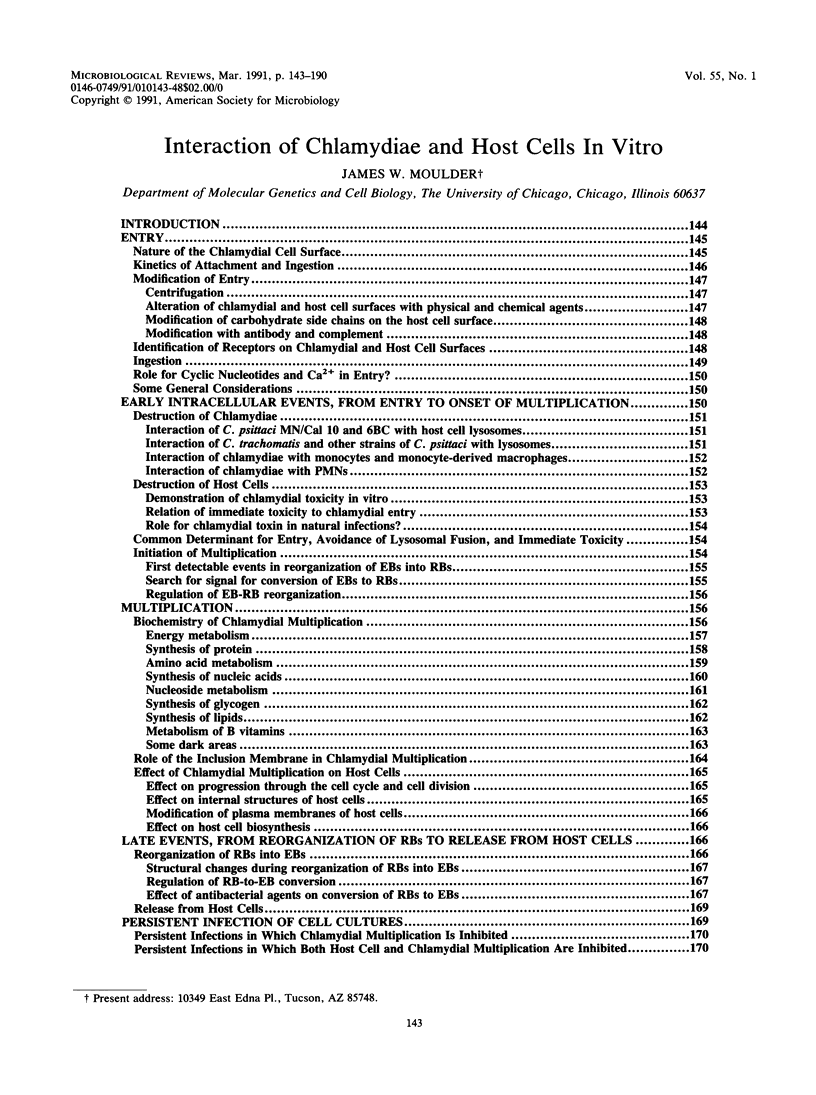
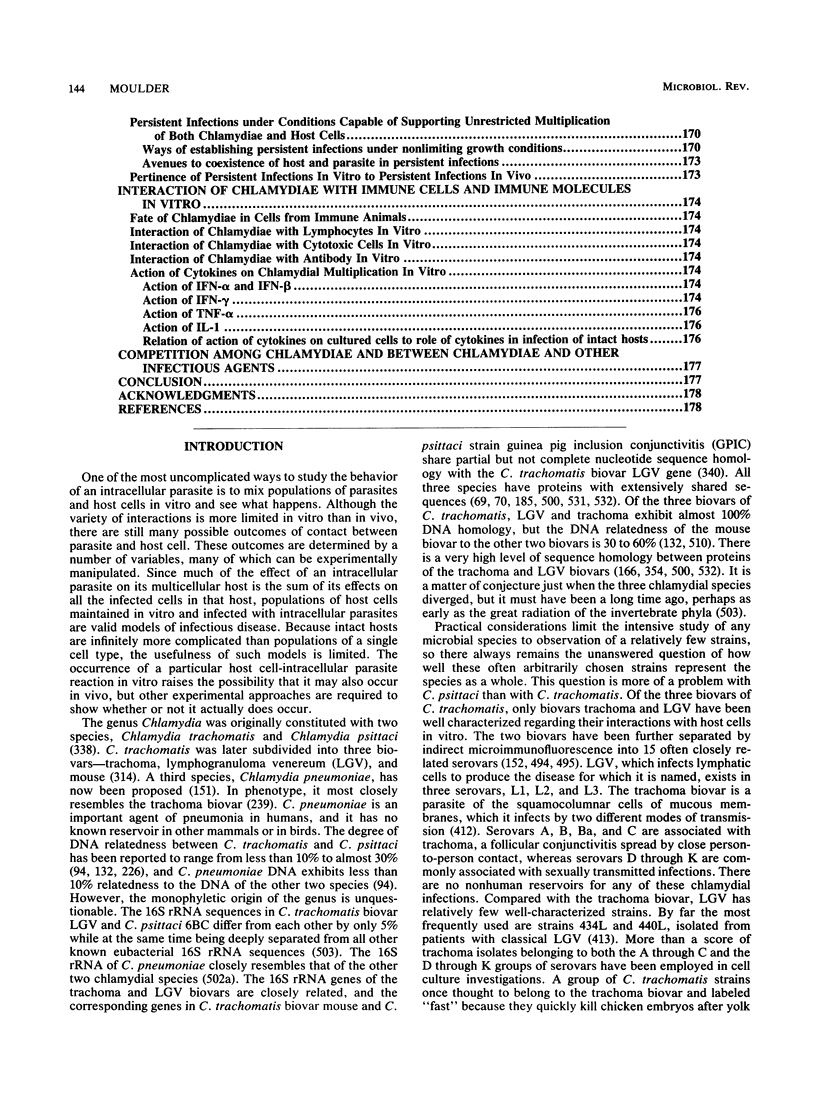
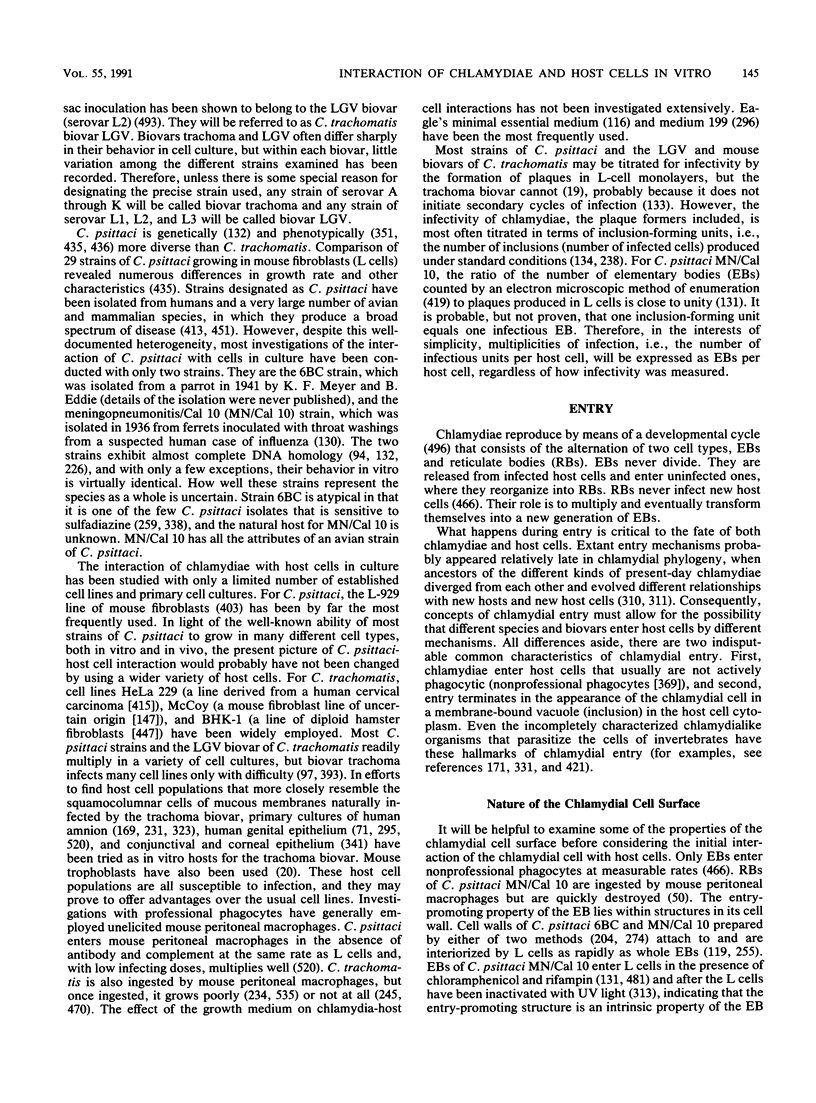
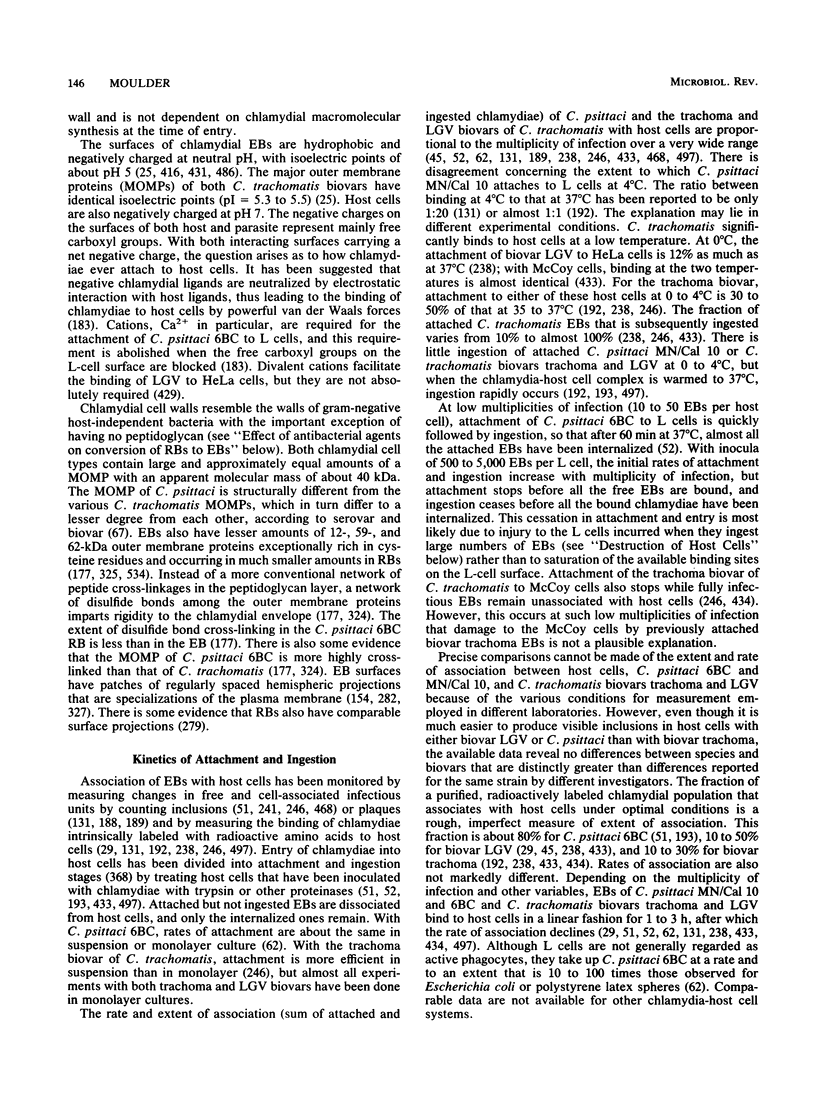
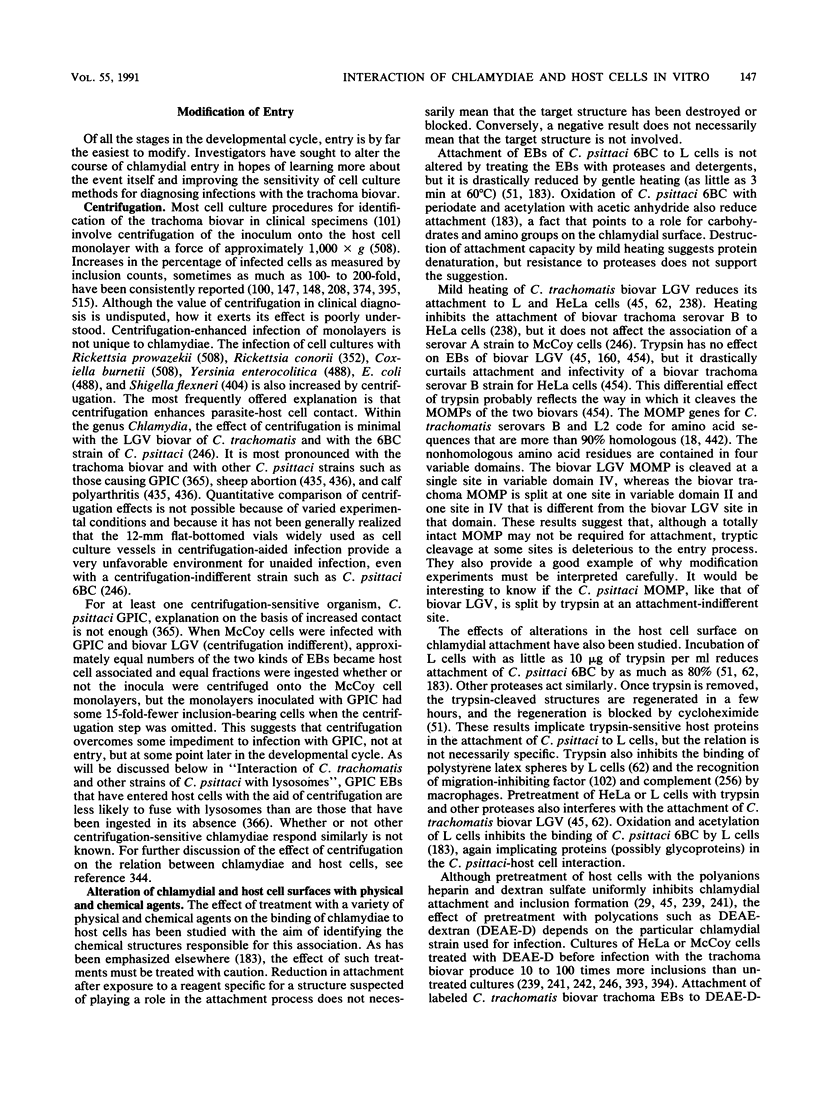
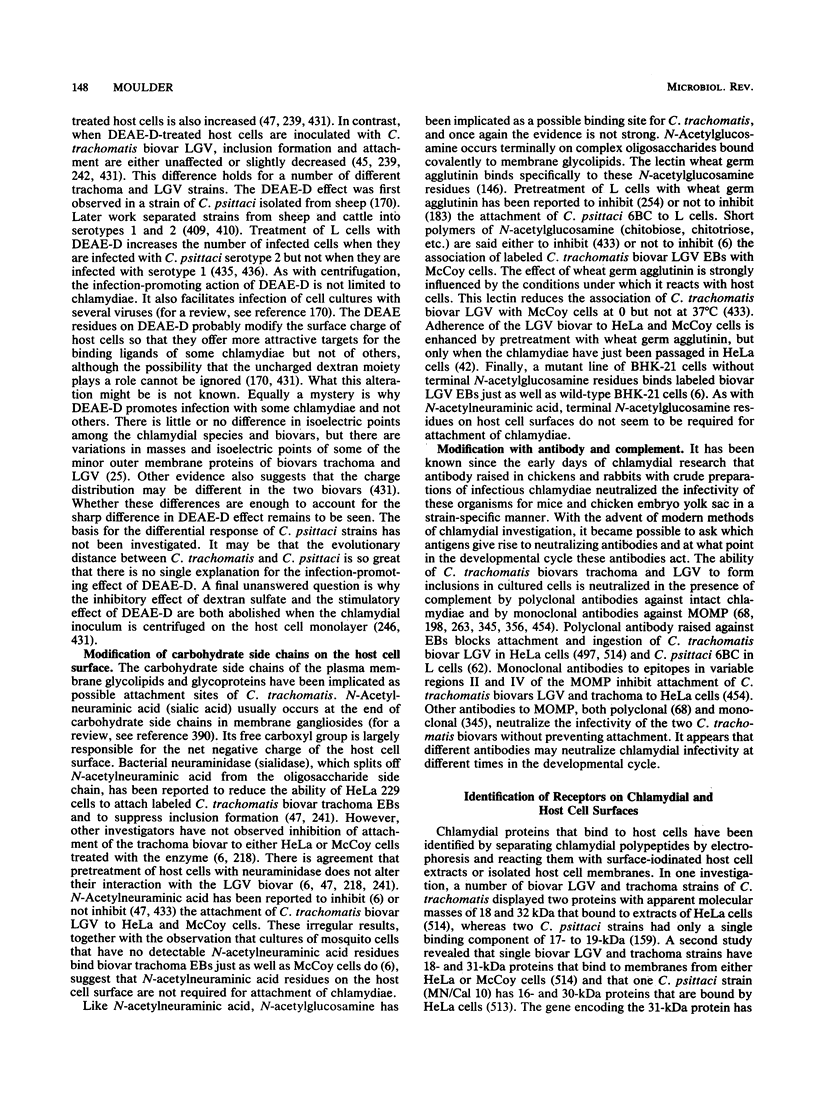


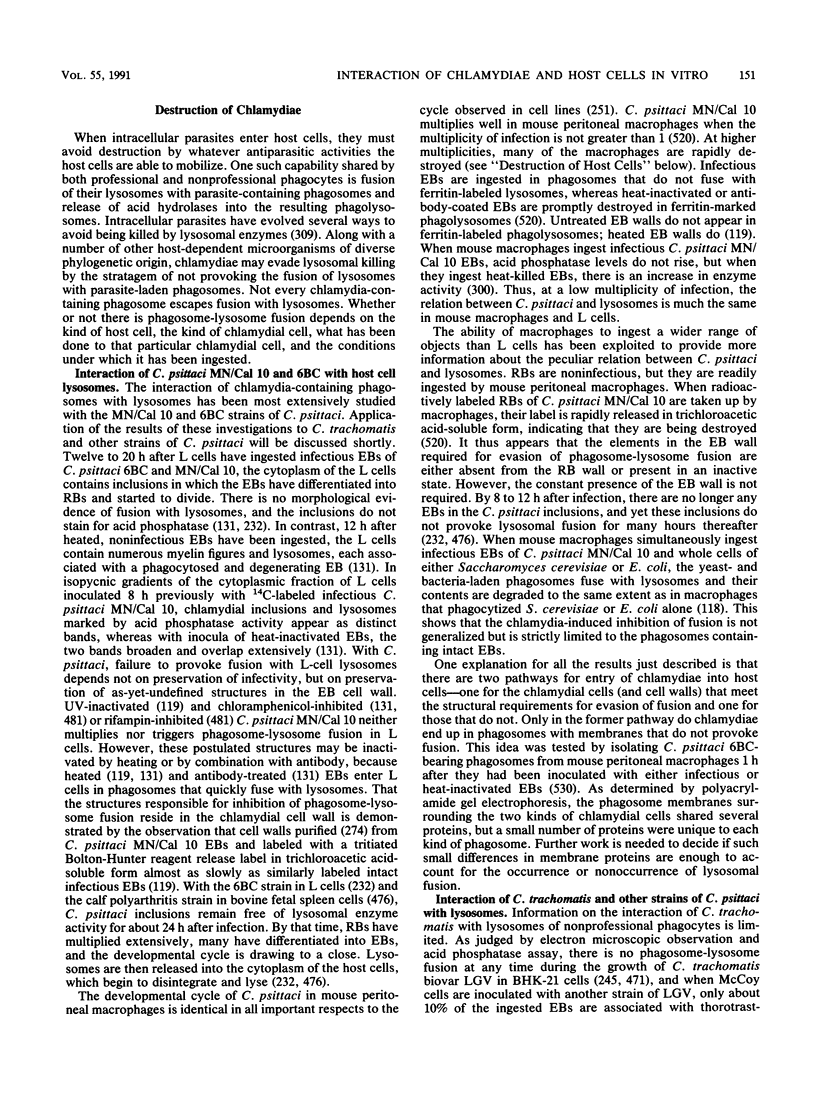

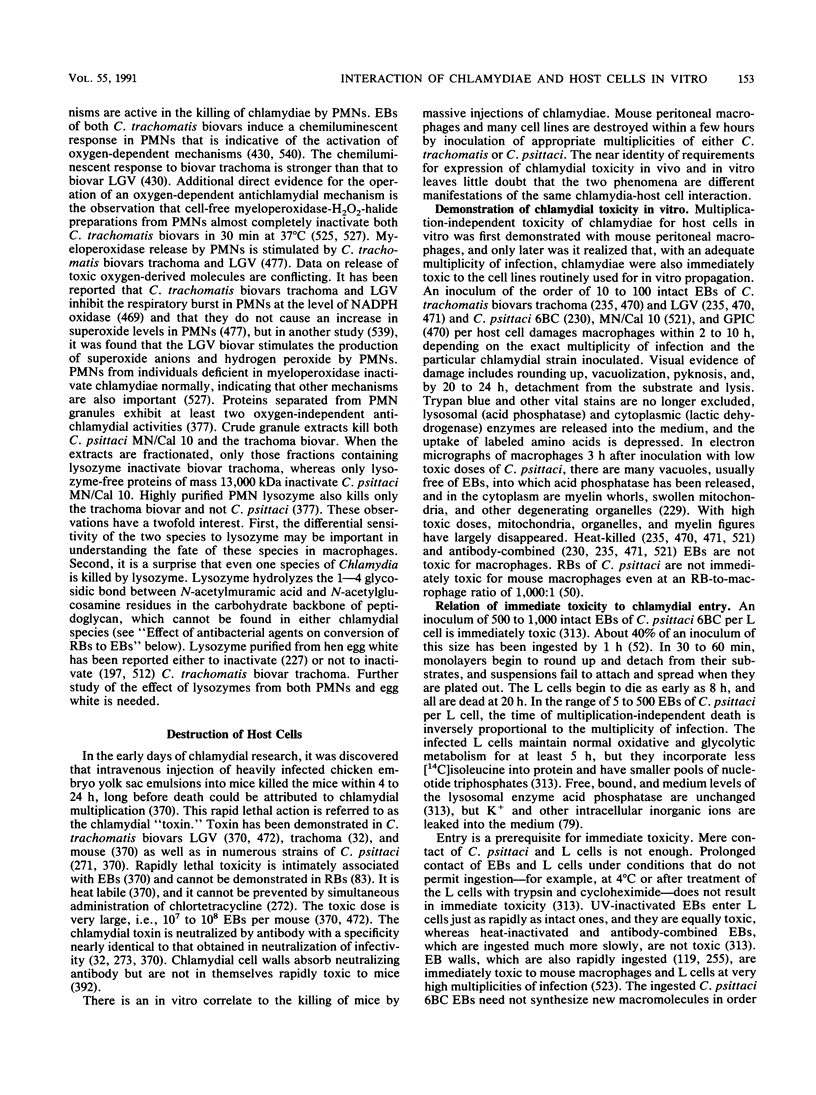
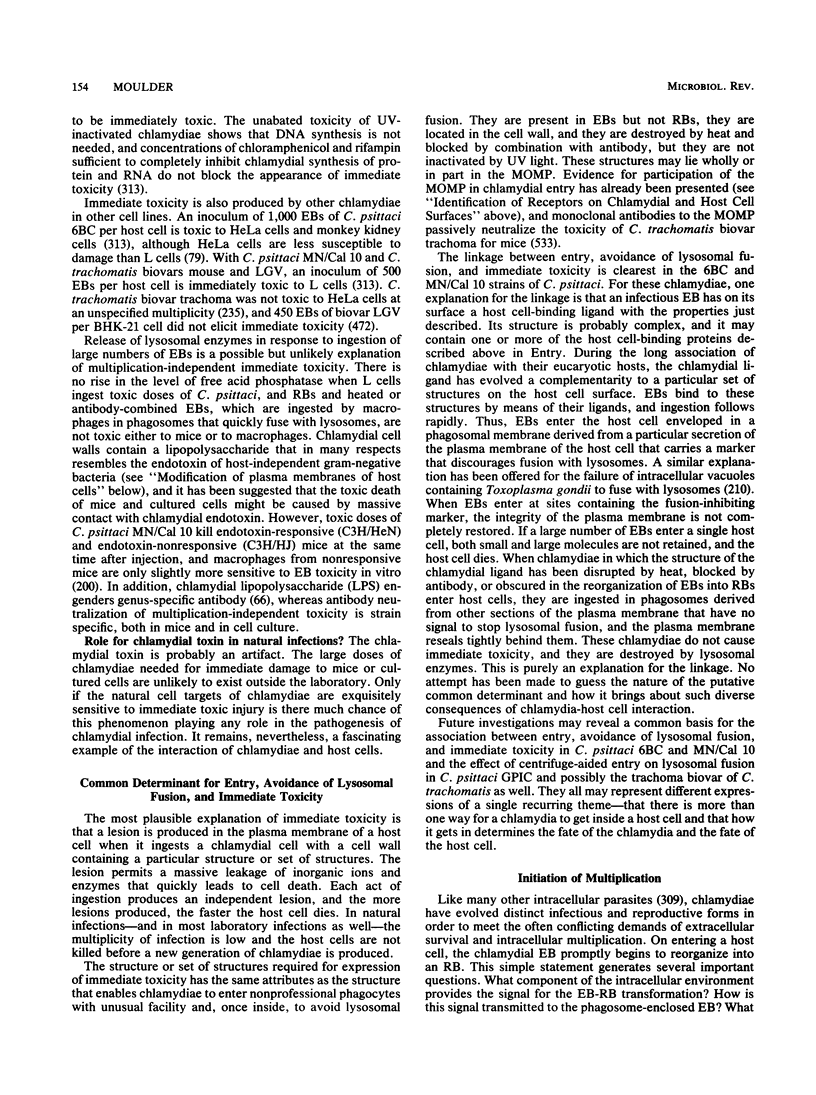
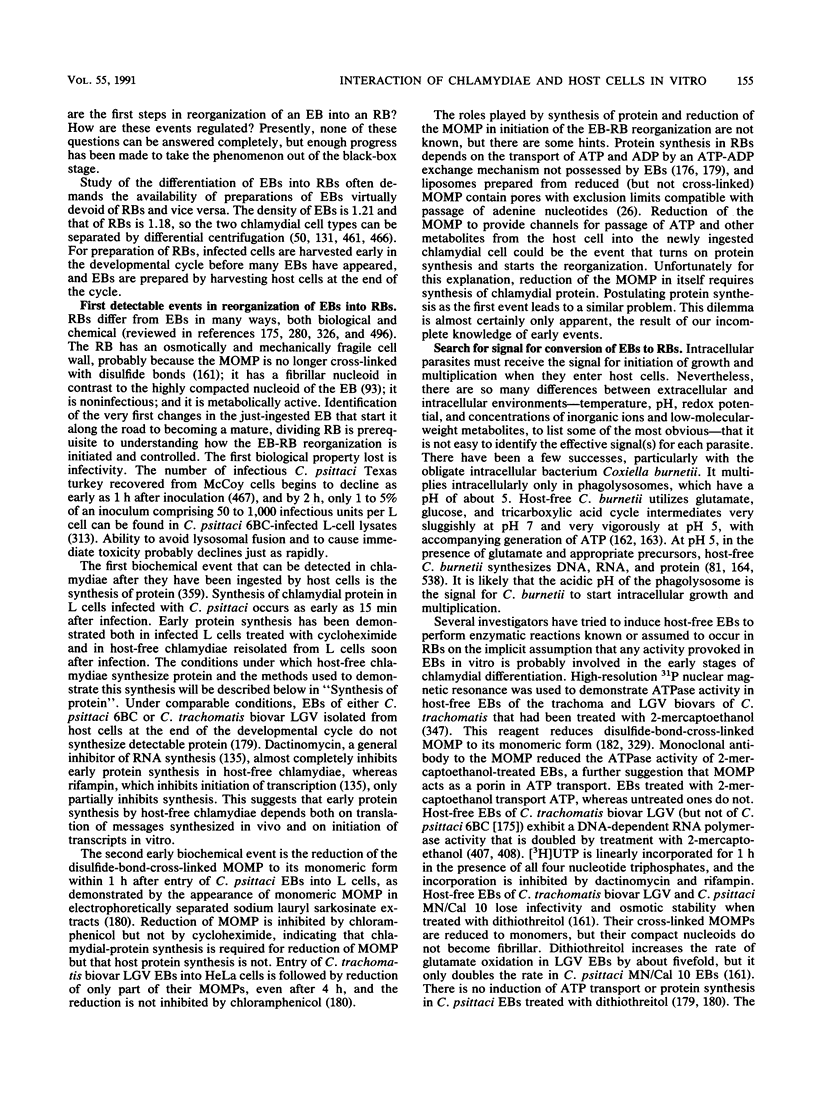
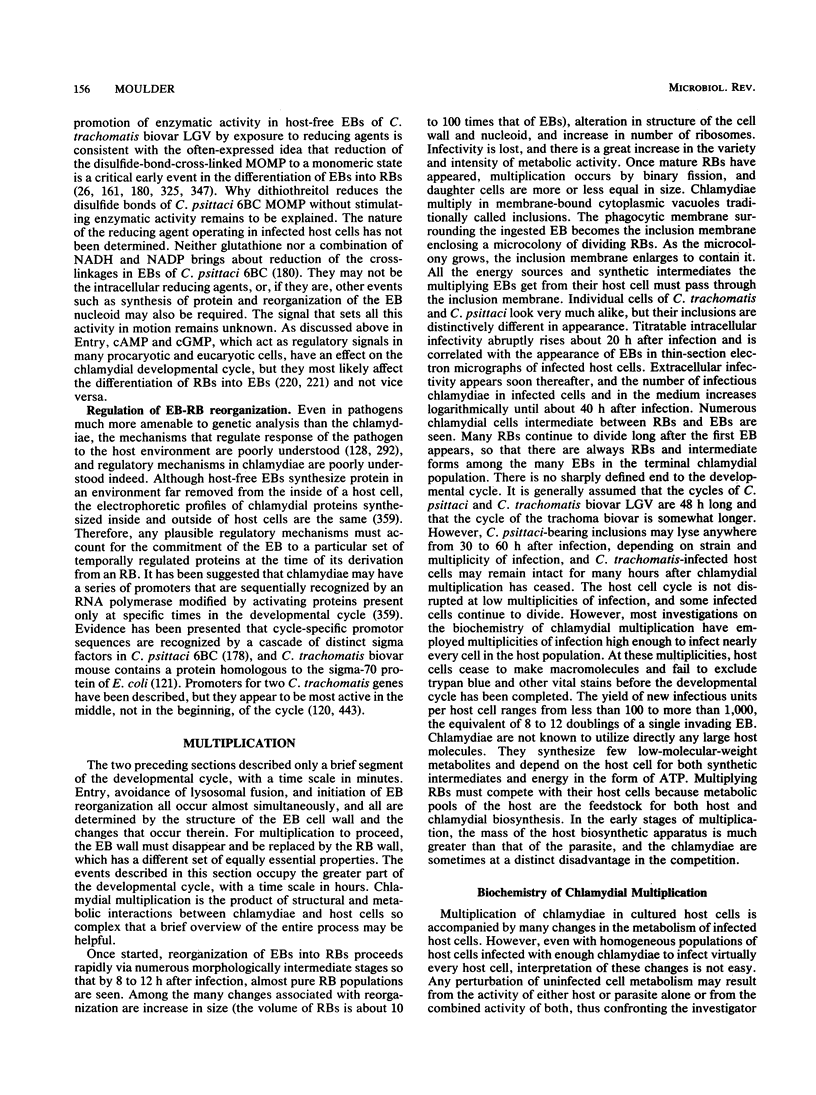
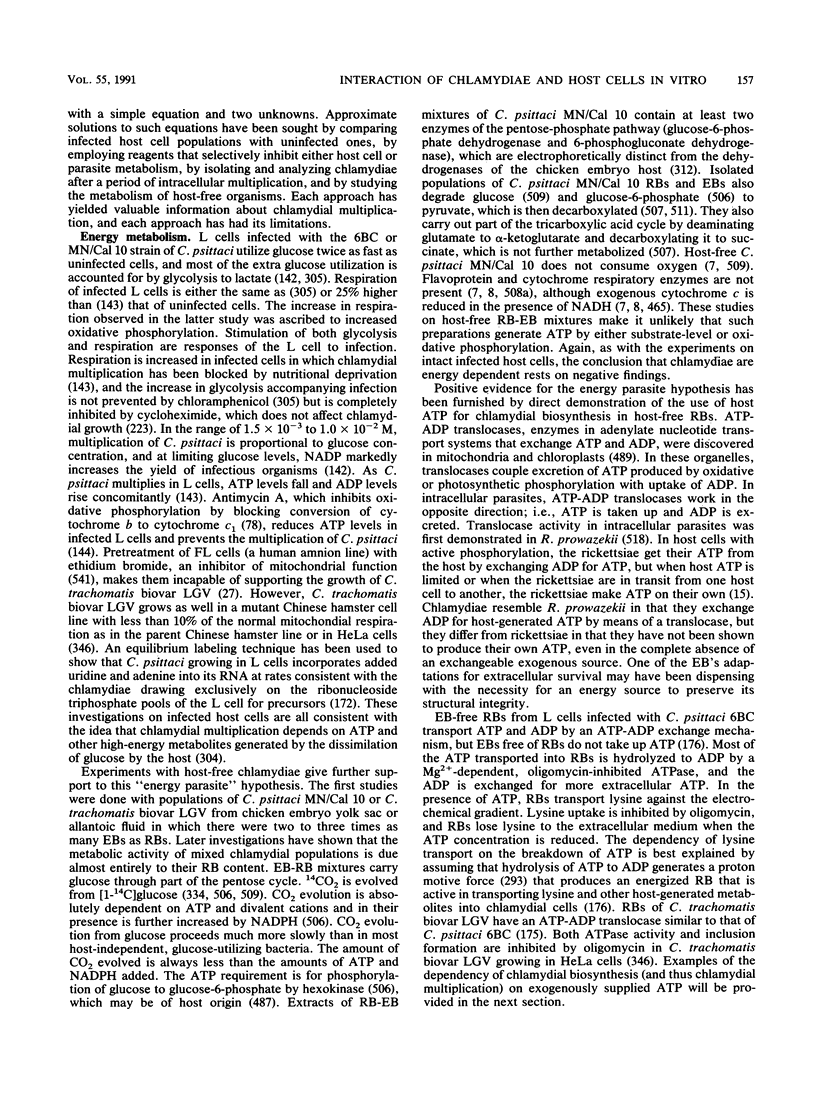




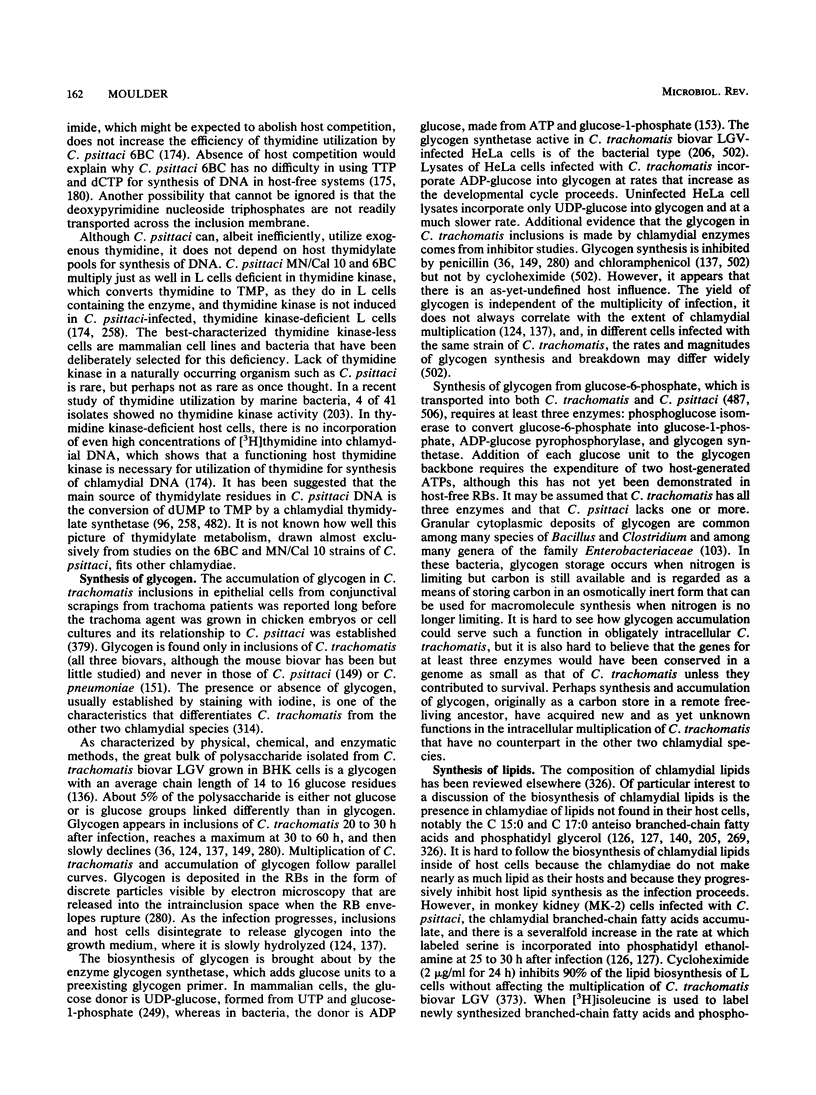

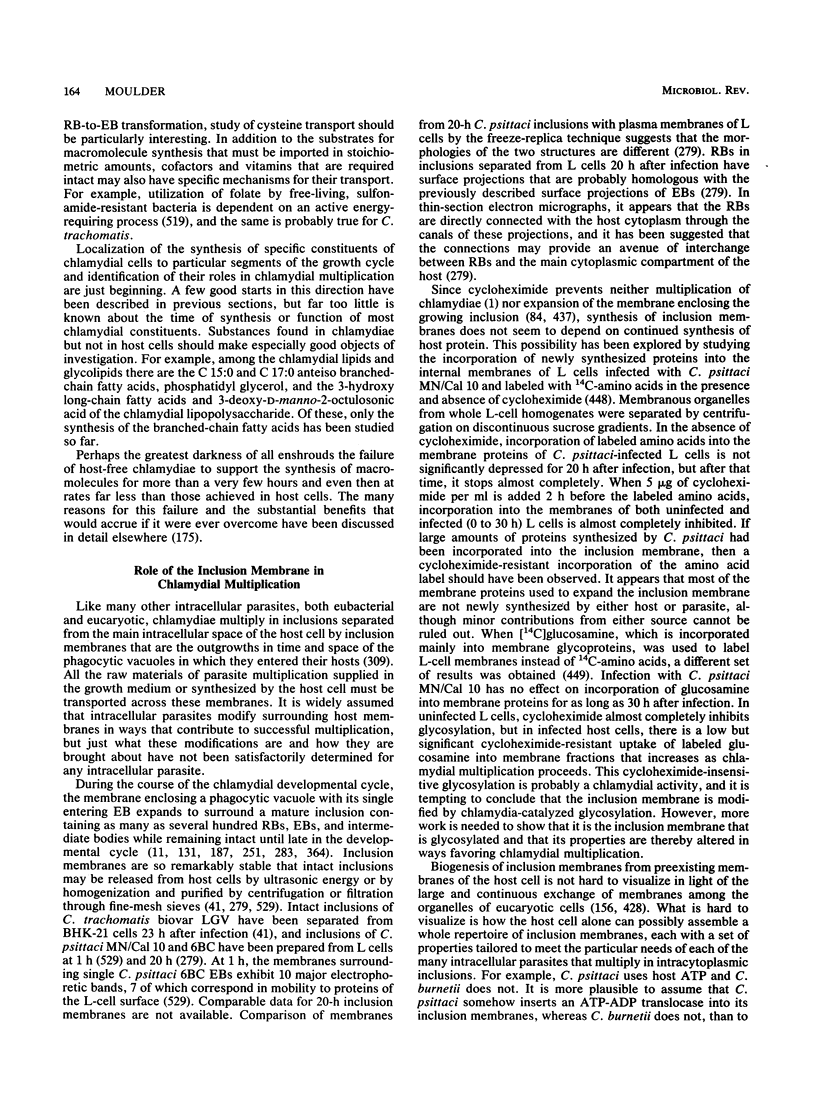
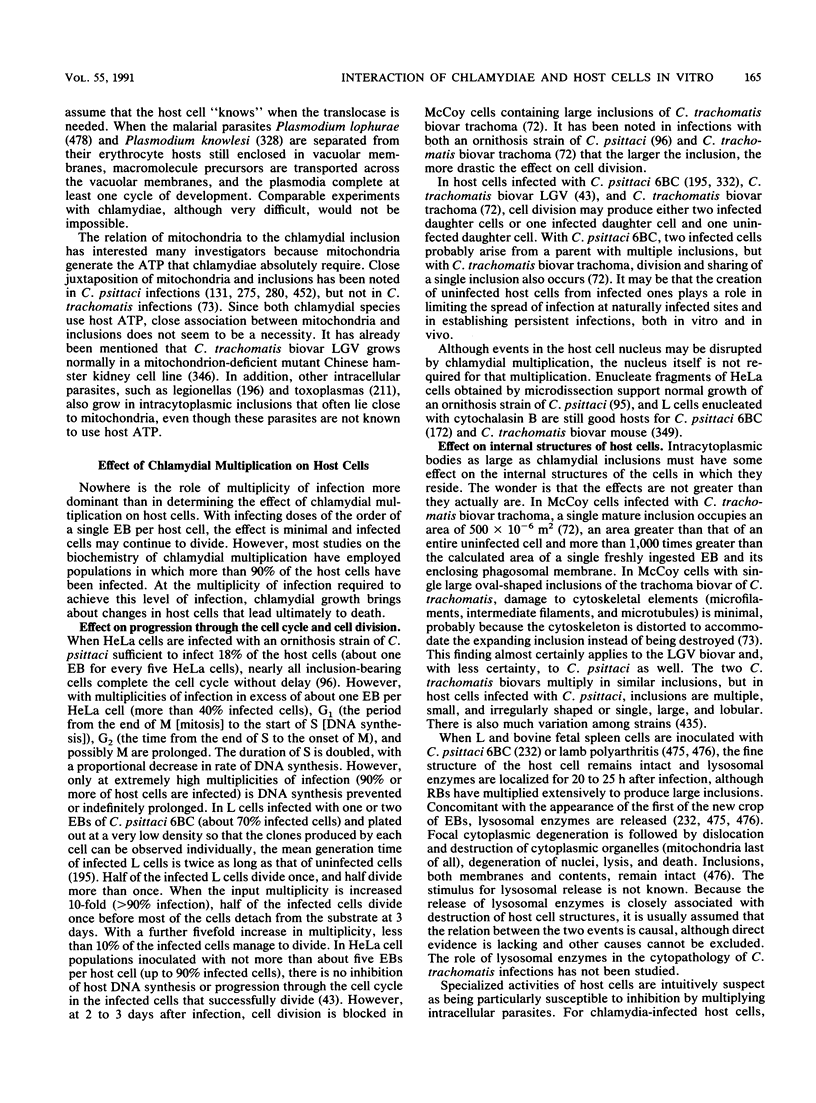
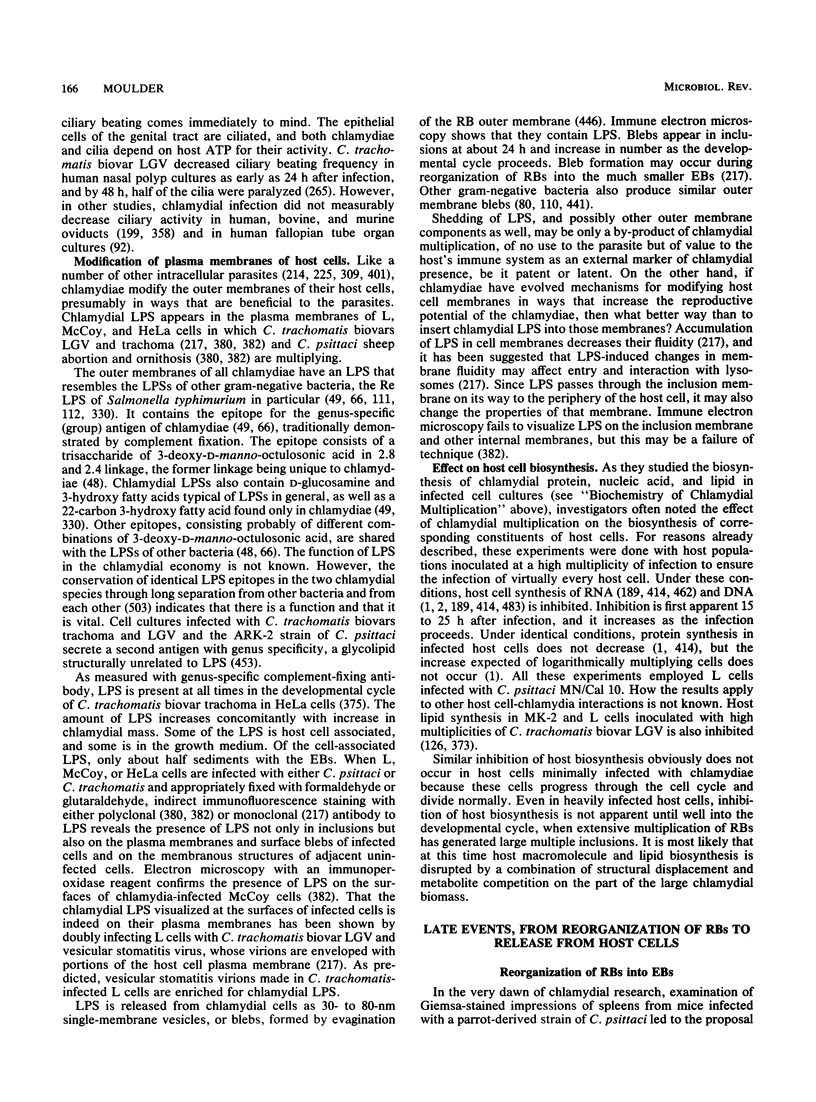
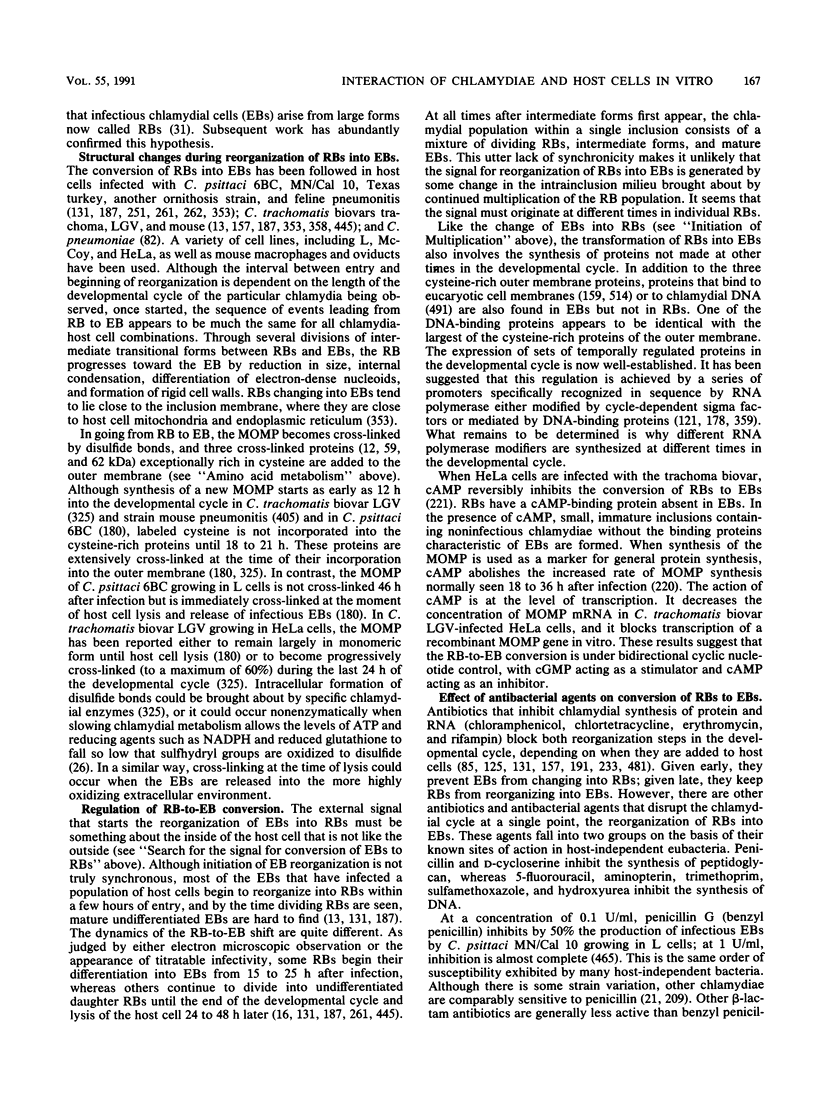
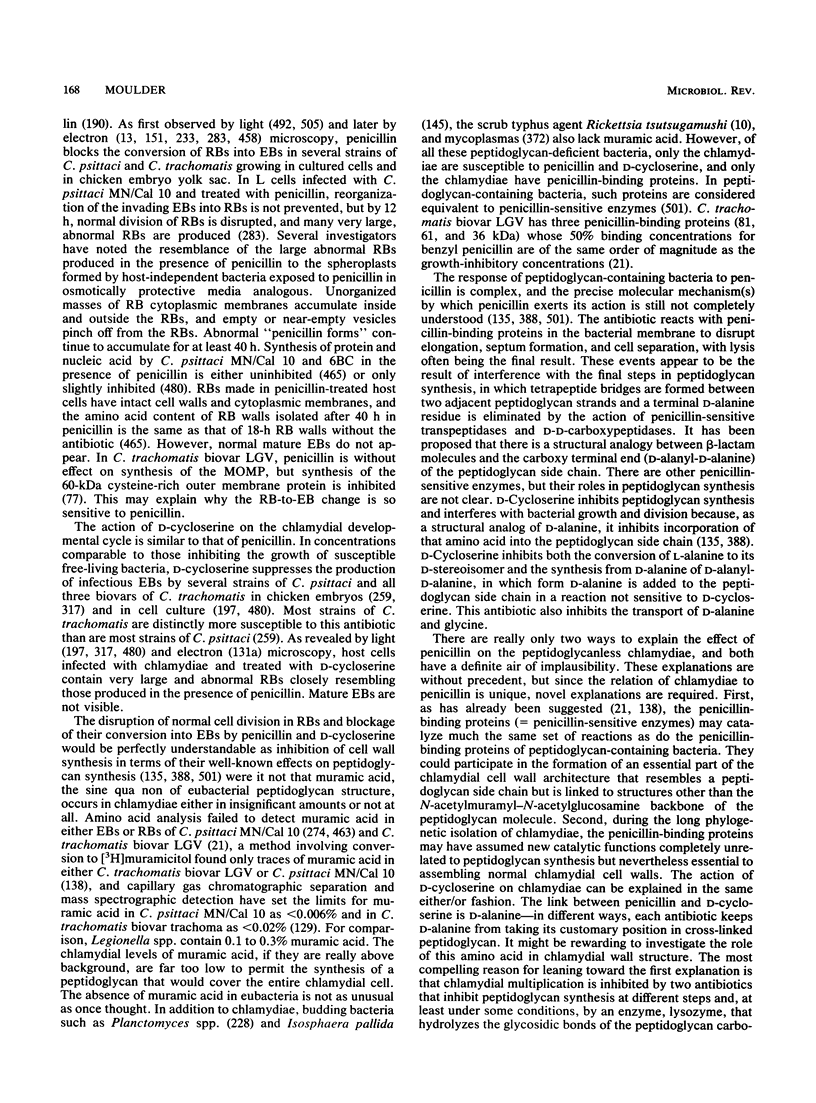

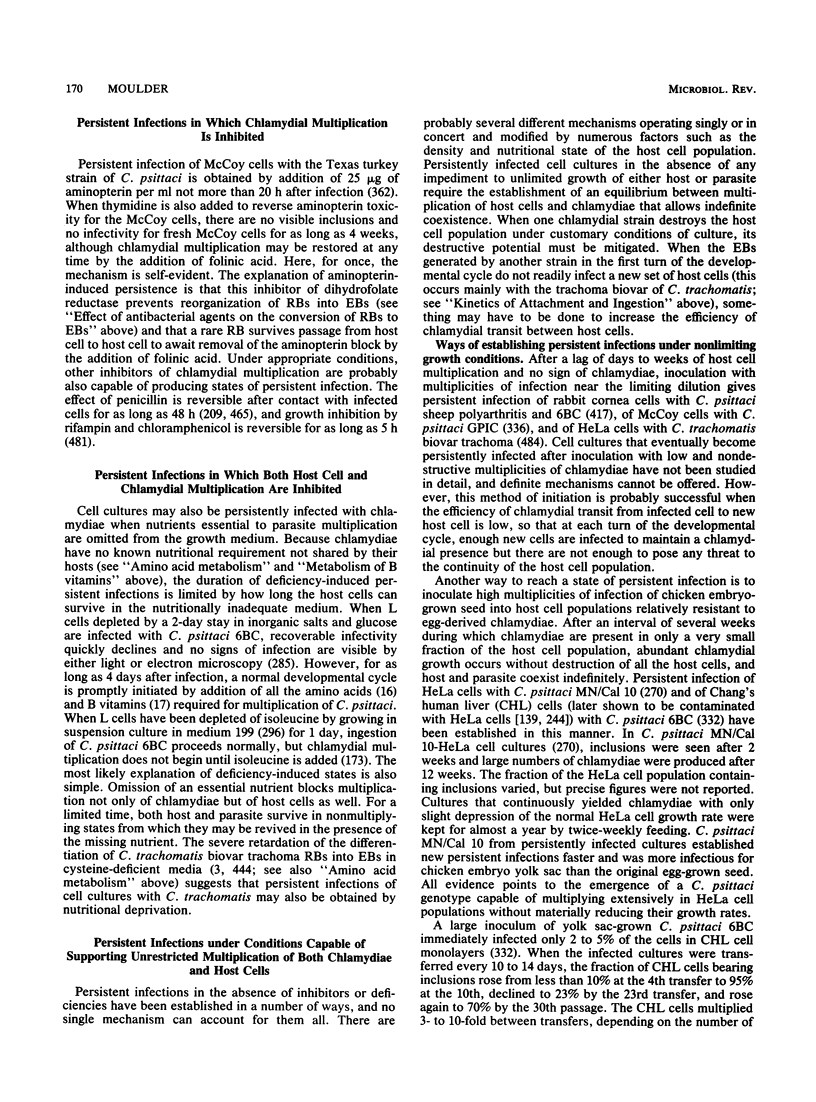







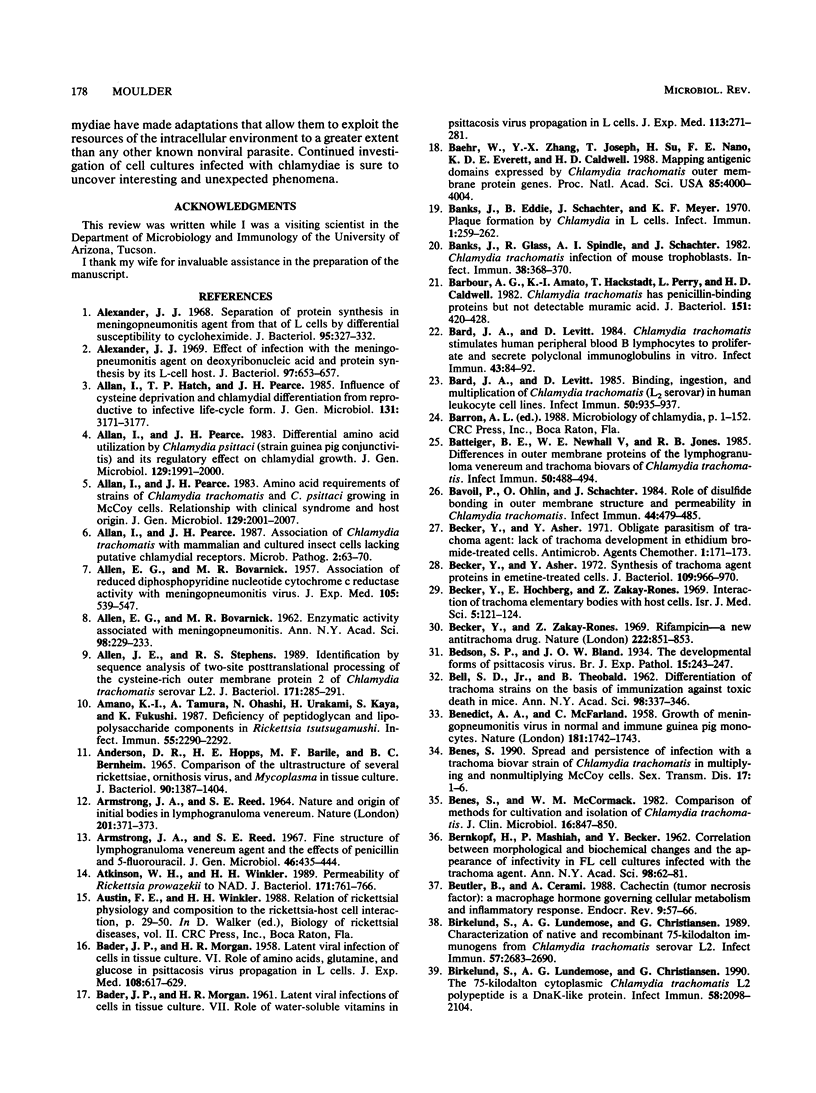
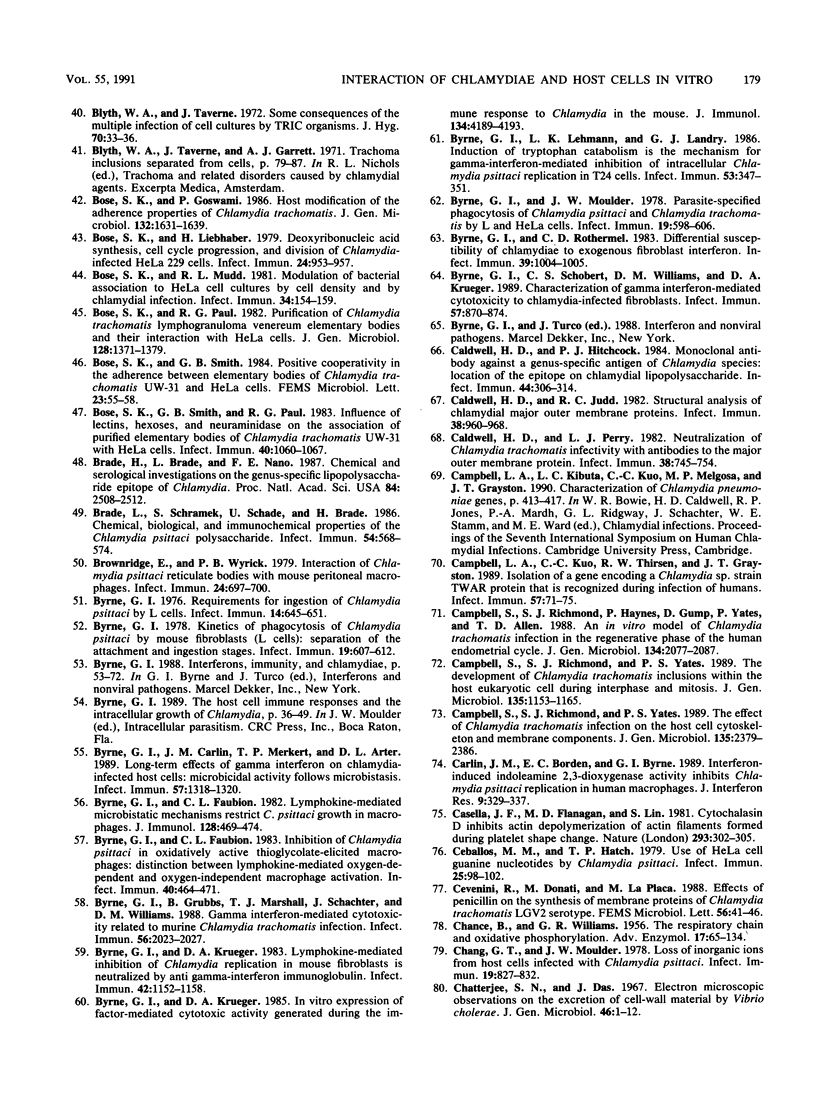

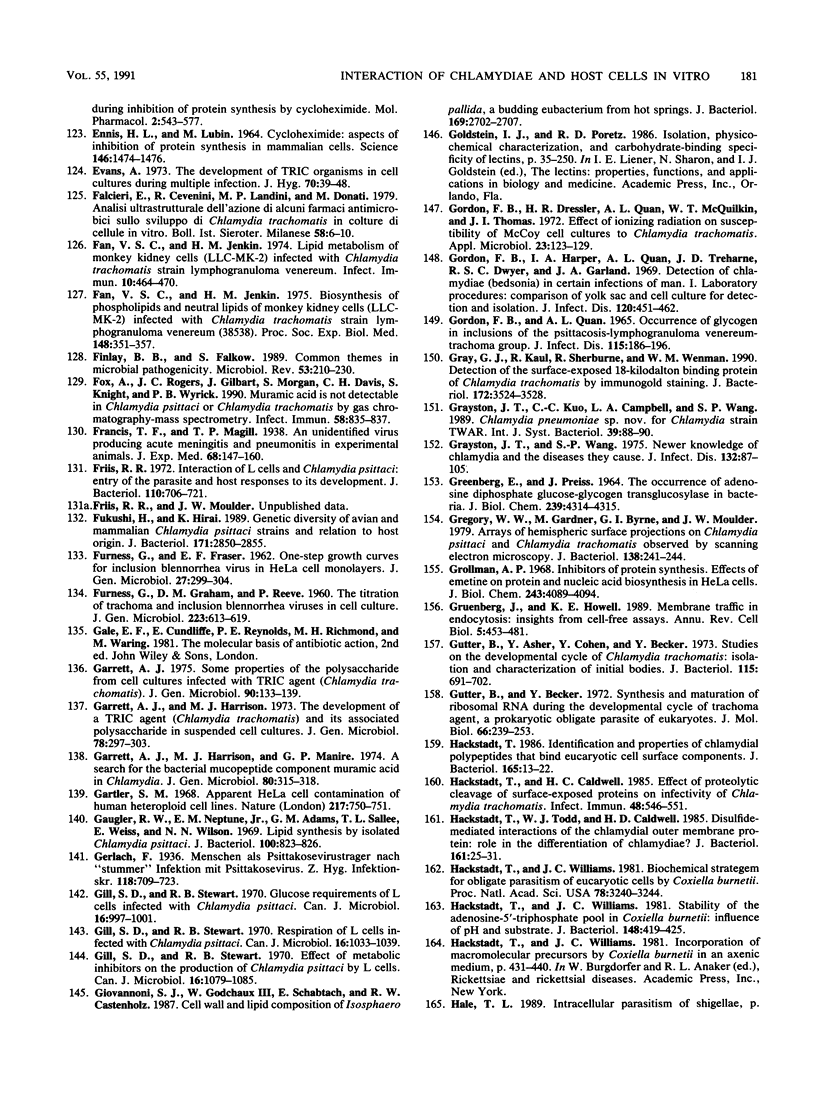

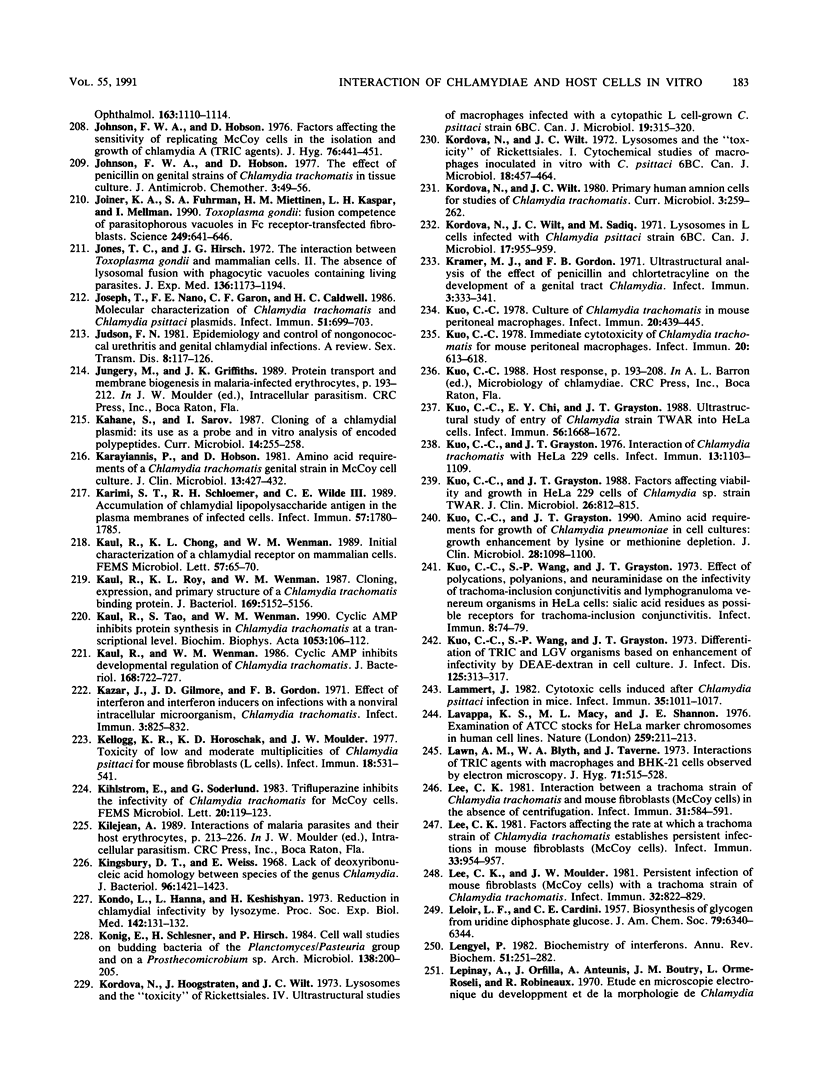
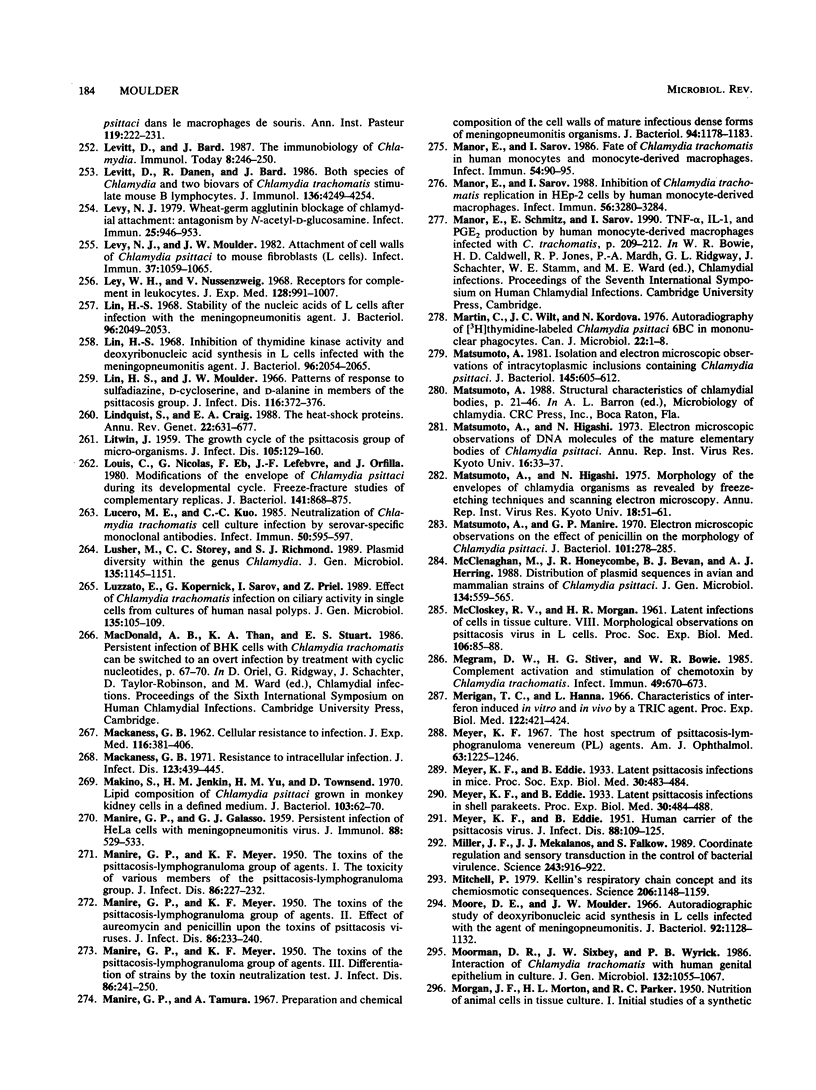
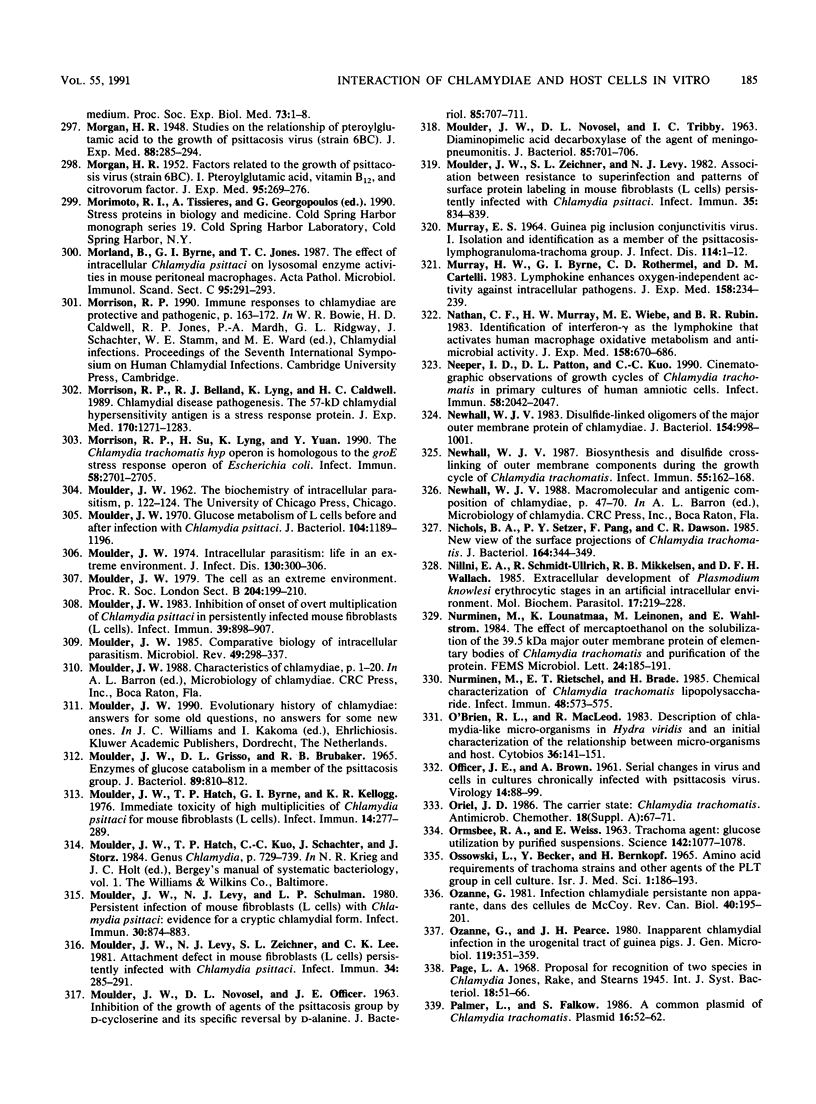

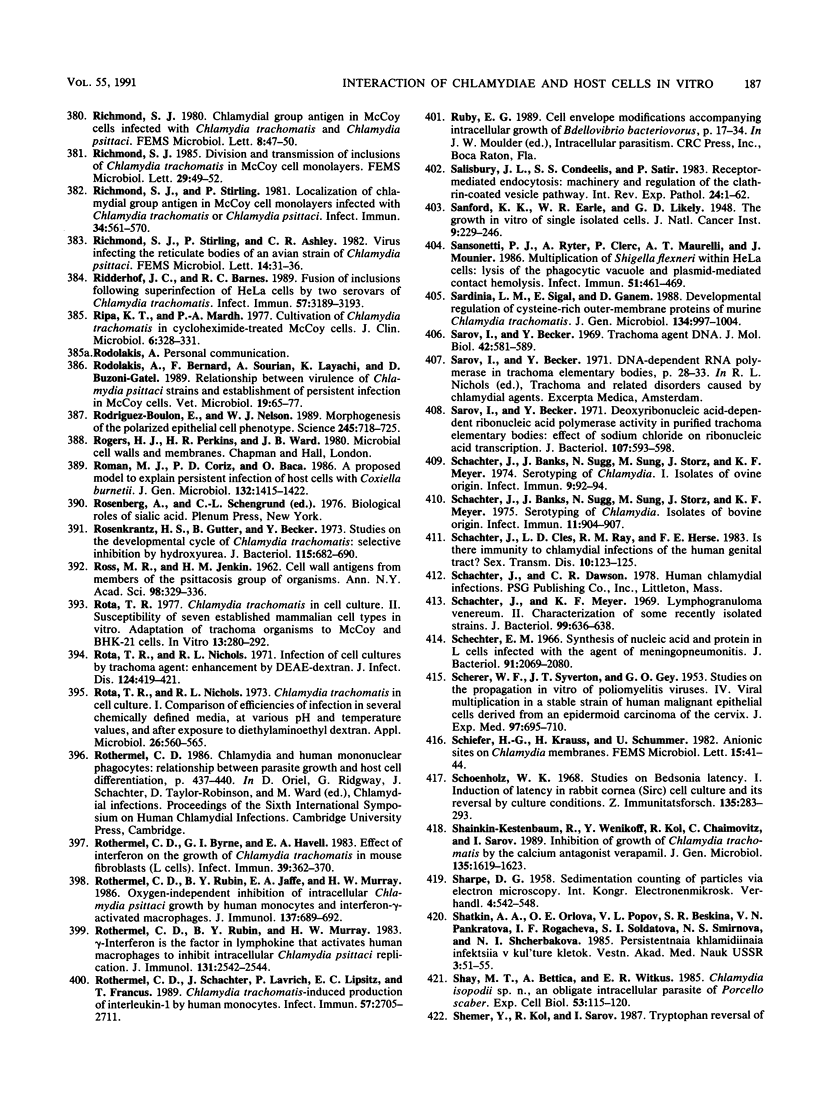

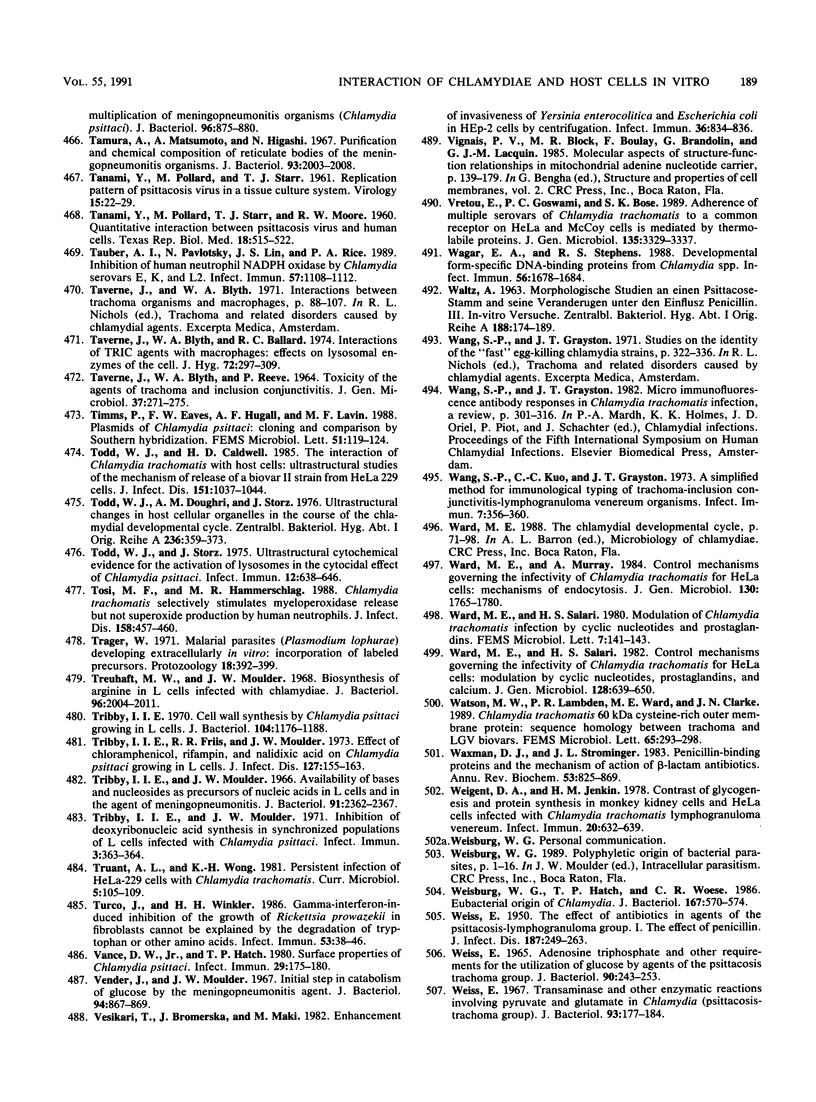
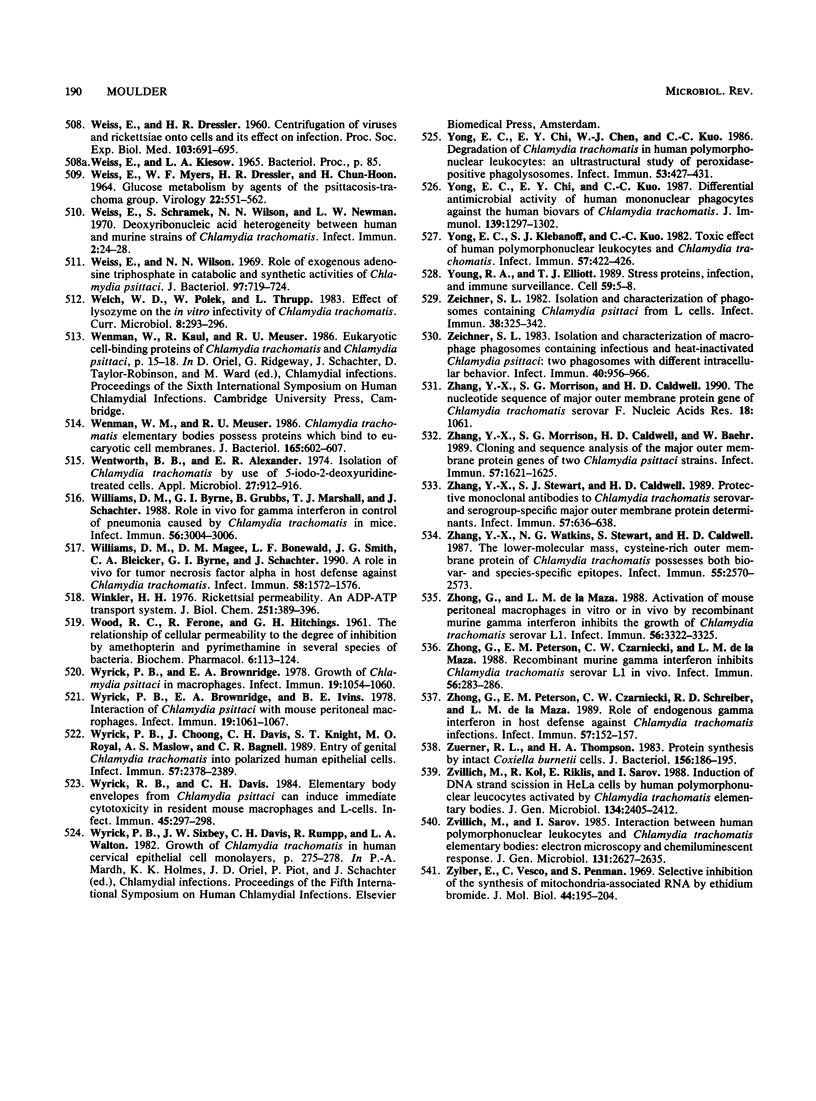
Selected References
These references are in PubMed. This may not be the complete list of references from this article.
- ALLEN E. G., BOVARNICK M. R. Association of reduced diphosphopyridine nucleotide cytochrome c reductase activity with meningopneumonitis virus. J Exp Med. 1957 Jun 1;105(6):539–547. doi: 10.1084/jem.105.6.539. [DOI] [PMC free article] [PubMed] [Google Scholar]
- ALLEN E. G., BOVARNICK M. R. Enzymatic activity associated with meningopneumonitis. Ann N Y Acad Sci. 1962 Mar 5;98:229–233. doi: 10.1111/j.1749-6632.1962.tb30547.x. [DOI] [PubMed] [Google Scholar]
- ARMSTRONG J. A., REED S. E. NATURE AND ORIGIN OF INITIAL BODIES IN LYMPHOGRANULOMA VENEREUM. Nature. 1964 Jan 25;201:371–373. doi: 10.1038/201371a0. [DOI] [PubMed] [Google Scholar]
- Alexander J. J. Effect of infection with the meningopneumonitis agent on deoxyribonucleic acid and protein synthesis by its L-cell host. J Bacteriol. 1969 Feb;97(2):653–657. doi: 10.1128/jb.97.2.653-657.1969. [DOI] [PMC free article] [PubMed] [Google Scholar]
- Alexander J. J. Separation of protein synthesis in meningopneumonitisgent from that in L cells by differential susceptibility to cycloheximide. J Bacteriol. 1968 Feb;95(2):327–332. doi: 10.1128/jb.95.2.327-332.1968. [DOI] [PMC free article] [PubMed] [Google Scholar]
- Allan I., Hatch T. P., Pearce J. H. Influence of cysteine deprivation on chlamydial differentiation from reproductive to infective life-cycle forms. J Gen Microbiol. 1985 Dec;131(12):3171–3177. doi: 10.1099/00221287-131-12-3171. [DOI] [PubMed] [Google Scholar]
- Allan I., Pearce J. H. Amino acid requirements of strains of Chlamydia trachomatis and C. psittaci growing in McCoy cells: relationship with clinical syndrome and host origin. J Gen Microbiol. 1983 Jul;129(7):2001–2007. doi: 10.1099/00221287-129-7-2001. [DOI] [PubMed] [Google Scholar]
- Allan I., Pearce J. H. Association of Chlamydia trachomatis with mammalian and cultured insect cells lacking putative chlamydial receptors. Microb Pathog. 1987 Jan;2(1):63–70. doi: 10.1016/0882-4010(87)90115-x. [DOI] [PubMed] [Google Scholar]
- Allan I., Pearce J. H. Differential amino acid utilization by Chlamydia psittaci (strain guinea pig inclusion conjunctivitis) and its regulatory effect on chlamydial growth. J Gen Microbiol. 1983 Jul;129(7):1991–2000. doi: 10.1099/00221287-129-7-1991. [DOI] [PubMed] [Google Scholar]
- Allen J. E., Stephens R. S. Identification by sequence analysis of two-site posttranslational processing of the cysteine-rich outer membrane protein 2 of Chlamydia trachomatis serovar L2. J Bacteriol. 1989 Jan;171(1):285–291. doi: 10.1128/jb.171.1.285-291.1989. [DOI] [PMC free article] [PubMed] [Google Scholar]
- Amano K., Tamura A., Ohashi N., Urakami H., Kaya S., Fukushi K. Deficiency of peptidoglycan and lipopolysaccharide components in Rickettsia tsutsugamushi. Infect Immun. 1987 Sep;55(9):2290–2292. doi: 10.1128/iai.55.9.2290-2292.1987. [DOI] [PMC free article] [PubMed] [Google Scholar]
- Anderson D. R., Hopps H. E., Barile M. F., Bernheim B. C. Comparison of the ultrastructure of several rickettsiae, ornithosis virus, and Mycoplasma in tissue culture. J Bacteriol. 1965 Nov;90(5):1387–1404. doi: 10.1128/jb.90.5.1387-1404.1965. [DOI] [PMC free article] [PubMed] [Google Scholar]
- Atkinson W. H., Winkler H. H. Permeability of Rickettsia prowazekii to NAD. J Bacteriol. 1989 Feb;171(2):761–766. doi: 10.1128/jb.171.2.761-766.1989. [DOI] [PMC free article] [PubMed] [Google Scholar]
- BADER J. P., MORGAN H. R. Latent viral infection of cells in tissue culture. VI. Role of amino acids, glutamine, and glucose in psittacosis virus propagation in L cells. J Exp Med. 1958 Nov 1;108(5):617–630. doi: 10.1084/jem.108.5.617. [DOI] [PMC free article] [PubMed] [Google Scholar]
- BADER J. P., MORGAN H. R. Latent viral infection of cells in tissue culture. VII. Role of water-soluble vitamins in psittacosis virus propagation in L cells. J Exp Med. 1961 Feb 1;113:271–281. doi: 10.1084/jem.113.2.271. [DOI] [PMC free article] [PubMed] [Google Scholar]
- BELL S. D., Jr, THEOBALD B. Differentiation of trachoma strains on the basis of immunization against toxic death of mice. Ann N Y Acad Sci. 1962 Mar 5;98:337–346. doi: 10.1111/j.1749-6632.1962.tb30556.x. [DOI] [PubMed] [Google Scholar]
- BENEDICT A. A., McFARLAND C. Growth of meningopneumonitis virus in normal and immune guinea pig monocytes. Nature. 1958 Jun 21;181(4625):1742–1743. doi: 10.1038/1811742a0. [DOI] [PubMed] [Google Scholar]
- BERNKOPF H., MASHIAH P., BECKER Y. Correlation between morphological and biochemical changes and the appearance of infectivity in FL cell cultures infected with trachoma agent. Ann N Y Acad Sci. 1962 Mar 5;98:62–81. doi: 10.1111/j.1749-6632.1962.tb30532.x. [DOI] [PubMed] [Google Scholar]
- Baehr W., Zhang Y. X., Joseph T., Su H., Nano F. E., Everett K. D., Caldwell H. D. Mapping antigenic domains expressed by Chlamydia trachomatis major outer membrane protein genes. Proc Natl Acad Sci U S A. 1988 Jun;85(11):4000–4004. doi: 10.1073/pnas.85.11.4000. [DOI] [PMC free article] [PubMed] [Google Scholar]
- Banks J., Eddie B., Schachter J., Meyer K. F. Plaque formation by Chlamydia in L cells. Infect Immun. 1970 Mar;1(3):259–262. doi: 10.1128/iai.1.3.259-262.1970. [DOI] [PMC free article] [PubMed] [Google Scholar]
- Banks J., Glass R., Spindle A. I., Schachter J. Chlamydia trachomatis infection of mouse trophoblasts. Infect Immun. 1982 Oct;38(1):368–370. doi: 10.1128/iai.38.1.368-370.1982. [DOI] [PMC free article] [PubMed] [Google Scholar]
- Barbour A. G., Amano K., Hackstadt T., Perry L., Caldwell H. D. Chlamydia trachomatis has penicillin-binding proteins but not detectable muramic acid. J Bacteriol. 1982 Jul;151(1):420–428. doi: 10.1128/jb.151.1.420-428.1982. [DOI] [PMC free article] [PubMed] [Google Scholar]
- Bard J. A., Levitt D. Binding, ingestion, and multiplication of Chlamydia trachomatis (L2 serovar) in human leukocyte cell lines. Infect Immun. 1985 Dec;50(3):935–937. doi: 10.1128/iai.50.3.935-937.1985. [DOI] [PMC free article] [PubMed] [Google Scholar]
- Bard J., Levitt D. Chlamydia trachomatis stimulates human peripheral blood B lymphocytes to proliferate and secrete polyclonal immunoglobulins in vitro. Infect Immun. 1984 Jan;43(1):84–92. doi: 10.1128/iai.43.1.84-92.1984. [DOI] [PMC free article] [PubMed] [Google Scholar]
- Batteiger B. E., Newhall W. J., 5th, Jones R. B. Differences in outer membrane proteins of the lymphogranuloma venereum and trachoma biovars of Chlamydia trachomatis. Infect Immun. 1985 Nov;50(2):488–494. doi: 10.1128/iai.50.2.488-494.1985. [DOI] [PMC free article] [PubMed] [Google Scholar]
- Bavoil P., Ohlin A., Schachter J. Role of disulfide bonding in outer membrane structure and permeability in Chlamydia trachomatis. Infect Immun. 1984 May;44(2):479–485. doi: 10.1128/iai.44.2.479-485.1984. [DOI] [PMC free article] [PubMed] [Google Scholar]
- Becker Y., Asher Y. Obligate parasitism of trachoma agent: lack of trachoma development in ethidium bromide-treated cells. Antimicrob Agents Chemother. 1972 Feb;1(2):171–173. doi: 10.1128/aac.1.2.171. [DOI] [PMC free article] [PubMed] [Google Scholar]
- Becker Y., Asher Y. Synthesis of trachoma agent proteins in emetine-treated cells. J Bacteriol. 1972 Mar;109(3):966–970. doi: 10.1128/jb.109.3.966-970.1972. [DOI] [PMC free article] [PubMed] [Google Scholar]
- Becker Y., Hochberg E., Zakay-Rones Z. Interaction of trachoma elementary bodies with host cells. Isr J Med Sci. 1969 Jan-Feb;5(1):121–124. [PubMed] [Google Scholar]
- Becker Y., Zakay-Rones Z. Rifampicin--a new antitrachoma drug. Nature. 1969 May 31;222(5196):851–853. doi: 10.1038/222851a0. [DOI] [PubMed] [Google Scholar]
- Benes S., McCormack W. M. Comparison of methods for cultivation and isolation of Chlamydia trachomatis. J Clin Microbiol. 1982 Nov;16(5):847–850. doi: 10.1128/jcm.16.5.847-850.1982. [DOI] [PMC free article] [PubMed] [Google Scholar]
- Benes S. Spread and persistence of infection with a trachoma biovar strain of Chlamydia trachomatis in multiplying and nonmultiplying McCoy cells. Sex Transm Dis. 1990 Jan-Mar;17(1):1–6. [PubMed] [Google Scholar]
- Beutler B., Cerami A. Cachectin (tumor necrosis factor): a macrophage hormone governing cellular metabolism and inflammatory response. Endocr Rev. 1988 Feb;9(1):57–66. doi: 10.1210/edrv-9-1-57. [DOI] [PubMed] [Google Scholar]
- Birkelund S., Lundemose A. G., Christiansen G. Characterization of native and recombinant 75-kilodalton immunogens from Chlamydia trachomatis serovar L2. Infect Immun. 1989 Sep;57(9):2683–2690. doi: 10.1128/iai.57.9.2683-2690.1989. [DOI] [PMC free article] [PubMed] [Google Scholar]
- Birkelund S., Lundemose A. G., Christiansen G. The 75-kilodalton cytoplasmic Chlamydia trachomatis L2 polypeptide is a DnaK-like protein. Infect Immun. 1990 Jul;58(7):2098–2104. doi: 10.1128/iai.58.7.2098-2104.1990. [DOI] [PMC free article] [PubMed] [Google Scholar]
- Blyth W. A., Taverne J. Some consequences of the multiple infection of cell cultures by TRIC organisms. J Hyg (Lond) 1972 Mar;70(1):33–37. doi: 10.1017/s0022172400022063. [DOI] [PMC free article] [PubMed] [Google Scholar]
- Bose S. K., Goswami P. C. Host modification of the adherence properties of Chlamydia trachomatis. J Gen Microbiol. 1986 Jun;132(6):1631–1639. doi: 10.1099/00221287-132-6-1631. [DOI] [PubMed] [Google Scholar]
- Bose S. K., Liebhaber H. Deoxyribonucleic acid synthesis, cell cycle progression, and division of Chlamydia-infected HeLa 229 cells. Infect Immun. 1979 Jun;24(3):953–957. doi: 10.1128/iai.24.3.953-957.1979. [DOI] [PMC free article] [PubMed] [Google Scholar]
- Bose S. K., Mudd R. L. Modulation of bacterial association to HeLa cell cultures by cell density and by chlamydial infection. Infect Immun. 1981 Oct;34(1):154–159. doi: 10.1128/iai.34.1.154-159.1981. [DOI] [PMC free article] [PubMed] [Google Scholar]
- Bose S. K., Paul R. G. Purification of Chlamydia trachomatis lymphogranuloma venereum elementary bodies and their interaction with HeLa cells. J Gen Microbiol. 1982 Jun;128(6):1371–1379. doi: 10.1099/00221287-128-6-1371. [DOI] [PubMed] [Google Scholar]
- Bose S. K., Smith G. B., Paul R. G. Influence of lectins, hexoses, and neuraminidase on the association of purified elementary bodies of Chlamydia trachomatis UW-31 with HeLa cells. Infect Immun. 1983 Jun;40(3):1060–1067. doi: 10.1128/iai.40.3.1060-1067.1983. [DOI] [PMC free article] [PubMed] [Google Scholar]
- Brade H., Brade L., Nano F. E. Chemical and serological investigations on the genus-specific lipopolysaccharide epitope of Chlamydia. Proc Natl Acad Sci U S A. 1987 Apr;84(8):2508–2512. doi: 10.1073/pnas.84.8.2508. [DOI] [PMC free article] [PubMed] [Google Scholar]
- Brade L., Schramek S., Schade U., Brade H. Chemical, biological, and immunochemical properties of the Chlamydia psittaci lipopolysaccharide. Infect Immun. 1986 Nov;54(2):568–574. doi: 10.1128/iai.54.2.568-574.1986. [DOI] [PMC free article] [PubMed] [Google Scholar]
- Brownridge E., Wyrick P. B. Interaction of Chlamydia psittaci reticulate bodies with mouse peritoneal macrophages. Infect Immun. 1979 Jun;24(3):697–700. doi: 10.1128/iai.24.3.697-700.1979. [DOI] [PMC free article] [PubMed] [Google Scholar]
- Byrne G. I., Carlin J. M., Merkert T. P., Arter D. L. Long-term effects of gamma interferon on chlamydia-infected host cells: microbicidal activity follows microbistasis. Infect Immun. 1989 Apr;57(4):1318–1320. doi: 10.1128/iai.57.4.1318-1320.1989. [DOI] [PMC free article] [PubMed] [Google Scholar]
- Byrne G. I., Faubion C. L. Inhibition of Chlamydia psittaci in oxidatively active thioglycolate-elicited macrophages: distinction between lymphokine-mediated oxygen-dependent and oxygen-independent macrophage activation. Infect Immun. 1983 May;40(2):464–471. doi: 10.1128/iai.40.2.464-471.1983. [DOI] [PMC free article] [PubMed] [Google Scholar]
- Byrne G. I., Faubion C. L. Lymphokine-mediated microbistatic mechanisms restrict Chlamydia psittaci growth in macrophages. J Immunol. 1982 Jan;128(1):469–474. [PubMed] [Google Scholar]
- Byrne G. I., Grubbs B., Marshall T. J., Schachter J., Williams D. M. Gamma interferon-mediated cytotoxicity related to murine Chlamydia trachomatis infection. Infect Immun. 1988 Aug;56(8):2023–2027. doi: 10.1128/iai.56.8.2023-2027.1988. [DOI] [PMC free article] [PubMed] [Google Scholar]
- Byrne G. I. Kinetics of phagocytosis of Chlamydia psittaci by mouse fibroblasts (L cells): separation of the attachment and ingestion stages. Infect Immun. 1978 Feb;19(2):607–612. doi: 10.1128/iai.19.2.607-612.1978. [DOI] [PMC free article] [PubMed] [Google Scholar]
- Byrne G. I., Krueger D. A. In vitro expression of factor-mediated cytotoxic activity generated during the immune response to Chlamydia in the mouse. J Immunol. 1985 Jun;134(6):4189–4193. [PubMed] [Google Scholar]
- Byrne G. I., Krueger D. A. Lymphokine-mediated inhibition of Chlamydia replication in mouse fibroblasts is neutralized by anti-gamma interferon immunoglobulin. Infect Immun. 1983 Dec;42(3):1152–1158. doi: 10.1128/iai.42.3.1152-1158.1983. [DOI] [PMC free article] [PubMed] [Google Scholar]
- Byrne G. I., Lehmann L. K., Landry G. J. Induction of tryptophan catabolism is the mechanism for gamma-interferon-mediated inhibition of intracellular Chlamydia psittaci replication in T24 cells. Infect Immun. 1986 Aug;53(2):347–351. doi: 10.1128/iai.53.2.347-351.1986. [DOI] [PMC free article] [PubMed] [Google Scholar]
- Byrne G. I., Moulder J. W. Parasite-specified phagocytosis of Chlamydia psittaci and Chlamydia trachomatis by L and HeLa cells. Infect Immun. 1978 Feb;19(2):598–606. doi: 10.1128/iai.19.2.598-606.1978. [DOI] [PMC free article] [PubMed] [Google Scholar]
- Byrne G. I. Requirements for ingestion of Chlamydia psittaci by mouse fibroblasts (L cells). Infect Immun. 1976 Sep;14(3):645–651. doi: 10.1128/iai.14.3.645-651.1976. [DOI] [PMC free article] [PubMed] [Google Scholar]
- Byrne G. I., Rothermel C. D. Differential susceptibility of chlamydiae to exogenous fibroblast interferon. Infect Immun. 1983 Feb;39(2):1004–1005. doi: 10.1128/iai.39.2.1004-1005.1983. [DOI] [PMC free article] [PubMed] [Google Scholar]
- Byrne G. I., Schobert C. S., Williams D. M., Krueger D. A. Characterization of gamma interferon-mediated cytotoxicity to chlamydia-infected fibroblasts. Infect Immun. 1989 Mar;57(3):870–874. doi: 10.1128/iai.57.3.870-874.1989. [DOI] [PMC free article] [PubMed] [Google Scholar]
- CHANCE B., WILLIAMS G. R. The respiratory chain and oxidative phosphorylation. Adv Enzymol Relat Subj Biochem. 1956;17:65–134. doi: 10.1002/9780470122624.ch2. [DOI] [PubMed] [Google Scholar]
- COLON J. I. Enzymes for formation of citrovorum factor in members of the psittacosis group of microorganisms. J Bacteriol. 1960 May;79:741–746. doi: 10.1128/jb.79.5.741-746.1960. [DOI] [PMC free article] [PubMed] [Google Scholar]
- COLON J. I., MOULDER J. W. Folic acid in purified preparations of members of the psittacosis group of micro-organisms. J Infect Dis. 1958 Sep-Oct;103(2):109–119. doi: 10.1093/infdis/103.2.109. [DOI] [PubMed] [Google Scholar]
- COLON J. I. The role of folic acid in the metabolism of members of the psittacosis group of microorganisms. Ann N Y Acad Sci. 1962 Mar 5;98:234–249. doi: 10.1111/j.1749-6632.1962.tb30548.x. [DOI] [PubMed] [Google Scholar]
- CROCKER T. T., EASTWOOD J. M. Subcellular cultivation of a virus: growth of ornithosis virus in nonnucleate cytoplasm. Virology. 1963 Jan;19:23–31. doi: 10.1016/0042-6822(63)90020-5. [DOI] [PubMed] [Google Scholar]
- CROCKER T. T., PELC S. R., NIELSEN B. I., EASTWOOD J. M., BANKS J. POPULATION DYNAMICS AND DEOXYRIBONUCLEIC ACID SYNTHESIS IN HELA CELLS INFECTED WITH AN ORNITHOSIS AGENT. J Infect Dis. 1965 Apr;115:105–122. doi: 10.1093/infdis/115.2.105. [DOI] [PubMed] [Google Scholar]
- Caldwell H. D., Hitchcock P. J. Monoclonal antibody against a genus-specific antigen of Chlamydia species: location of the epitope on chlamydial lipopolysaccharide. Infect Immun. 1984 May;44(2):306–314. doi: 10.1128/iai.44.2.306-314.1984. [DOI] [PMC free article] [PubMed] [Google Scholar]
- Caldwell H. D., Judd R. C. Structural analysis of chlamydial major outer membrane proteins. Infect Immun. 1982 Dec;38(3):960–968. doi: 10.1128/iai.38.3.960-968.1982. [DOI] [PMC free article] [PubMed] [Google Scholar]
- Caldwell H. D., Perry L. J. Neutralization of Chlamydia trachomatis infectivity with antibodies to the major outer membrane protein. Infect Immun. 1982 Nov;38(2):745–754. doi: 10.1128/iai.38.2.745-754.1982. [DOI] [PMC free article] [PubMed] [Google Scholar]
- Campbell L. A., Kuo C. C., Thissen R. W., Grayston J. T. Isolation of a gene encoding a Chlamydia sp. strain TWAR protein that is recognized during infection of humans. Infect Immun. 1989 Jan;57(1):71–75. doi: 10.1128/iai.57.1.71-75.1989. [DOI] [PMC free article] [PubMed] [Google Scholar]
- Campbell S., Richmond S. J., Haynes P., Gump D., Yates P., Allen T. D. An in vitro model of Chlamydia trachomatis infection in the regenerative phase of the human endometrial cycle. J Gen Microbiol. 1988 Jul;134(7):2077–2087. doi: 10.1099/00221287-134-7-2077. [DOI] [PubMed] [Google Scholar]
- Campbell S., Richmond S. J., Yates P. S. The effect of Chlamydia trachomatis infection on the host cell cytoskeleton and membrane compartments. J Gen Microbiol. 1989 Sep;135(9):2379–2386. doi: 10.1099/00221287-135-9-2379. [DOI] [PubMed] [Google Scholar]
- Campbell S., Richmond S. J., Yates P. The development of Chlamydia trachomatis inclusions within the host eukaryotic cell during interphase and mitosis. J Gen Microbiol. 1989 May;135(5):1153–1165. doi: 10.1099/00221287-135-5-1153. [DOI] [PubMed] [Google Scholar]
- Carlin J. M., Borden E. C., Byrne G. I. Interferon-induced indoleamine 2,3-dioxygenase activity inhibits Chlamydia psittaci replication in human macrophages. J Interferon Res. 1989 Jun;9(3):329–337. doi: 10.1089/jir.1989.9.329. [DOI] [PubMed] [Google Scholar]
- Casella J. F., Flanagan M. D., Lin S. Cytochalasin D inhibits actin polymerization and induces depolymerization of actin filaments formed during platelet shape change. Nature. 1981 Sep 24;293(5830):302–305. doi: 10.1038/293302a0. [DOI] [PubMed] [Google Scholar]
- Ceballos M. M., Hatch T. P. Use of HeLa cell guanine nucleotides by Chlamydia psittaci. Infect Immun. 1979 Jul;25(1):98–102. doi: 10.1128/iai.25.1.98-102.1979. [DOI] [PMC free article] [PubMed] [Google Scholar]
- Chang G. T., Moulder J. W. Loss of inorganic ions from host cells infected with Chlamydia psittaci. Infect Immun. 1978 Mar;19(3):827–832. doi: 10.1128/iai.19.3.827-832.1978. [DOI] [PMC free article] [PubMed] [Google Scholar]
- Chatterjee S. N., Das J. Electron microscopic observations on the excretion of cell-wall material by Vibrio cholerae. J Gen Microbiol. 1967 Oct;49(1):1–11. doi: 10.1099/00221287-49-1-1. [DOI] [PubMed] [Google Scholar]
- Chen S. Y., Vodkin M., Thompson H. A., Williams J. C. Isolated Coxiella burnetii synthesizes DNA during acid activation in the absence of host cells. J Gen Microbiol. 1990 Jan;136(1):89–96. doi: 10.1099/00221287-136-1-89. [DOI] [PubMed] [Google Scholar]
- Chi E. Y., Kuo C. C., Grayston J. T. Unique ultrastructure in the elementary body of Chlamydia sp. strain TWAR. J Bacteriol. 1987 Aug;169(8):3757–3763. doi: 10.1128/jb.169.8.3757-3763.1987. [DOI] [PMC free article] [PubMed] [Google Scholar]
- Christoffersen G., Manire G. P. The toxicity of meningopneumonitis organisms (Chlamydia psittaci) at different stages of development. J Immunol. 1969 Nov;103(5):1085–1088. [PubMed] [Google Scholar]
- Clark R. B., Schatzki P. F., Dalton H. P. Ultrastructural analysis of the effects of erythromycin on the morphology and developmental cycle of Chlamydia trachomatis HAR-13. Arch Microbiol. 1982 Dec 3;133(4):278–282. doi: 10.1007/BF00521290. [DOI] [PubMed] [Google Scholar]
- Clark R. B., Schatzki P. F., Dalton H. P. Ultrastructural effect of penicillin and cycloheximide on Chlamydia trachomatis strain HAR-13. Med Microbiol Immunol. 1982;171(3):151–159. doi: 10.1007/BF02123623. [DOI] [PubMed] [Google Scholar]
- Coles A. M., Pearce J. H. Regulation of Chlamydia psittaci (strain guinea pig inclusion conjunctivitis) growth in McCoy cells by amino acid antagonism. J Gen Microbiol. 1987 Mar;133(3):701–708. doi: 10.1099/00221287-133-3-701. [DOI] [PubMed] [Google Scholar]
- Comanducci M., Ricci S., Ratti G. The structure of a plasmid of Chlamydia trachomatis believed to be required for growth within mammalian cells. Mol Microbiol. 1988 Jul;2(4):531–538. doi: 10.1111/j.1365-2958.1988.tb00060.x. [DOI] [PubMed] [Google Scholar]
- Cooper M. D., Rapp J., Jeffery-Wiseman C., Barnes R. C., Stephens D. S. Chlamydia trachomatis infection of human fallopian tube organ cultures. J Gen Microbiol. 1990 Jun;136(6):1109–1115. doi: 10.1099/00221287-136-6-1109. [DOI] [PubMed] [Google Scholar]
- Costerton J. W., Poffenroth L., Wilt J. C., Kordová N. Ultrastructural studies of the nucleoids of the pleomorphic forms of Chlamydia psittaci 6BC: a comparison with bacteria. Can J Microbiol. 1976 Jan;22(1):16–28. doi: 10.1139/m76-003. [DOI] [PubMed] [Google Scholar]
- Croy T. R., Kuo C. C., Wang S. P. Comparative susceptibility of eleven mammalian cell lines to infection with trachoma organisms. J Clin Microbiol. 1975 May;1(5):434–439. doi: 10.1128/jcm.1.5.434-439.1975. [DOI] [PMC free article] [PubMed] [Google Scholar]
- DAVID J. R., LAWRENCE H. S., THOMAS L. THE IN VITRO DESENSITIZATION OF SENSITIVE CELLS BY TRYPSIN. J Exp Med. 1964 Dec 1;120:1189–1200. doi: 10.1084/jem.120.6.1189. [DOI] [PMC free article] [PubMed] [Google Scholar]
- Dan M., Rotmensch H. H., Eylan E., Rubinstein A., Ginsberg R., Liron M. A case of lymphogranuloma venereum of 20 years' duration. Isolation of Chlamydia trachomatis from perianal lesions. Br J Vener Dis. 1980 Oct;56(5):344–346. doi: 10.1136/sti.56.5.344. [DOI] [PMC free article] [PubMed] [Google Scholar]
- Danilition S. L., Maclean I. W., Peeling R., Winston S., Brunham R. C. The 75-kilodalton protein of Chlamydia trachomatis: a member of the heat shock protein 70 family? Infect Immun. 1990 Jan;58(1):189–196. doi: 10.1128/iai.58.1.189-196.1990. [DOI] [PMC free article] [PubMed] [Google Scholar]
- Darougar S., Cubitt S., Jones B. R. Effect of high-speed centrifugation on the sensitivity of irradiated McCoy cell culture for the isolation of Chlamydia. Br J Vener Dis. 1974 Aug;50(4):308–312. doi: 10.1136/sti.50.4.308. [DOI] [PMC free article] [PubMed] [Google Scholar]
- Dawes E. A., Senior P. J. The role and regulation of energy reserve polymers in micro-organisms. Adv Microb Physiol. 1973;10:135–266. doi: 10.1016/s0065-2911(08)60088-0. [DOI] [PubMed] [Google Scholar]
- Devoe I. W., Gilchrist J. E. Release of endotoxin in the form of cell wall blebs during in vitro growth of Neisseria meningitidis. J Exp Med. 1973 Nov 1;138(5):1156–1167. doi: 10.1084/jem.138.5.1156. [DOI] [PMC free article] [PubMed] [Google Scholar]
- Dhir S. P., Boatman E. S. Location of polysaccharide on Chlamydia psittaci by silver-methenamine staining and electron microscopy. J Bacteriol. 1972 Jul;111(1):267–271. doi: 10.1128/jb.111.1.267-271.1972. [DOI] [PMC free article] [PubMed] [Google Scholar]
- Dhir S. P., Hakomori S., Kenny G. E., Grayston J. T. Immunochemical studies on chlamydial group antigen (presence of a 2-keto-3-deoxycarbohydrate as immunodominant group). J Immunol. 1972 Jul;109(1):116–122. [PubMed] [Google Scholar]
- Dickson R. B., Willingham M. C., Pastan I. alpha 2-macroglobulin adsorbed to colloidal gold: a new probe in the study of receptor-mediated endocytosis. J Cell Biol. 1981 Apr;89(1):29–34. doi: 10.1083/jcb.89.1.29. [DOI] [PMC free article] [PubMed] [Google Scholar]
- Dinarello C. A. Biology of interleukin 1. FASEB J. 1988 Feb;2(2):108–115. [PubMed] [Google Scholar]
- Doughri A. M., Storz J., Altera K. P. Mode of entry and release of chlamydiae in infections of intestinal epithelial cells. J Infect Dis. 1972 Dec;126(6):652–657. doi: 10.1093/infdis/126.6.652. [DOI] [PubMed] [Google Scholar]
- EAGLE H. The specific amino acid requirements of a mammalian cell (strain L) in tissue culture. J Biol Chem. 1955 Jun;214(2):839–852. [PubMed] [Google Scholar]
- ENNIS H. L., LUBIN M. CYCLOHEXIMIDE: ASPECTS OF INHIBITION OF PROTEIN SYNTHESIS IN MAMMALIAN CELLS. Science. 1964 Dec 11;146(3650):1474–1476. doi: 10.1126/science.146.3650.1474. [DOI] [PubMed] [Google Scholar]
- Eissenberg L. G., Wyrick P. B., Davis C. H., Rumpp J. W. Chlamydia psittaci elementary body envelopes: ingestion and inhibition of phagolysosome fusion. Infect Immun. 1983 May;40(2):741–751. doi: 10.1128/iai.40.2.741-751.1983. [DOI] [PMC free article] [PubMed] [Google Scholar]
- Eissenberg L. G., Wyrick P. B. Inhibition of phagolysosome fusion is localized to Chlamydia psittaci-laden vacuoles. Infect Immun. 1981 May;32(2):889–896. doi: 10.1128/iai.32.2.889-896.1981. [DOI] [PMC free article] [PubMed] [Google Scholar]
- Engel J. N., Ganem D. A polymerase chain reaction-based approach to cloning sigma factors from eubacteria and its application to the isolation of a sigma-70 homolog from Chlamydia trachomatis. J Bacteriol. 1990 May;172(5):2447–2455. doi: 10.1128/jb.172.5.2447-2455.1990. [DOI] [PMC free article] [PubMed] [Google Scholar]
- Engel J. N., Ganem D. Chlamydial rRNA operons: gene organization and identification of putative tandem promoters. J Bacteriol. 1987 Dec;169(12):5678–5685. doi: 10.1128/jb.169.12.5678-5685.1987. [DOI] [PMC free article] [PubMed] [Google Scholar]
- Ennis H. L. Synthesis of ribonucleic acid in L cells during inhibition of protein synthesis by cycloheximide. Mol Pharmacol. 1966 Nov;2(6):543–557. [PubMed] [Google Scholar]
- Evans A. The development of TRIC organisms in cell cultures during multiple infection. J Hyg (Lond) 1972 Mar;70(1):39–48. doi: 10.1017/s0022172400022075. [DOI] [PMC free article] [PubMed] [Google Scholar]
- FURNESS G., FRASER E. F. One-step growth curves for inclusion blennorrhoea virus in heLa cell monolayers. J Gen Microbiol. 1962 Feb;27:299–304. doi: 10.1099/00221287-27-2-299. [DOI] [PubMed] [Google Scholar]
- FURNESS G., GRAHAM D. M., REEVE P. The titration of trachoma and inclusion blennorrhoea viruses in cell cultures. J Gen Microbiol. 1960 Dec;23:613–619. doi: 10.1099/00221287-23-3-613. [DOI] [PubMed] [Google Scholar]
- Fan V. S., Jenkin H. M. Biosynthesis of Phospholipids and neutral lipids of monkey kidney cells (LLC-MK-2) infected with Chlamydia trachomatic strain lymphogranuloma venereum (38538). Proc Soc Exp Biol Med. 1975 Feb;148(2):351–357. doi: 10.3181/00379727-148-38538. [DOI] [PubMed] [Google Scholar]
- Fan V. S., Jenkin H. M. Lipid metabolism of monkey kidney cells (LLC-MK-2) infected with Chlamydia trachomatis strain lymphogranuloma venereum. Infect Immun. 1974 Sep;10(3):464–470. doi: 10.1128/iai.10.3.464-470.1974. [DOI] [PMC free article] [PubMed] [Google Scholar]
- Finlay B. B., Falkow S. Common themes in microbial pathogenicity. Microbiol Rev. 1989 Jun;53(2):210–230. doi: 10.1128/mr.53.2.210-230.1989. [DOI] [PMC free article] [PubMed] [Google Scholar]
- Fox A., Rogers J. C., Gilbart J., Morgan S., Davis C. H., Knight S., Wyrick P. B. Muramic acid is not detectable in Chlamydia psittaci or Chlamydia trachomatis by gas chromatography-mass spectrometry. Infect Immun. 1990 Mar;58(3):835–837. doi: 10.1128/iai.58.3.835-837.1990. [DOI] [PMC free article] [PubMed] [Google Scholar]
- Friis R. R. Interaction of L cells and Chlamydia psittaci: entry of the parasite and host responses to its development. J Bacteriol. 1972 May;110(2):706–721. doi: 10.1128/jb.110.2.706-721.1972. [DOI] [PMC free article] [PubMed] [Google Scholar]
- Fukushi H., Hirai K. Genetic diversity of avian and mammalian Chlamydia psittaci strains and relation to host origin. J Bacteriol. 1989 May;171(5):2850–2855. doi: 10.1128/jb.171.5.2850-2855.1989. [DOI] [PMC free article] [PubMed] [Google Scholar]
- GORDON F. B., QUAN A. L. OCCURENCE OF GLYCOGEN IN INCLUSIONS OF THE PSITTACOSIS-LYMPHOGRANULOMA VENEREUM-TRACHOMA AGENTS. J Infect Dis. 1965 Apr;115:186–196. doi: 10.1093/infdis/115.2.186. [DOI] [PubMed] [Google Scholar]
- GREENBERG E., PREISS J. THE OCCURRENCE OF ADENOSINE DIPHOSPHATE GLUCOSE: GLYCOGEN TRANSGLUCOSYLASE IN BACTERIA. J Biol Chem. 1964 Dec;239:4314–4315. [PubMed] [Google Scholar]
- Garrett A. J., Harrison M. J., Manire G. P. A search for the bacterial mucopeptide component, muramic acid, in Chlamydia. J Gen Microbiol. 1974 Jan;80(1):315–318. doi: 10.1099/00221287-80-1-315. [DOI] [PubMed] [Google Scholar]
- Garrett A. J., Harrison M. J. The development of a TRIC agent (Chlamydia trachomatis) and its associated polysaccharide in suspended cell cultures. J Gen Microbiol. 1973 Oct;78(2):297–303. doi: 10.1099/00221287-78-2-297. [DOI] [PubMed] [Google Scholar]
- Garrett A. J. Some properties of the polysaccharide from cell cultures infected with TRIC agent (Chlamydia trachomatis). J Gen Microbiol. 1975 Sep;90(1):133–139. doi: 10.1099/00221287-90-1-133. [DOI] [PubMed] [Google Scholar]
- Gartler S. M. Apparent Hela cell contamination of human heteroploid cell lines. Nature. 1968 Feb 24;217(5130):750–751. doi: 10.1038/217750a0. [DOI] [PubMed] [Google Scholar]
- Gaugler R. W., Neptune E. M., Adams G. M., Sallee T. L., Weiss E., Wilson N. N. Lipid synthesis by isolated Chlamydia psittaci. J Bacteriol. 1969 Nov;100(2):823–826. doi: 10.1128/jb.100.2.823-826.1969. [DOI] [PMC free article] [PubMed] [Google Scholar]
- Gill S. D., Stewart R. B. Effect of metabolic inhibitors on the production of Chlamydia psittaci by infected L cells. Can J Microbiol. 1970 Nov;16(11):1079–1085. doi: 10.1139/m70-182. [DOI] [PubMed] [Google Scholar]
- Gill S. D., Stewart R. B. Glucose requirements of L cells infected with Chlamydia psittaci. Can J Microbiol. 1970 Oct;16(10):997–1001. doi: 10.1139/m70-169. [DOI] [PubMed] [Google Scholar]
- Gill S. D., Stewart R. B. Respiration of L cells infected with Chlamydia psittaci. Can J Microbiol. 1970 Nov;16(11):1033–1039. doi: 10.1139/m70-175. [DOI] [PubMed] [Google Scholar]
- Giovannoni S. J., Godchaux W., 3rd, Schabtach E., Castenholz R. W. Cell wall and lipid composition of Isosphaera pallida, a budding eubacterium from hot springs. J Bacteriol. 1987 Jun;169(6):2702–2707. doi: 10.1128/jb.169.6.2702-2707.1987. [DOI] [PMC free article] [PubMed] [Google Scholar]
- Gordon F. B., Dressler H. R., Quan A. L., McQuilkin W. T., Thomas J. I. Effect of ionizing irradiation on susceptibility of McCoy cell cultures to Chlamydia trachomatis. Appl Microbiol. 1972 Jan;23(1):123–129. doi: 10.1128/am.23.1.123-129.1972. [DOI] [PMC free article] [PubMed] [Google Scholar]
- Gordon F. B., Harper I. A., Quan A. L., Treharne J. D., Dwyer R. S., Garland J. A. Detection of Chlamydia (Bedsonia) in certain infections of man. I. Laboratory procedures: comparison of yolk sac and cell culture for detection and isolation. J Infect Dis. 1969 Oct;120(4):451–462. doi: 10.1093/infdis/120.4.451. [DOI] [PubMed] [Google Scholar]
- Gray G. J., Kaul R., Sherburne R., Wenman W. M. Detection of the surface-exposed 18-kilodalton binding protein in Chlamydia trachomatis by immunogold staining. J Bacteriol. 1990 Jun;172(6):3524–3528. doi: 10.1128/jb.172.6.3524-3528.1990. [DOI] [PMC free article] [PubMed] [Google Scholar]
- Grayston J. T., Wang S. New knowledge of chlamydiae and the diseases they cause. J Infect Dis. 1975 Jul;132(1):87–105. doi: 10.1093/infdis/132.1.87. [DOI] [PubMed] [Google Scholar]
- Gregory W. W., Gardner M., Byrne G. I., Moulder J. W. Arrays of hemispheric surface projections on Chlamydia psittaci and Chlamydia trachomatis observed by scanning electron microscopy. J Bacteriol. 1979 Apr;138(1):241–244. doi: 10.1128/jb.138.1.241-244.1979. [DOI] [PMC free article] [PubMed] [Google Scholar]
- Grollman A. P. Inhibitors of protein biosynthesis. V. Effects of emetine on protein and nucleic acid biosynthesis in HeLa cells. J Biol Chem. 1968 Aug 10;243(15):4089–4094. [PubMed] [Google Scholar]
- Gruenberg J., Howell K. E. Membrane traffic in endocytosis: insights from cell-free assays. Annu Rev Cell Biol. 1989;5:453–481. doi: 10.1146/annurev.cb.05.110189.002321. [DOI] [PubMed] [Google Scholar]
- Gutter B., Asher Y., Cohen Y., Becker Y. Studies on the developmental cycle of Chlamydia trachomatis: isolation and characterization of the initial bodies. J Bacteriol. 1973 Aug;115(2):691–702. doi: 10.1128/jb.115.2.691-702.1973. [DOI] [PMC free article] [PubMed] [Google Scholar]
- Gutter B., Becker Y. Synthesis and maturation of ribosomal RNA during the developmental cycle of trachoma agent, a prokaryotic obligate parasite of eukaryocytes. J Mol Biol. 1972 May 14;66(2):239–253. doi: 10.1016/0022-2836(72)90476-7. [DOI] [PubMed] [Google Scholar]
- HIGASHI N. ELECTRON MICROSCOPIC STUDIES ON THE MODE OF REPRODUCTION OF TRACHOMA VIRUS AND PSITTACOSIS VIRUS IN CELL CULTURES. Exp Mol Pathol. 1965 Feb;76:24–39. doi: 10.1016/0014-4800(65)90021-3. [DOI] [PubMed] [Google Scholar]
- HIGASHI N., TAMURA A. A plaque assay for meningopneumonitis virus in monolayers of strain L cells. Virology. 1960 Dec;12:578–588. doi: 10.1016/0042-6822(60)90180-x. [DOI] [PubMed] [Google Scholar]
- HIGASHI N., TAMURA A., IWANAGA M. Developmental cycle and reproductive mechanism of the meningopneumonitis virus in strain L cells. Ann N Y Acad Sci. 1962 Mar 5;98:100–121. doi: 10.1111/j.1749-6632.1962.tb30536.x. [DOI] [PubMed] [Google Scholar]
- HOLTERMANN O. A., MERGENHAGEN S. E., MORGAN H. R. Factors related to psittacosis virus (strain 6BC) growth. V. Folic acid-like factor in infected cells. Proc Soc Exp Biol Med. 1959 Feb;100(2):370–372. doi: 10.3181/00379727-100-24630. [DOI] [PubMed] [Google Scholar]
- Hackstadt T., Caldwell H. D. Effect of proteolytic cleavage of surface-exposed proteins on infectivity of Chlamydia trachomatis. Infect Immun. 1985 May;48(2):546–551. doi: 10.1128/iai.48.2.546-551.1985. [DOI] [PMC free article] [PubMed] [Google Scholar]
- Hackstadt T. Identification and properties of chlamydial polypeptides that bind eucaryotic cell surface components. J Bacteriol. 1986 Jan;165(1):13–20. doi: 10.1128/jb.165.1.13-20.1986. [DOI] [PMC free article] [PubMed] [Google Scholar]
- Hackstadt T., Todd W. J., Caldwell H. D. Disulfide-mediated interactions of the chlamydial major outer membrane protein: role in the differentiation of chlamydiae? J Bacteriol. 1985 Jan;161(1):25–31. doi: 10.1128/jb.161.1.25-31.1985. [DOI] [PMC free article] [PubMed] [Google Scholar]
- Hackstadt T., Williams J. C. Biochemical stratagem for obligate parasitism of eukaryotic cells by Coxiella burnetii. Proc Natl Acad Sci U S A. 1981 May;78(5):3240–3244. doi: 10.1073/pnas.78.5.3240. [DOI] [PMC free article] [PubMed] [Google Scholar]
- Hackstadt T., Williams J. C. Stability of the adenosine 5'-triphosphate pool in Coxiella burnetii: influence of pH and substrate. J Bacteriol. 1981 Nov;148(2):419–425. doi: 10.1128/jb.148.2.419-425.1981. [DOI] [PMC free article] [PubMed] [Google Scholar]
- Hamilton P. T., Malinowski D. P. Nucleotide sequence of the major outer membrane protein gene from Chlamydia trachomatis serovar H. Nucleic Acids Res. 1989 Oct 25;17(20):8366–8366. doi: 10.1093/nar/17.20.8366. [DOI] [PMC free article] [PubMed] [Google Scholar]
- Hammerschlag M. R., Vuletin J. C. Ultrastructural analysis of the effect of trimethoprim and sulphamethoxazole on the development of Chlamydia trachomatis in cell culture. J Antimicrob Chemother. 1985 Feb;15(2):209–217. doi: 10.1093/jac/15.2.209. [DOI] [PubMed] [Google Scholar]
- Hanna L., Merigan T. C., Jawetz E. Inhibition of TRIC agents by virus-induced interferon. Proc Soc Exp Biol Med. 1966 Jun;122(2):417–421. doi: 10.3181/00379727-122-31150. [DOI] [PubMed] [Google Scholar]
- Harrison H. R., Riggin R. T. Infection of untreated primary human amnion monolayers with Chlamydia trachomatis. J Infect Dis. 1979 Dec;140(6):968–971. doi: 10.1093/infdis/140.6.968. [DOI] [PubMed] [Google Scholar]
- Harrison M. J. Enhancing effect of DEAE-Dextran on inclusion counts of an ovine Chlamydia (Bedsonia) in cell culture. Aust J Exp Biol Med Sci. 1970 Apr;48(2):207–213. doi: 10.1038/icb.1970.20. [DOI] [PubMed] [Google Scholar]
- Harshbarger J. C., Chang S. C. Chlamydiae (with phages), mycoplasmas, and richettsiae in Chesapeake Bay bivalves. Science. 1977 May 6;196(4290):666–668. doi: 10.1126/science.193184. [DOI] [PubMed] [Google Scholar]
- Hatch T. P., Al-Hossainy E., Silverman J. A. Adenine nucleotide and lysine transport in Chlamydia psittaci. J Bacteriol. 1982 May;150(2):662–670. doi: 10.1128/jb.150.2.662-670.1982. [DOI] [PMC free article] [PubMed] [Google Scholar]
- Hatch T. P., Allan I., Pearce J. H. Structural and polypeptide differences between envelopes of infective and reproductive life cycle forms of Chlamydia spp. J Bacteriol. 1984 Jan;157(1):13–20. doi: 10.1128/jb.157.1.13-20.1984. [DOI] [PMC free article] [PubMed] [Google Scholar]
- Hatch T. P. Competition between Chlamydia psittaci and L cells for host isoleucine pools: a limiting factor in chlamydial multiplication. Infect Immun. 1975 Jul;12(1):211–220. doi: 10.1128/iai.12.1.211-220.1975. [DOI] [PMC free article] [PubMed] [Google Scholar]
- Hatch T. P., Miceli M., Silverman J. A. Synthesis of protein in host-free reticulate bodies of Chlamydia psittaci and Chlamydia trachomatis. J Bacteriol. 1985 Jun;162(3):938–942. doi: 10.1128/jb.162.3.938-942.1985. [DOI] [PMC free article] [PubMed] [Google Scholar]
- Hatch T. P., Miceli M., Sublett J. E. Synthesis of disulfide-bonded outer membrane proteins during the developmental cycle of Chlamydia psittaci and Chlamydia trachomatis. J Bacteriol. 1986 Feb;165(2):379–385. doi: 10.1128/jb.165.2.379-385.1986. [DOI] [PMC free article] [PubMed] [Google Scholar]
- Hatch T. P. Utilization of L-cell nucleoside triphosphates by Chlamydia psittaci for ribonucleic acid synthesis. J Bacteriol. 1975 May;122(2):393–400. doi: 10.1128/jb.122.2.393-400.1975. [DOI] [PMC free article] [PubMed] [Google Scholar]
- Hatch T. P. Utilization of exogenous thymidine by Chlamydia psittaci growing in the thymidine kinase-containing and thymidine kinase-deficient L cells. J Bacteriol. 1976 Feb;125(2):706–712. doi: 10.1128/jb.125.2.706-712.1976. [DOI] [PMC free article] [PubMed] [Google Scholar]
- Hatch T. P., Vance D. W., Jr, Al-Hossainy E. Attachment of Chlamydia psittaci to formaldehyde-fixed and unfixed L cells. J Gen Microbiol. 1981 Aug;125(2):273–283. doi: 10.1099/00221287-125-2-273. [DOI] [PubMed] [Google Scholar]
- Hatch T. P., Vance D. W., Jr, Al-Hossainy E. Identification of a major envelope protein in Chlamydia spp. J Bacteriol. 1981 Apr;146(1):426–429. doi: 10.1128/jb.146.1.426-429.1981. [DOI] [PMC free article] [PubMed] [Google Scholar]
- Hatt C., Ward M. E., Clarke I. N. Analysis of the entire nucleotide sequence of the cryptic plasmid of Chlamydia trachomatis serovar L1. Evidence for involvement in DNA replication. Nucleic Acids Res. 1988 May 11;16(9):4053–4067. doi: 10.1093/nar/16.9.4053. [DOI] [PMC free article] [PubMed] [Google Scholar]
- Herring A. J., Tan T. W., Baxter S., Inglis N. F., Dunbar S. Sequence analysis of the major outer membrane protein gene of an ovine abortion strain of Chlamydia psittaci. FEMS Microbiol Lett. 1989 Nov;53(1-2):153–158. doi: 10.1016/0378-1097(89)90383-2. [DOI] [PubMed] [Google Scholar]
- Hobson D., Stefanidis D., Rees E., Tait I. A. Effects of chloramphenicol on Chlamydia trachomatis infection in neonatal conjunctivitis and in McCoy cell cultures. J Hyg (Lond) 1982 Dec;89(3):457–466. doi: 10.1017/s0022172400071023. [DOI] [PMC free article] [PubMed] [Google Scholar]
- Hodinka R. L., Davis C. H., Choong J., Wyrick P. B. Ultrastructural study of endocytosis of Chlamydia trachomatis by McCoy cells. Infect Immun. 1988 Jun;56(6):1456–1463. doi: 10.1128/iai.56.6.1456-1463.1988. [DOI] [PMC free article] [PubMed] [Google Scholar]
- Hodinka R. L., Wyrick P. B. Ultrastructural study of mode of entry of Chlamydia psittaci into L-929 cells. Infect Immun. 1986 Dec;54(3):855–863. doi: 10.1128/iai.54.3.855-863.1986. [DOI] [PMC free article] [PubMed] [Google Scholar]
- Horoschak K. D., Moulder J. W. Division of single host cells after infection with chlamydiae. Infect Immun. 1978 Jan;19(1):281–286. doi: 10.1128/iai.19.1.281-286.1978. [DOI] [PMC free article] [PubMed] [Google Scholar]
- Horwitz M. A. Formation of a novel phagosome by the Legionnaires' disease bacterium (Legionella pneumophila) in human monocytes. J Exp Med. 1983 Oct 1;158(4):1319–1331. doi: 10.1084/jem.158.4.1319. [DOI] [PMC free article] [PubMed] [Google Scholar]
- Howard L. V. Neutralization of Chlamydia trachomatis in cell culture. Infect Immun. 1975 Apr;11(4):698–703. doi: 10.1128/iai.11.4.698-703.1975. [DOI] [PMC free article] [PubMed] [Google Scholar]
- Hutchinson G. R., Taylor-Robinson D., Dourmashkin R. R. Growth and effect of chlamydiae in human and bovine oviduct organ cultures. Br J Vener Dis. 1979 Jun;55(3):194–202. doi: 10.1136/sti.55.3.194. [DOI] [PMC free article] [PubMed] [Google Scholar]
- Ivins B. E., Wyrick P. B. Response of C3H/HeJ and C3H/HeN mice and their peritoneal macrophages to the toxicity of Chlamydia psittaci elementary bodies. Infect Immun. 1978 Nov;22(2):620–622. doi: 10.1128/iai.22.2.620-622.1978. [DOI] [PMC free article] [PubMed] [Google Scholar]
- JENKIN H. M. Preparation and properties of cell walls of the agent of meningopneumonitis. J Bacteriol. 1960 Nov;80:639–647. doi: 10.1128/jb.80.5.639-647.1960. [DOI] [PMC free article] [PubMed] [Google Scholar]
- Jahn G., Jenisch A., Blenk H. Gonorrhoische Urethritis--häufig eine Mischinfektion mit Chlamydien und Mykoplasmen. Untersuchungsergebnisse bei 143 männlichen Patienten mit akuter Gonorrhoe. Dtsch Med Wochenschr. 1983 Jun 10;108(23):896–901. doi: 10.1055/s-2008-1069663. [DOI] [PubMed] [Google Scholar]
- Jawetz E., Hanna L., Dawson C., Wood R., Briones O. Subclinical infections with TRIC agents. Am J Ophthalmol. 1967 May;63(5 Suppl):1413–1426. doi: 10.1016/0002-9394(67)94125-6. [DOI] [PubMed] [Google Scholar]
- Jeffrey W. H., Paul J. H. Thymidine uptake, thymidine incorporation, and thymidine kinase activity in marine bacterium isolates. Appl Environ Microbiol. 1990 May;56(5):1367–1372. doi: 10.1128/aem.56.5.1367-1372.1990. [DOI] [PMC free article] [PubMed] [Google Scholar]
- Jenkin H. M. Comparative lipid composition of psittacosis and trachoma agents. Am J Ophthalmol. 1967 May;63(5 Suppl):1087–1098. doi: 10.1016/0002-9394(67)94087-1. [DOI] [PubMed] [Google Scholar]
- Jenkin H. M., Lu Y. K. Induction of interferon by the Bour strain of trachoma in HeLa 229 cells. Am J Ophthalmol. 1967 May;63(5 Suppl):1110–1115. doi: 10.1016/0002-9394(67)94091-3. [DOI] [PubMed] [Google Scholar]
- Johnson F. W., Hobson D. Factors affecting the sensitivity of replicating McCoy cells in the isolation and growth of chlamydia A (TRIC agents). J Hyg (Lond) 1976 Jun;76(3):441–451. doi: 10.1017/s0022172400055376. [DOI] [PMC free article] [PubMed] [Google Scholar]
- Johnson F. W., Hobson D. The effect of penicillin on genital strains of Chlamydia trachomatis in tissue culture. J Antimicrob Chemother. 1977 Jan;3(1):49–56. doi: 10.1093/jac/3.1.49. [DOI] [PubMed] [Google Scholar]
- Joiner K. A., Fuhrman S. A., Miettinen H. M., Kasper L. H., Mellman I. Toxoplasma gondii: fusion competence of parasitophorous vacuoles in Fc receptor-transfected fibroblasts. Science. 1990 Aug 10;249(4969):641–646. doi: 10.1126/science.2200126. [DOI] [PubMed] [Google Scholar]
- Jones T. C., Hirsch J. G. The interaction between Toxoplasma gondii and mammalian cells. II. The absence of lysosomal fusion with phagocytic vacuoles containing living parasites. J Exp Med. 1972 Nov 1;136(5):1173–1194. doi: 10.1084/jem.136.5.1173. [DOI] [PMC free article] [PubMed] [Google Scholar]
- Joseph T., Nano F. E., Garon C. F., Caldwell H. D. Molecular characterization of Chlamydia trachomatis and Chlamydia psittaci plasmids. Infect Immun. 1986 Feb;51(2):699–703. doi: 10.1128/iai.51.2.699-703.1986. [DOI] [PMC free article] [PubMed] [Google Scholar]
- Karayiannis P., Hobson D. Amino acid requirements of a Chlamydia trachomatis genital strain in McCoy cell cultures. J Clin Microbiol. 1981 Mar;13(3):427–432. doi: 10.1128/jcm.13.3.427-432.1981. [DOI] [PMC free article] [PubMed] [Google Scholar]
- Karimi S. T., Schloemer R. H., Wilde C. E., 3rd Accumulation of chlamydial lipopolysaccharide antigen in the plasma membranes of infected cells. Infect Immun. 1989 Jun;57(6):1780–1785. doi: 10.1128/iai.57.6.1780-1785.1989. [DOI] [PMC free article] [PubMed] [Google Scholar]
- Kaul R., Chong K. L., Wenman W. M. Initial characterization of a chlamydial receptor on mammalian cells. FEMS Microbiol Lett. 1989 Jan 1;48(1):65–69. doi: 10.1016/0378-1097(89)90148-1. [DOI] [PubMed] [Google Scholar]
- Kaul R., Roy K. L., Wenman W. M. Cloning, expression, and primary structure of a Chlamydia trachomatis binding protein. J Bacteriol. 1987 Nov;169(11):5152–5156. doi: 10.1128/jb.169.11.5152-5156.1987. [DOI] [PMC free article] [PubMed] [Google Scholar]
- Kaul R., Tao S., Wenman W. M. Cyclic AMP inhibits protein synthesis in Chlamydia trachomatis at a transcriptional level. Biochim Biophys Acta. 1990 Jun 12;1053(1):106–112. doi: 10.1016/0167-4889(90)90032-9. [DOI] [PubMed] [Google Scholar]
- Kaul R., Wenman W. M. Cyclic AMP inhibits developmental regulation of Chlamydia trachomatis. J Bacteriol. 1986 Nov;168(2):722–727. doi: 10.1128/jb.168.2.722-727.1986. [DOI] [PMC free article] [PubMed] [Google Scholar]
- Kazar J., Gillmore J. D., Gordon F. B. Effect of Interferon and Interferon Inducers on Infections with a Nonviral Intracellular Microorganism, Chlamydia trachomatis. Infect Immun. 1971 Jun;3(6):825–832. doi: 10.1128/iai.3.6.825-832.1971. [DOI] [PMC free article] [PubMed] [Google Scholar]
- Kellogg K. R., Horoschak K. D., Moulder J. W. Toxicity of low and moderate multiplicities of Chlamydia psittaci for mouse fibroblasts (L cells). Infect Immun. 1977 Nov;18(2):531–541. doi: 10.1128/iai.18.2.531-541.1977. [DOI] [PMC free article] [PubMed] [Google Scholar]
- Kingsbury D. T., Weiss E. Lack of deoxyribonucleic acid homology between species of the genus Chlamydia. J Bacteriol. 1968 Oct;96(4):1421–1423. doi: 10.1128/jb.96.4.1421-1423.1968. [DOI] [PMC free article] [PubMed] [Google Scholar]
- Kondo L. R., Hanna L., Keshishyan H. Reduction in chlamydial infectivity by lysozyme. Proc Soc Exp Biol Med. 1973 Jan;142(1):131–132. doi: 10.3181/00379727-142-36974. [DOI] [PubMed] [Google Scholar]
- Kordová N., Hoogstraten J., Wilt J. C. Lysosomes and the "toxicity" of Rickettsiales. IV. Ultrastructural studies of macrophages infected with a cytopathic L cell-grown C. psittaci 6BC strain. Can J Microbiol. 1973 Mar;19(3):315–320. doi: 10.1139/m73-052. [DOI] [PubMed] [Google Scholar]
- Kordová N., Wilt J. C. Lysosomes and the "toxicity" of Rickettsiales. I. Cytochemical studies of macrophages inoculated in vitro with C. psittaci 6BC. Can J Microbiol. 1972 Apr;18(4):457–464. doi: 10.1139/m72-071. [DOI] [PubMed] [Google Scholar]
- Kordová N., Wilt J. C., Sadiq M. Lysosomes in L cells infected with Chlamydia psittaci 6BC strain. Can J Microbiol. 1971 Jul;17(7):955–959. doi: 10.1139/m71-152. [DOI] [PubMed] [Google Scholar]
- Kramer M. J., Gordon F. B. Ultrastructural analysis of the effects of penicillin and chlortetracycline on the development of a genital tract Chlamydia. Infect Immun. 1971 Feb;3(2):333–341. doi: 10.1128/iai.3.2.333-341.1971. [DOI] [PMC free article] [PubMed] [Google Scholar]
- Kuo C. C., Chi E. Y., Grayston J. T. Ultrastructural study of entry of Chlamydia strain TWAR into HeLa cells. Infect Immun. 1988 Jun;56(6):1668–1672. doi: 10.1128/iai.56.6.1668-1672.1988. [DOI] [PMC free article] [PubMed] [Google Scholar]
- Kuo C. C. Cultures of Chlamydia trachomatis in mouse peritoneal macrophages: factors affecting organism growth. Infect Immun. 1978 May;20(2):439–445. doi: 10.1128/iai.20.2.439-445.1978. [DOI] [PMC free article] [PubMed] [Google Scholar]
- Kuo C. C., Grayston J. T. Amino acid requirements for growth of Chlamydia pneumoniae in cell cultures: growth enhancement by lysine or methionine depletion. J Clin Microbiol. 1990 Jun;28(6):1098–1100. doi: 10.1128/jcm.28.6.1098-1100.1990. [DOI] [PMC free article] [PubMed] [Google Scholar]
- Kuo C. C., Grayston J. T. Factors affecting viability and growth in HeLa 229 cells of Chlamydia sp. strain TWAR. J Clin Microbiol. 1988 May;26(5):812–815. doi: 10.1128/jcm.26.5.812-815.1988. [DOI] [PMC free article] [PubMed] [Google Scholar]
- Kuo C. C., Grayston T. Interaction of Chlamydia trachomatis organisms and HeLa 229 cells. Infect Immun. 1976 Apr;13(4):1103–1109. doi: 10.1128/iai.13.4.1103-1109.1976. [DOI] [PMC free article] [PubMed] [Google Scholar]
- Kuo C. C. Immediate cytotoxicity of Chlamydia trachomatis for mouse peritoneal macrophages. Infect Immun. 1978 Jun;20(3):613–618. doi: 10.1128/iai.20.3.613-618.1978. [DOI] [PMC free article] [PubMed] [Google Scholar]
- Kuo C. C., Wang S. P., Grayston J. T. Effect of polycations, polyanions and neuraminidase on the infectivity of trachoma-inclusin conjunctivitis and lymphogranuloma venereum organisms HeLa cells: sialic acid residues as possible receptors for trachoma-inclusion conjunction. Infect Immun. 1973 Jul;8(1):74–79. doi: 10.1128/iai.8.1.74-79.1973. [DOI] [PMC free article] [PubMed] [Google Scholar]
- Kuo C., Wang S., Grayston J. T. Differentiation of TRIC and LGV organisms based on enhancement of infectivity by DEAE-dextran in cell culture. J Infect Dis. 1972 Mar;125(3):313–317. doi: 10.1093/infdis/125.3.313. [DOI] [PubMed] [Google Scholar]
- LITWIN J. The growth cycle of the psittacosis group of micro-organisms. J Infect Dis. 1959 Sep-Oct;105:129–160. doi: 10.1093/infdis/105.2.129. [DOI] [PubMed] [Google Scholar]
- Lammert J. K. Cytotoxic cells induced after Chlamydia psittaci infection in mice. Infect Immun. 1982 Mar;35(3):1011–1017. doi: 10.1128/iai.35.3.1011-1017.1982. [DOI] [PMC free article] [PubMed] [Google Scholar]
- Lavappa K. S., Macy M. L., Shannon J. E. Examination of ATCC stocks for HeLa marker chromosomes in human cell lines. Nature. 1976 Jan 22;259(5540):211–213. doi: 10.1038/259211a0. [DOI] [PubMed] [Google Scholar]
- Lawn A. M., Blyth W. A., Taverne J. Interactions of TRIC agents with macrophages and BHK-21 cells observed by electron microscopy. J Hyg (Lond) 1973 Sep;71(3):515–528. doi: 10.1017/s0022172400046507. [DOI] [PMC free article] [PubMed] [Google Scholar]
- Lay W. H., Nussenzweig V. Receptors for complement of leukocytes. J Exp Med. 1968 Nov 1;128(5):991–1009. doi: 10.1084/jem.128.5.991. [DOI] [PMC free article] [PubMed] [Google Scholar]
- Lee C. K. Factors affecting the rate as which a trachoma strain of Chlamydia trachomatis establishes persistent infections in mouse fibroblasts (McCoy cells). Infect Immun. 1981 Sep;33(3):954–957. doi: 10.1128/iai.33.3.954-957.1981. [DOI] [PMC free article] [PubMed] [Google Scholar]
- Lee C. K. Interaction between a trachoma strain of Chlamydia trachomatis and mouse fibroblasts (McCoy cells) in the absence of centrifugation. Infect Immun. 1981 Feb;31(2):584–591. doi: 10.1128/iai.31.2.584-591.1981. [DOI] [PMC free article] [PubMed] [Google Scholar]
- Lee C. K., Moulder J. W. Persistent infection of mouse fibroblasts (McCoy cells) with a trachoma strain of Chlamydia trachomatis. Infect Immun. 1981 May;32(2):822–829. doi: 10.1128/iai.32.2.822-829.1981. [DOI] [PMC free article] [PubMed] [Google Scholar]
- Lengyel P. Biochemistry of interferons and their actions. Annu Rev Biochem. 1982;51:251–282. doi: 10.1146/annurev.bi.51.070182.001343. [DOI] [PubMed] [Google Scholar]
- Levitt D., Danen R., Bard J. Both species of chlamydia and two biovars of Chlamydia trachomatis stimulate mouse B lymphocytes. J Immunol. 1986 Jun 1;136(11):4249–4254. [PubMed] [Google Scholar]
- Levy N. J., Moulder J. W. Attachment of cell walls of Chlamydia psittaci to mouse fibroblasts (L cells). Infect Immun. 1982 Sep;37(3):1059–1065. doi: 10.1128/iai.37.3.1059-1065.1982. [DOI] [PMC free article] [PubMed] [Google Scholar]
- Levy N. J. Wheat germ agglutinin blockage of chlamydial attachment sites: antagonism by N-acetyl-D-glucosamine. Infect Immun. 1979 Sep;25(3):946–953. doi: 10.1128/iai.25.3.946-953.1979. [DOI] [PMC free article] [PubMed] [Google Scholar]
- Lin H. S. Inhibition of thymidine kinase activity and deoxyribonucleic acid synthesis in L cells infected with the meningopneumonitis agent. J Bacteriol. 1968 Dec;96(6):2054–2065. doi: 10.1128/jb.96.6.2054-2065.1968. [DOI] [PMC free article] [PubMed] [Google Scholar]
- Lin H. S., Moulder J. W. Patterns of response to sulfadiazine, D-cycloserine and D-alanine in members of the psittacosis group. J Infect Dis. 1966 Jun;116(3):372–376. doi: 10.1093/infdis/116.3.372. [DOI] [PubMed] [Google Scholar]
- Lin H. S. Stability of the nucleic acids of L cells after infection with the meningopneumonitis agent. J Bacteriol. 1968 Dec;96(6):2049–2093. doi: 10.1128/jb.96.6.2049-2053.1968. [DOI] [PMC free article] [PubMed] [Google Scholar]
- Lindquist S., Craig E. A. The heat-shock proteins. Annu Rev Genet. 1988;22:631–677. doi: 10.1146/annurev.ge.22.120188.003215. [DOI] [PubMed] [Google Scholar]
- Louis C., Nicolas G., Eb F., Lefebvre J. F., Orfila J. Modifications of the envelope of Chlamydia psittaci during its developmental cycle: freeze-fracture study of complementary replicas. J Bacteriol. 1980 Feb;141(2):868–875. doi: 10.1128/jb.141.2.868-875.1980. [DOI] [PMC free article] [PubMed] [Google Scholar]
- Lucero M. E., Kuo C. C. Neutralization of Chlamydia trachomatis cell culture infection by serovar-specific monoclonal antibodies. Infect Immun. 1985 Nov;50(2):595–597. doi: 10.1128/iai.50.2.595-597.1985. [DOI] [PMC free article] [PubMed] [Google Scholar]
- Lusher M., Storey C. C., Richmond S. J. Plasmid diversity within the genus Chlamydia. J Gen Microbiol. 1989 May;135(5):1145–1151. doi: 10.1099/00221287-135-5-1145. [DOI] [PubMed] [Google Scholar]
- Luzzatto E., Kopernik G., Sarov I., Priel Z. Effect of Chlamydia trachomatis infection on ciliary activity in single cells from cultures of human nasal polyps. J Gen Microbiol. 1989 Jan;135(1):105–109. doi: 10.1099/00221287-135-1-105. [DOI] [PubMed] [Google Scholar]
- MACKANESS G. B. Cellular resistance to infection. J Exp Med. 1962 Sep 1;116:381–406. doi: 10.1084/jem.116.3.381. [DOI] [PMC free article] [PubMed] [Google Scholar]
- MANIRE G. P., GALASSO G. J. Persistent infection of HeLa cells with meningopneumonitis virus. J Immunol. 1959 Nov;83:529–533. [PubMed] [Google Scholar]
- MANIRE G. P., MEYER K. F. The toxins of the psittacosis-lymphogranuloma group of agents; differentiation of strains by the toxin neutralization test. J Infect Dis. 1950 May-Jun;86(3):241–250. doi: 10.1093/infdis/86.3.241. [DOI] [PubMed] [Google Scholar]
- MANIRE G. P., MEYER K. F. The toxins of the psittacosis-lymphogranuloma group of agents; effect of aureomycin and penicillin upon the toxins of psittacosis viruses. J Infect Dis. 1950 May-Jun;86(3):233–240. doi: 10.1093/infdis/86.3.233. [DOI] [PubMed] [Google Scholar]
- MANIRE G. P., MEYER K. F. The toxins of the psittacosis-lymphogranuloma group of agents; the toxicity of various members of the psittacosis-lymphogranuloma venereum group. J Infect Dis. 1950 May-Jun;86(3):226–232. doi: 10.1093/infdis/86.3.226. [DOI] [PubMed] [Google Scholar]
- MCCLOSKEY R. V., MORGAN H. R. Latent viral infection of cells in tissue culture. VIII. Morphological observations of psittacosis virus in L cells. Proc Soc Exp Biol Med. 1961 Jan;106:85–88. doi: 10.3181/00379727-106-26245. [DOI] [PubMed] [Google Scholar]
- MEYER K. F., EDDIE B. Human carrier of the psittacosis virus. J Infect Dis. 1951 Mar-Apr;88(2):109–125. doi: 10.1093/infdis/88.2.109. [DOI] [PubMed] [Google Scholar]
- MORGAN H. R. Factors related to the growth of psittacosis virus (strain 6BC). I. Pteroylglutamic acid, vitamin B12, and citrovorum factor. J Exp Med. 1952 Mar;95(3):269–276. doi: 10.1084/jem.95.3.269. [DOI] [PMC free article] [PubMed] [Google Scholar]
- MORGAN J. F., MORTON H. J., PARKER R. C. Nutrition of animal cells in tissue culture; initial studies on a synthetic medium. Proc Soc Exp Biol Med. 1950 Jan;73(1):1–8. doi: 10.3181/00379727-73-17557. [DOI] [PubMed] [Google Scholar]
- MOULDER J. W., GRISSO D. L., BRUBAKER R. R. ENZYMES OF GLUCOSE CATABOLISM IN A MEMBER OF THE PSITTACOSIS GROUP. J Bacteriol. 1965 Mar;89:810–812. doi: 10.1128/jb.89.3.810-812.1965. [DOI] [PMC free article] [PubMed] [Google Scholar]
- MOULDER J. W., NOVOSEL D. L., OFFICER J. E. INHIBITION OF THE GROWTH OF AGENTS OF THE PSITTACOSIS GROUP BY D-CYCLOSERINE AND ITS SPECIFIC REVERSAL BY D-ALANINE. J Bacteriol. 1963 Mar;85:707–711. doi: 10.1128/jb.85.3.707-711.1963. [DOI] [PMC free article] [PubMed] [Google Scholar]
- MOULDER J. W., NOVOSEL D. L., TRIBBY I. C. DIAMINOPIMELIC ACID DECARBOXYLASE OF THE AGENT OF MENINGOPNEUMONITIS. J Bacteriol. 1963 Mar;85:701–706. doi: 10.1128/jb.85.3.701-706.1963. [DOI] [PMC free article] [PubMed] [Google Scholar]
- MURRAY E. S. GUINEA PIG INCLUSION CONJUNCTIVITIS VIRUS. I. ISOLATION AND IDENTIFICATION AS A MEMBER OF THE PSITTACOSIS-LYMPHOGRANULOMA-TRACHOMA GROUP. J Infect Dis. 1964 Feb;114:1–12. doi: 10.1093/infdis/114.1.1. [DOI] [PubMed] [Google Scholar]
- Mackaness G. B. Resistance to intracellular infection. J Infect Dis. 1971 Apr;123(4):439–445. doi: 10.1093/infdis/123.4.439. [DOI] [PubMed] [Google Scholar]
- Makino S., Jenkin H. M., Yu H. M., Townsend D. Lipid composition of Chlamydia psittaci grown in monkey kidney cells in defined medium. J Bacteriol. 1970 Jul;103(1):62–70. doi: 10.1128/jb.103.1.62-70.1970. [DOI] [PMC free article] [PubMed] [Google Scholar]
- Manire G. P., Tamura A. Preparation and chemical composition of the cell walls of mature infectious dense forms of meningopneumonitis organisms. J Bacteriol. 1967 Oct;94(4):1178–1183. doi: 10.1128/jb.94.4.1178-1183.1967. [DOI] [PMC free article] [PubMed] [Google Scholar]
- Manor E., Sarov I. Fate of Chlamydia trachomatis in human monocytes and monocyte-derived macrophages. Infect Immun. 1986 Oct;54(1):90–95. doi: 10.1128/iai.54.1.90-95.1986. [DOI] [PMC free article] [PubMed] [Google Scholar]
- Manor E., Sarov I. Inhibition of Chlamydia trachomatis replication in HEp-2 cells by human monocyte-derived macrophages. Infect Immun. 1988 Dec;56(12):3280–3284. doi: 10.1128/iai.56.12.3280-3284.1988. [DOI] [PMC free article] [PubMed] [Google Scholar]
- Martin C., Wilt J. C., Kordová N. Autoradiography of [3H]thymidine-labeled Chlamydia psittaci 6BC in mononuclear phagocytes. Can J Microbiol. 1976 Jan;22(1):1–8. doi: 10.1139/m76-001. [DOI] [PubMed] [Google Scholar]
- Matsumoto A. Isolation and electron microscopic observations of intracytoplasmic inclusions containing Chlamydia psittaci. J Bacteriol. 1981 Jan;145(1):605–612. doi: 10.1128/jb.145.1.605-612.1981. [DOI] [PMC free article] [PubMed] [Google Scholar]
- Matsumoto A., Manire G. P. Electron microscopic observations on the effects of penicillin on the morphology of Chlamydia psittaci. J Bacteriol. 1970 Jan;101(1):278–285. doi: 10.1128/jb.101.1.278-285.1970. [DOI] [PMC free article] [PubMed] [Google Scholar]
- McClenaghan M., Honeycombe J. R., Bevan B. J., Herring A. J. Distribution of plasmid sequences in avian and mammalian strains of Chlamydia psittaci. J Gen Microbiol. 1988 Mar;134(3):559–565. doi: 10.1099/00221287-134-3-559. [DOI] [PubMed] [Google Scholar]
- Megran D. W., Stiver H. G., Bowie W. R. Complement activation and stimulation of chemotaxis by Chlamydia trachomatis. Infect Immun. 1985 Sep;49(3):670–673. doi: 10.1128/iai.49.3.670-673.1985. [DOI] [PMC free article] [PubMed] [Google Scholar]
- Merigan T. C., Hanna L. Characteristics of interferon induced in vitro and in vivo by a TRIC agent. Proc Soc Exp Biol Med. 1966 Jun;122(2):421–424. doi: 10.3181/00379727-122-31151. [DOI] [PubMed] [Google Scholar]
- Meyer K. F. The host spectrum of psittacosis-lymphogranuloma venereum (PL) agents. Am J Ophthalmol. 1967 May;63(5 Suppl):1225–1246. doi: 10.1016/0002-9394(67)94105-0. [DOI] [PubMed] [Google Scholar]
- Miller J. F., Mekalanos J. J., Falkow S. Coordinate regulation and sensory transduction in the control of bacterial virulence. Science. 1989 Feb 17;243(4893):916–922. doi: 10.1126/science.2537530. [DOI] [PubMed] [Google Scholar]
- Mitchell P. Keilin's respiratory chain concept and its chemiosmotic consequences. Science. 1979 Dec 7;206(4423):1148–1159. doi: 10.1126/science.388618. [DOI] [PubMed] [Google Scholar]
- Moore D. E., Moulder J. W. Autoradiographic study of deoxyribonucleic acid synthesis in L cells infected with the agent of meningopneumonitis. J Bacteriol. 1966 Oct;92(4):1128–1132. doi: 10.1128/jb.92.4.1128-1132.1966. [DOI] [PMC free article] [PubMed] [Google Scholar]
- Moorman D. R., Sixbey J. W., Wyrick P. B. Interaction of Chlamydia trachomatis with human genital epithelium in culture. J Gen Microbiol. 1986 Apr;132(4):1055–1067. doi: 10.1099/00221287-132-4-1055. [DOI] [PubMed] [Google Scholar]
- Morrison R. P., Belland R. J., Lyng K., Caldwell H. D. Chlamydial disease pathogenesis. The 57-kD chlamydial hypersensitivity antigen is a stress response protein. J Exp Med. 1989 Oct 1;170(4):1271–1283. doi: 10.1084/jem.170.4.1271. [DOI] [PMC free article] [PubMed] [Google Scholar]
- Morrison R. P., Su H., Lyng K., Yuan Y. The Chlamydia trachomatis hyp operon is homologous to the groE stress response operon of Escherichia coli. Infect Immun. 1990 Aug;58(8):2701–2705. doi: 10.1128/iai.58.8.2701-2705.1990. [DOI] [PMC free article] [PubMed] [Google Scholar]
- Moulder J. W. Comparative biology of intracellular parasitism. Microbiol Rev. 1985 Sep;49(3):298–337. doi: 10.1128/mr.49.3.298-337.1985. [DOI] [PMC free article] [PubMed] [Google Scholar]
- Moulder J. W. Glucose Metabolism of L Cells Before and After Infection with Chlamydia psittaci. J Bacteriol. 1970 Dec;104(3):1189–1196. doi: 10.1128/jb.104.3.1189-1196.1970. [DOI] [PMC free article] [PubMed] [Google Scholar]
- Moulder J. W., Hatch T. P., Byrne G. I., Kellogg K. R. Immediate toxicity of high multiplicities of Chlamydia psittaci for mouse fibroblasts (L cells). Infect Immun. 1976 Jul;14(1):277–289. doi: 10.1128/iai.14.1.277-289.1976. [DOI] [PMC free article] [PubMed] [Google Scholar]
- Moulder J. W. Inhibition of onset of overt multiplication of Chlamydia psittaci in persistently infected mouse fibroblasts (L cells). Infect Immun. 1983 Feb;39(2):898–907. doi: 10.1128/iai.39.2.898-907.1983. [DOI] [PMC free article] [PubMed] [Google Scholar]
- Moulder J. W. Intracellular parasitism: life in an extreme environment. J Infect Dis. 1974 Sep;130(3):300–306. doi: 10.1093/infdis/130.3.300. [DOI] [PubMed] [Google Scholar]
- Moulder J. W., Levy N. J., Schulman L. P. Persistent infection of mouse fibroblasts (L cells) with Chlamydia psittaci: evidence for a cryptic chlamydial form. Infect Immun. 1980 Dec;30(3):874–883. doi: 10.1128/iai.30.3.874-883.1980. [DOI] [PMC free article] [PubMed] [Google Scholar]
- Moulder J. W., Levy N. J., Zeichner S. L., Lee C. K. Attachment defect in mouse fibroblasts (L cells) persistently infected with Chlamydia psittaci. Infect Immun. 1981 Oct;34(1):285–291. doi: 10.1128/iai.34.1.285-291.1981. [DOI] [PMC free article] [PubMed] [Google Scholar]
- Moulder J. W. The cell as an extreme environment. Proc R Soc Lond B Biol Sci. 1979 Apr 11;204(1155):199–210. doi: 10.1098/rspb.1979.0022. [DOI] [PubMed] [Google Scholar]
- Moulder J. W., Zeichner S. L., Levy N. J. Association between resistance to superinfection and patterns of surface protein labeling in mouse fibroblasts (L cells) persistently infected with Chlamydia psittaci. Infect Immun. 1982 Mar;35(3):834–839. doi: 10.1128/iai.35.3.834-839.1982. [DOI] [PMC free article] [PubMed] [Google Scholar]
- Murray H. W., Byrne G. I., Rothermel C. D., Cartelli D. M. Lymphokine enhances oxygen-independent activity against intracellular pathogens. J Exp Med. 1983 Jul 1;158(1):234–239. doi: 10.1084/jem.158.1.234. [DOI] [PMC free article] [PubMed] [Google Scholar]
- Mørland B., Byrne G. I., Jones T. C. The effect of intracellular Chlamydia psittaci on lysosomal enzyme activities in mouse peritoneal macrophages. Acta Pathol Microbiol Immunol Scand C. 1987 Dec;95(6):291–293. doi: 10.1111/j.1699-0463.1987.tb00043.x. [DOI] [PubMed] [Google Scholar]
- Nathan C. F., Murray H. W., Wiebe M. E., Rubin B. Y. Identification of interferon-gamma as the lymphokine that activates human macrophage oxidative metabolism and antimicrobial activity. J Exp Med. 1983 Sep 1;158(3):670–689. doi: 10.1084/jem.158.3.670. [DOI] [PMC free article] [PubMed] [Google Scholar]
- Neeper I. D., Patton D. L., Kuo C. C. Cinematographic observations of growth cycles of Chlamydia trachomatis in primary cultures of human amniotic cells. Infect Immun. 1990 Jul;58(7):2042–2047. doi: 10.1128/iai.58.7.2042-2047.1990. [DOI] [PMC free article] [PubMed] [Google Scholar]
- Newhall W. J., 5th Biosynthesis and disulfide cross-linking of outer membrane components during the growth cycle of Chlamydia trachomatis. Infect Immun. 1987 Jan;55(1):162–168. doi: 10.1128/iai.55.1.162-168.1987. [DOI] [PMC free article] [PubMed] [Google Scholar]
- Newhall W. J., Jones R. B. Disulfide-linked oligomers of the major outer membrane protein of chlamydiae. J Bacteriol. 1983 May;154(2):998–1001. doi: 10.1128/jb.154.2.998-1001.1983. [DOI] [PMC free article] [PubMed] [Google Scholar]
- Nichols B. A., Setzer P. Y., Pang F., Dawson C. R. New view of the surface projections of Chlamydia trachomatis. J Bacteriol. 1985 Oct;164(1):344–349. doi: 10.1128/jb.164.1.344-349.1985. [DOI] [PMC free article] [PubMed] [Google Scholar]
- Nillni E. A., Schmidt-Ullrich R., Mikkelsen R. B., Wallach D. F. Extracellular development of Plasmodium knowlesi erythrocytic stages in an artificial intracellular medium. Mol Biochem Parasitol. 1985 Nov;17(2):219–237. doi: 10.1016/0166-6851(85)90020-9. [DOI] [PubMed] [Google Scholar]
- Nurminen M., Rietschel E. T., Brade H. Chemical characterization of Chlamydia trachomatis lipopolysaccharide. Infect Immun. 1985 May;48(2):573–575. doi: 10.1128/iai.48.2.573-575.1985. [DOI] [PMC free article] [PubMed] [Google Scholar]
- OFFICER J. E., BROWN A. Serial changes in virus and cells in cultures chronically infected with psittacosis virus. Virology. 1961 May;14:88–99. doi: 10.1016/0042-6822(61)90136-2. [DOI] [PubMed] [Google Scholar]
- ORMSBEE R. A., WEISS E. TRACHOMA AGENT: GLUCOSE UTILIZATION BY PURIFIED SUSPENSIONS. Science. 1963 Nov 22;142(3595):1077–1078. doi: 10.1126/science.142.3595.1077. [DOI] [PubMed] [Google Scholar]
- OSSOWSKI L., BECKER Y., BERNKOPF H. AMINO ACID REQUIREMENTS OF TRACHOMA STRAINS AND OTHER AGENTS OF THE PLT GROUP IN CELL CULTURE. Isr J Med Sci. 1965 Mar;1:186–193. [PubMed] [Google Scholar]
- Oriel J. D. The carrier state: Chlamydia trachomatis. J Antimicrob Chemother. 1986 Jul;18 (Suppl A):67–71. doi: 10.1093/jac/18.supplement_a.67. [DOI] [PubMed] [Google Scholar]
- Ozanne G. Infection chlamydiale persistante non apparente, dans des cellules de McCoy. Rev Can Biol. 1981 Jun;40(2):195–201. [PubMed] [Google Scholar]
- Ozanne G., Pearce J. H. Inapparent chlamydial infection in the urogenital tract of guinea-pigs. J Gen Microbiol. 1980 Aug;119(2):351–359. doi: 10.1099/00221287-119-2-351. [DOI] [PubMed] [Google Scholar]
- PODOLIAN V. Ia, MILIUTIN V. N., GUDIMA O. S., LUKINA R. N. MORFOGENEZ VIRUSA ORNITOZA. Vopr Virusol. 1964 Mar-Apr;68:208–212. [PubMed] [Google Scholar]
- POLLARD M., SHARON N. Induction of prolonged latency in psittacosis-infected cells by aminopterin. Proc Soc Exp Biol Med. 1963 Jan;112:51–54. doi: 10.3181/00379727-112-27947. [DOI] [PubMed] [Google Scholar]
- Palmer L., Falkow S. A common plasmid of Chlamydia trachomatis. Plasmid. 1986 Jul;16(1):52–62. doi: 10.1016/0147-619x(86)90079-x. [DOI] [PubMed] [Google Scholar]
- Patton D. L., Chan K. Y., Kuo C. C., Cosgrove Y. T., Langley L. In vitro growth of Chlamydia trachomatis in conjunctival and corneal epithelium. Invest Ophthalmol Vis Sci. 1988 Jul;29(7):1087–1095. [PubMed] [Google Scholar]
- Paul I. D. The growth of Chlamydia in McCoy cells treated with emetine. Med Lab Sci. 1982 Jan;39(1):15–32. [PubMed] [Google Scholar]
- Pavia C. S., Schachter J. Failure to detect cell-mediated cytotoxicity against Chlamydia trachomatis-infected cells. Infect Immun. 1983 Mar;39(3):1271–1274. doi: 10.1128/iai.39.3.1271-1274.1983. [DOI] [PMC free article] [PubMed] [Google Scholar]
- Pearce J. H. Early events in chlamydial infection. Ann Inst Pasteur Microbiol. 1986 May-Jun;137A(3):325–332. doi: 10.1016/s0769-2609(86)80043-6. [DOI] [PubMed] [Google Scholar]
- Peeling R. W., Peeling J., Brunham R. C. High-resolution 31P nuclear magnetic resonance study of Chlamydia trachomatis: induction of ATPase activity in elementary bodies. Infect Immun. 1989 Nov;57(11):3338–3344. doi: 10.1128/iai.57.11.3338-3344.1989. [DOI] [PMC free article] [PubMed] [Google Scholar]
- Peeling R., Maclean I. W., Brunham R. C. In vitro neutralization of Chlamydia trachomatis with monoclonal antibody to an epitope on the major outer membrane protein. Infect Immun. 1984 Nov;46(2):484–488. doi: 10.1128/iai.46.2.484-488.1984. [DOI] [PMC free article] [PubMed] [Google Scholar]
- Perara E., Yen T. S., Ganem D. Growth of Chlamydia trachomatis in enucleated cells. Infect Immun. 1990 Nov;58(11):3816–3818. doi: 10.1128/iai.58.11.3816-3818.1990. [DOI] [PMC free article] [PubMed] [Google Scholar]
- Perez-Martinez J. A., Storz J. Antigenic diversity of Chlamydia psittaci of mammalian origin determined by microimmunofluorescence. Infect Immun. 1985 Dec;50(3):905–910. doi: 10.1128/iai.50.3.905-910.1985. [DOI] [PMC free article] [PubMed] [Google Scholar]
- Perez-Martinez J. A., Storz J. Persistent infection of L cells with an ovine abortion strain of Chlamydia psittaci. Infect Immun. 1985 Nov;50(2):453–458. doi: 10.1128/iai.50.2.453-458.1985. [DOI] [PMC free article] [PubMed] [Google Scholar]
- Peterson E. M., Markoff B. A., Schachter J., de la Maza L. M. The 7.5-kb plasmid present in Chlamydia trachomatis is not essential for the growth of this microorganism. Plasmid. 1990 Mar;23(2):144–148. doi: 10.1016/0147-619x(90)90033-9. [DOI] [PubMed] [Google Scholar]
- Peterson E. M., Zhong G. M., Carlson E., de la Maza L. M. Protective role of magnesium in the neutralization by antibodies of Chlamydia trachomatis infectivity. Infect Immun. 1988 Apr;56(4):885–891. doi: 10.1128/iai.56.4.885-891.1988. [DOI] [PMC free article] [PubMed] [Google Scholar]
- Peterson E. M., de la Maza L. M. Chlamydia parasitism: ultrastructural characterization of the interaction between the chlamydial cell envelope and the host cell. J Bacteriol. 1988 Mar;170(3):1389–1392. doi: 10.1128/jb.170.3.1389-1392.1988. [DOI] [PMC free article] [PubMed] [Google Scholar]
- Peterson E. M., de la Maza L. M. Restriction endonuclease analysis of DNA from Chlamydia trachomatis biovars. J Clin Microbiol. 1988 Apr;26(4):625–629. doi: 10.1128/jcm.26.4.625-629.1988. [DOI] [PMC free article] [PubMed] [Google Scholar]
- Pfefferkorn E. R. Interferon gamma blocks the growth of Toxoplasma gondii in human fibroblasts by inducing the host cells to degrade tryptophan. Proc Natl Acad Sci U S A. 1984 Feb;81(3):908–912. doi: 10.1073/pnas.81.3.908. [DOI] [PMC free article] [PubMed] [Google Scholar]
- Phillips D. M., Swenson C. E., Schachter J. Ultrastructure of Chlamydia trachomatis infection of the mouse oviduct. J Ultrastruct Res. 1984 Sep;88(3):244–256. doi: 10.1016/s0022-5320(84)90122-9. [DOI] [PubMed] [Google Scholar]
- Plaunt M. R., Hatch T. P. Protein synthesis early in the developmental cycle of Chlamydia psittaci. Infect Immun. 1988 Dec;56(12):3021–3025. doi: 10.1128/iai.56.12.3021-3025.1988. [DOI] [PMC free article] [PubMed] [Google Scholar]
- Pontefract R. D., Ng C. W., Bergeron G. Vero cells co-infected with Chlamydia trachomatis and herpes simplex virus type 2: a scanning and transmission electron microscope study. Sex Transm Dis. 1989 Apr-Jun;16(2):74–78. doi: 10.1097/00007435-198904000-00006. [DOI] [PubMed] [Google Scholar]
- Popov V., Eb F., Lefebvre J. F., Orfila J., Viron A. Morphological and cytochemical study of Chlamydia with EDTA regressive technique and Gautier staining in ultrathin frozen sections of infected cell cultures: a comparison with embedded material. Ann Microbiol (Paris) 1978 Oct;129 B(3):313–337. [PubMed] [Google Scholar]
- Prain C. J., Pearce J. H. Ultrastructural studies on the intracellular fate of Chlamydia psittaci (strain guinea pig inclusion conjunctivitis) and Chlamydia trachomatis (strain lymphogranuloma venereum 434): modulation of intracellular events and relationship with endocytic mechanism. J Gen Microbiol. 1989 Jul;135(7):2107–2123. doi: 10.1099/00221287-135-7-2107. [DOI] [PubMed] [Google Scholar]
- Péter O., Raoult D., Gilot B. Isolation by a sensitive centrifugation cell culture system of 52 strains of spotted fever group rickettsiae from ticks collected in France. J Clin Microbiol. 1990 Jul;28(7):1597–1599. doi: 10.1128/jcm.28.7.1597-1599.1990. [DOI] [PMC free article] [PubMed] [Google Scholar]
- Qvigstad E., Skaug K., Hirschberg H. Characterization of Chlamydia trachomatis serotypes by human T-lymphocyte clones. Scand J Immunol. 1985 Mar;21(3):215–220. doi: 10.1111/j.1365-3083.1985.tb01423.x. [DOI] [PubMed] [Google Scholar]
- REEVE P., TAVERNE J. Some properties of the complement-fixing antigens of the agents of trachoma and inclusion blennorrhoea and the relationship of the antigens to the developmental cycle. J Gen Microbiol. 1962 Mar;27:501–508. doi: 10.1099/00221287-27-3-501. [DOI] [PubMed] [Google Scholar]
- ROSS M. R., JENKIN H. M. Cell wall antigens from members of the psittacosis group of organisms. Ann N Y Acad Sci. 1962 Mar 5;98:329–336. doi: 10.1111/j.1749-6632.1962.tb30555.x. [DOI] [PubMed] [Google Scholar]
- Rabinovitch M. Phagocytosis: the engulfment stage. Semin Hematol. 1968 Apr;5(2):134–155. [PubMed] [Google Scholar]
- Rabinovitch M. The dissociation of the attachment and ingestion phases of phagocytosis by macrophages. Exp Cell Res. 1967 Apr;46(1):19–28. doi: 10.1016/0014-4827(67)90405-3. [DOI] [PubMed] [Google Scholar]
- Rank R. G., Soderberg L. S., Barron A. L. Chronic chlamydial genital infection in congenitally athymic nude mice. Infect Immun. 1985 Jun;48(3):847–849. doi: 10.1128/iai.48.3.847-849.1985. [DOI] [PMC free article] [PubMed] [Google Scholar]
- Razin S. The mycoplasmas. Microbiol Rev. 1978 Jun;42(2):414–470. doi: 10.1128/mr.42.2.414-470.1978. [DOI] [PMC free article] [PubMed] [Google Scholar]
- Reed S. I., Anderson L. E., Jenkin H. M. Use of cycloheximide to study independent lipid metabolism of Chlamydia trachomatis cultivated in mouse L cells grown in serum-free medium. Infect Immun. 1981 Feb;31(2):668–673. doi: 10.1128/iai.31.2.668-673.1981. [DOI] [PMC free article] [PubMed] [Google Scholar]
- Reeve P., Owen J., Oriel J. D. Laboratory procedures for the isolation of chlamydia trachomatis from the human genital tract. J Clin Pathol. 1975 Nov;28(11):910–914. doi: 10.1136/jcp.28.11.910. [DOI] [PMC free article] [PubMed] [Google Scholar]
- Reeve P., Taverne J., Bushby S. R. Inhibition by pyrimidine analogues of the synthesis of folic acid by trachoma agents. J Hyg (Lond) 1968 Jun;66(2):295–306. [PMC free article] [PubMed] [Google Scholar]
- Register K. B., Davis C. H., Wyrick P. B., Shafer W. M., Spitznagel J. K. Nonoxidative antimicrobial effects of human polymorphonuclear leukocyte granule proteins on Chlamydia spp. in vitro. Infect Immun. 1987 Oct;55(10):2420–2427. doi: 10.1128/iai.55.10.2420-2427.1987. [DOI] [PMC free article] [PubMed] [Google Scholar]
- Register K. B., Morgan P. A., Wyrick P. B. Interaction between Chlamydia spp. and human polymorphonuclear leukocytes in vitro. Infect Immun. 1986 Jun;52(3):664–670. doi: 10.1128/iai.52.3.664-670.1986. [DOI] [PMC free article] [PubMed] [Google Scholar]
- Richmond S. J., Stirling P. Localization of chlamydial group Antigen in McCoy cell monolayers infected with Chlamydia trachomatis or Chlamydia psittaci. Infect Immun. 1981 Nov;34(2):561–570. doi: 10.1128/iai.34.2.561-570.1981. [DOI] [PMC free article] [PubMed] [Google Scholar]
- Ridderhof J. C., Barnes R. C. Fusion of inclusions following superinfection of HeLa cells by two serovars of Chlamydia trachomatis. Infect Immun. 1989 Oct;57(10):3189–3193. doi: 10.1128/iai.57.10.3189-3193.1989. [DOI] [PMC free article] [PubMed] [Google Scholar]
- Ripa K. T., Mårdh P. A. Cultivation of Chlamydia trachomatis in cycloheximide-treated mccoy cells. J Clin Microbiol. 1977 Oct;6(4):328–331. doi: 10.1128/jcm.6.4.328-331.1977. [DOI] [PMC free article] [PubMed] [Google Scholar]
- Rodolakis A., Bernard F., Souriau A., Layachi K., Buzoni-Gatel D. Relationship between virulence of Chlamydia psittaci strains and establishment of persistent infection of McCoy cells. Vet Microbiol. 1989 Jan;19(1):65–73. doi: 10.1016/0378-1135(89)90091-6. [DOI] [PubMed] [Google Scholar]
- Rodriguez-Boulan E., Nelson W. J. Morphogenesis of the polarized epithelial cell phenotype. Science. 1989 Aug 18;245(4919):718–725. doi: 10.1126/science.2672330. [DOI] [PubMed] [Google Scholar]
- Roman M. J., Coriz P. D., Baca O. G. A proposed model to explain persistent infection of host cells with Coxiella burnetii. J Gen Microbiol. 1986 May;132(5):1415–1422. doi: 10.1099/00221287-132-5-1415. [DOI] [PubMed] [Google Scholar]
- Rosenkranz H. S., Gutter B., Becker Y. Studies on the developmental cycle of Chlamydia trachomatis: selective inhibition by hydroxyurea. J Bacteriol. 1973 Aug;115(2):682–690. doi: 10.1128/jb.115.2.682-690.1973. [DOI] [PMC free article] [PubMed] [Google Scholar]
- Rota T. R. Chlamydia trachomatis in cell culture. II. Susceptibility of seven established mammalian cell types in vitro. Adaptation of trachoma organisms to McCoy and BHK-21 cells. In Vitro. 1977 May;13(5):280–292. doi: 10.1007/BF02616172. [DOI] [PubMed] [Google Scholar]
- Rota T. R., Nichols R. L. Chlamydin trachomatis in cell culture. I. Comparison of efficiencies of infection in several chemically defined media, at various pH and temperature values, and after exposure to diethylaminoethyl-dextran. Appl Microbiol. 1973 Oct;26(4):560–565. doi: 10.1128/am.26.4.560-565.1973. [DOI] [PMC free article] [PubMed] [Google Scholar]
- Rota T. R., Nichols R. L. Infection of cell cultures by trachoma agent: enhancement by DEAE-dextran. J Infect Dis. 1971 Oct;124(4):419–421. doi: 10.1093/infdis/124.4.419. [DOI] [PubMed] [Google Scholar]
- Rothermel C. D., Byrne G. I., Havell E. A. Effect of interferon on the growth of Chlamydia trachomatis in mouse fibroblasts (L cells). Infect Immun. 1983 Jan;39(1):362–370. doi: 10.1128/iai.39.1.362-370.1983. [DOI] [PMC free article] [PubMed] [Google Scholar]
- Rothermel C. D., Rubin B. Y., Jaffe E. A., Murray H. W. Oxygen-independent inhibition of intracellular Chlamydia psittaci growth by human monocytes and interferon-gamma-activated macrophages. J Immunol. 1986 Jul 15;137(2):689–692. [PubMed] [Google Scholar]
- Rothermel C. D., Rubin B. Y., Murray H. W. Gamma-interferon is the factor in lymphokine that activates human macrophages to inhibit intracellular Chlamydia psittaci replication. J Immunol. 1983 Nov;131(5):2542–2544. [PubMed] [Google Scholar]
- Rothermel C. D., Schachter J., Lavrich P., Lipsitz E. C., Francus T. Chlamydia trachomatis-induced production of interleukin-1 by human monocytes. Infect Immun. 1989 Sep;57(9):2705–2711. doi: 10.1128/iai.57.9.2705-2711.1989. [DOI] [PMC free article] [PubMed] [Google Scholar]
- SCHERER W. F., SYVERTON J. T., GEY G. O. Studies on the propagation in vitro of poliomyelitis viruses. IV. Viral multiplication in a stable strain of human malignant epithelial cells (strain HeLa) derived from an epidermoid carcinoma of the cervix. J Exp Med. 1953 May;97(5):695–710. doi: 10.1084/jem.97.5.695. [DOI] [PMC free article] [PubMed] [Google Scholar]
- STARR T. J., SHARON N. AUTORADIOGRAPHY WITH THE AGENTS OF PSITTACOSIS AND TRACHOMA. Proc Soc Exp Biol Med. 1963 Aug-Sep;113:912–914. doi: 10.3181/00379727-113-28529. [DOI] [PubMed] [Google Scholar]
- STOKER M., MACPHERSON I. SYRIAN HAMSTER FIBROBLAST CELL LINE BHK21 AND ITS DERIVATIVES. Nature. 1964 Sep 26;203:1355–1357. doi: 10.1038/2031355a0. [DOI] [PubMed] [Google Scholar]
- Salisbury J. L., Condeelis J. S., Satir P. Receptor-mediated endocytosis: machinery and regulation of the clathrin-coated vesicle pathway. Int Rev Exp Pathol. 1983;24:1–62. [PubMed] [Google Scholar]
- Sansonetti P. J., Ryter A., Clerc P., Maurelli A. T., Mounier J. Multiplication of Shigella flexneri within HeLa cells: lysis of the phagocytic vacuole and plasmid-mediated contact hemolysis. Infect Immun. 1986 Feb;51(2):461–469. doi: 10.1128/iai.51.2.461-469.1986. [DOI] [PMC free article] [PubMed] [Google Scholar]
- Sardinia L. M., Segal E., Ganem D. Developmental regulation of the cysteine-rich outer-membrane proteins of murine Chlamydia trachomatis. J Gen Microbiol. 1988 Apr;134(4):997–1004. doi: 10.1099/00221287-134-4-997. [DOI] [PubMed] [Google Scholar]
- Sarov I., Becker Y. Deoxyribonucleic acid-dependent ribonucleic acid polymerase activity in purified trachoma elementary bodies: effect of sodium chloride on ribonucleic acid transcription. J Bacteriol. 1971 Sep;107(3):593–598. doi: 10.1128/jb.107.3.593-598.1971. [DOI] [PMC free article] [PubMed] [Google Scholar]
- Sarov I., Becker Y. Trachoma agent DNA. J Mol Biol. 1969 Jun 28;42(3):581–589. doi: 10.1016/0022-2836(69)90245-9. [DOI] [PubMed] [Google Scholar]
- Schachter J., Banks J., Sugg N., Sung M., Storz J., Meyer K. F. Serotyping of Chlamydia. I. Isolates of ovine origin. Infect Immun. 1974 Jan;9(1):92–94. doi: 10.1128/iai.9.1.92-94.1974. [DOI] [PMC free article] [PubMed] [Google Scholar]
- Schachter J., Banks J., Sugg N., Sung M., Storz J., Meyer K. F. Serotyping of Chlamydia: isolates of bovine origin. Infect Immun. 1975 May;11(5):904–907. doi: 10.1128/iai.11.5.904-907.1975. [DOI] [PMC free article] [PubMed] [Google Scholar]
- Schachter J., Cles L. D., Ray R. M., Hesse F. E. Is there immunity to chlamydial infections of the human genital tract? Sex Transm Dis. 1983 Jul-Sep;10(3):123–125. doi: 10.1097/00007435-198307000-00004. [DOI] [PubMed] [Google Scholar]
- Schachter J., Meyer K. F. Lymphogranuloma venereum. II. Characterization of some recently isolated strains. J Bacteriol. 1969 Sep;99(3):636–638. doi: 10.1128/jb.99.3.636-638.1969. [DOI] [PMC free article] [PubMed] [Google Scholar]
- Schechter E. M. Synthesis of nucleic acid and protein in L cells infected with the agent of meningopneumonitis. J Bacteriol. 1966 May;91(5):2069–2080. doi: 10.1128/jb.91.5.2069-2080.1966. [DOI] [PMC free article] [PubMed] [Google Scholar]
- Schoenholz W. K. Studies on bedsonia latency. I. Induction of latency in rabbit cornea (Sirc) cell culture and its reversal by changes in culture conditions. Z Immunitatsforsch Allerg Klin Immunol. 1968 Jun;135(4):283–293. [PubMed] [Google Scholar]
- Schwarz S., Cardoso M., Blobel H. Plasmid-mediated chloramphenicol resistance in Staphylococcus hyicus. J Gen Microbiol. 1989 Dec;135(12):3329–3336. doi: 10.1099/00221287-135-12-3329. [DOI] [PubMed] [Google Scholar]
- Shainkin-Kestenbaum R., Winikoff Y., Kol R., Chaimovitz C., Sarov I. Inhibition of growth of Chlamydia trachomatis by the calcium antagonist verapamil. J Gen Microbiol. 1989 Jun;135(6):1619–1623. doi: 10.1099/00221287-135-6-1619. [DOI] [PubMed] [Google Scholar]
- Shatkin A. A., Orlova O. E., Popov V. L., Beskina S. R., Pankratova V. N. Persistentnaia khlamidiinaia infektsiia v kul'ture kletok. Vestn Akad Med Nauk SSSR. 1985;(3):51–55. [PubMed] [Google Scholar]
- Shay M. T., Bettica A., Vernon G. M., Witkus E. R. Chlamydia isopodii sp. n., an obligate intracellular parasite of Porcellio scaber. Exp Cell Biol. 1985;53(2):115–120. [PubMed] [Google Scholar]
- Shemer-Avni Y., Wallach D., Sarov I. Inhibition of Chlamydia trachomatis growth by recombinant tumor necrosis factor. Infect Immun. 1988 Sep;56(9):2503–2506. doi: 10.1128/iai.56.9.2503-2506.1988. [DOI] [PMC free article] [PubMed] [Google Scholar]
- Shemer-Avni Y., Wallach D., Sarov I. Reversion of the antichlamydial effect of tumor necrosis factor by tryptophan and antibodies to beta interferon. Infect Immun. 1989 Nov;57(11):3484–3490. doi: 10.1128/iai.57.11.3484-3490.1989. [DOI] [PMC free article] [PubMed] [Google Scholar]
- Shemer Y., Sarov I. Inhibition of growth of Chlamydia trachomatis by human gamma interferon. Infect Immun. 1985 May;48(2):592–596. doi: 10.1128/iai.48.2.592-596.1985. [DOI] [PMC free article] [PubMed] [Google Scholar]
- Shewen P. E. Chlamydial infection in animals: a review. Can Vet J. 1980 Jan;21(1):2–11. [PMC free article] [PubMed] [Google Scholar]
- Silverstein S. C., Steinman R. M., Cohn Z. A. Endocytosis. Annu Rev Biochem. 1977;46:669–722. doi: 10.1146/annurev.bi.46.070177.003321. [DOI] [PubMed] [Google Scholar]
- Sneddon J. M., Wenman W. M. The effect of ions on the adhesion and internalization of Chlamydia trachomatis by HeLa cells. Can J Microbiol. 1985 Apr;31(4):371–374. doi: 10.1139/m85-071. [DOI] [PubMed] [Google Scholar]
- Spears P., Storz J. Biotyping of Chlamydia psittaci based on inclusion morphology and response to diethylaminoethyl-dextran and cycloheximide. Infect Immun. 1979 Apr;24(1):224–232. doi: 10.1128/iai.24.1.224-232.1979. [DOI] [PMC free article] [PubMed] [Google Scholar]
- Spears P., Storz J. Changes in the ultrastructure of Chlamydia psittaci produced by treatment of the host cell with DEAE-dextran and cycloheximide. J Ultrastruct Res. 1979 May;67(2):152–160. doi: 10.1016/s0022-5320(79)80004-0. [DOI] [PubMed] [Google Scholar]
- Spears P., Storz J. Chlamydia psittaci: growth characteristics and enumeration of serotypes 1 and 2 in cultured cells. J Infect Dis. 1979 Dec;140(6):959–967. doi: 10.1093/infdis/140.6.959. [DOI] [PubMed] [Google Scholar]
- Sriprakash K. S., MacAvoy E. S. A gene for dnaB like protein in chlamydial plasmid. Nucleic Acids Res. 1987 Dec 23;15(24):10596–10596. doi: 10.1093/nar/15.24.10596. [DOI] [PMC free article] [PubMed] [Google Scholar]
- Sriprakash K. S., Macavoy E. S. Characterization and sequence of a plasmid from the trachoma biovar of Chlamydia trachomatis. Plasmid. 1987 Nov;18(3):205–214. doi: 10.1016/0147-619x(87)90063-1. [DOI] [PubMed] [Google Scholar]
- Stead A., Main J. S., Ward M. E., Watt P. J. Studies on lipopolysaccharides isolated from strains of Neisseria gonorrhoeae. J Gen Microbiol. 1975 May;88(1):123–131. doi: 10.1099/00221287-88-1-123. [DOI] [PubMed] [Google Scholar]
- Stephens R. S., Sanchez-Pescador R., Wagar E. A., Inouye C., Urdea M. S. Diversity of Chlamydia trachomatis major outer membrane protein genes. J Bacteriol. 1987 Sep;169(9):3879–3885. doi: 10.1128/jb.169.9.3879-3885.1987. [DOI] [PMC free article] [PubMed] [Google Scholar]
- Stephens R. S., Wagar E. A., Edman U. Developmental regulation of tandem promoters for the major outer membrane protein gene of Chlamydia trachomatis. J Bacteriol. 1988 Feb;170(2):744–750. doi: 10.1128/jb.170.2.744-750.1988. [DOI] [PMC free article] [PubMed] [Google Scholar]
- Stirling P., Richmond S. The developmental cycle of Chlamydia trachomatis in McCoy cells treated with cytochalasin B. J Gen Microbiol. 1977 May;100(1):31–42. doi: 10.1099/00221287-100-1-31. [DOI] [PubMed] [Google Scholar]
- Stokes G. V. Cycloheximide-resistant glycosylation in L cells infected with Chlamydia psittaci. Infect Immun. 1974 Mar;9(3):497–499. doi: 10.1128/iai.9.3.497-499.1974. [DOI] [PMC free article] [PubMed] [Google Scholar]
- Stokes G. V. Formation and destruction of internal membranes in L cells infected with Chlamydia psittaci. Infect Immun. 1973 Feb;7(2):173–177. doi: 10.1128/iai.7.2.173-177.1973. [DOI] [PMC free article] [PubMed] [Google Scholar]
- Storey C. C., Lusher M., Richmond S. J. Analysis of the complete nucleotide sequence of Chp1, a phage which infects avian Chlamydia psittaci. J Gen Virol. 1989 Dec;70(Pt 12):3381–3390. doi: 10.1099/0022-1317-70-12-3381. [DOI] [PubMed] [Google Scholar]
- Storz J., Spears P. Chlamydiales: properties, cycle of development and effect on eukaryotic host cells. Curr Top Microbiol Immunol. 1977;76:167–214. doi: 10.1007/978-3-642-66653-7_5. [DOI] [PubMed] [Google Scholar]
- Stuart E. S., Tirrell S. M., MacDonald A. B. Characterization of an antigen secreted by Chlamydia-infected cell culture. Immunology. 1987 Aug;61(4):527–533. [PMC free article] [PubMed] [Google Scholar]
- Su H., Watkins N. G., Zhang Y. X., Caldwell H. D. Chlamydia trachomatis-host cell interactions: role of the chlamydial major outer membrane protein as an adhesin. Infect Immun. 1990 Apr;58(4):1017–1025. doi: 10.1128/iai.58.4.1017-1025.1990. [DOI] [PMC free article] [PubMed] [Google Scholar]
- Su H., Zhang Y. X., Barrera O., Watkins N. G., Caldwell H. D. Differential effect of trypsin on infectivity of Chlamydia trachomatis: loss of infectivity requires cleavage of major outer membrane protein variable domains II and IV. Infect Immun. 1988 Aug;56(8):2094–2100. doi: 10.1128/iai.56.8.2094-2100.1988. [DOI] [PMC free article] [PubMed] [Google Scholar]
- Sueltenfuss E. A., Pollard M. Cytochemical Assay of Interferon Produced by Duck Hepatitis Virus. Science. 1963 Feb 15;139(3555):595–596. doi: 10.1126/science.139.3555.595. [DOI] [PubMed] [Google Scholar]
- Söderlund G., Kihlström E. Attachment and internalization of a Chlamydia trachomatis lymphogranuloma venereum strain by McCoy cells: kinetics of infectivity and effect of lectins and carbohydrates. Infect Immun. 1983 Dec;42(3):930–935. doi: 10.1128/iai.42.3.930-935.1983. [DOI] [PMC free article] [PubMed] [Google Scholar]
- Söderlund G., Kihlström E. Effect of methylamine and monodansylcadaverine on the susceptibility of McCoy cells to Chlamydia trachomatis infection. Infect Immun. 1983 May;40(2):534–541. doi: 10.1128/iai.40.2.534-541.1983. [DOI] [PMC free article] [PubMed] [Google Scholar]
- Söderlund G., Kihlström E. Physicochemical surface properties of elementary bodies from different serotypes of chlamydia trachomatis and their interaction with mouse fibroblasts. Infect Immun. 1982 Jun;36(3):893–899. doi: 10.1128/iai.36.3.893-899.1982. [DOI] [PMC free article] [PubMed] [Google Scholar]
- TAJIMA M., SAMEJIMA T., NOMURA Y. Morphology of meningopneumonitis virus exposed to penicillin as observed with the electron microscope. J Bacteriol. 1959 Jan;77(1):23–34. doi: 10.1128/jb.77.1.23-34.1959. [DOI] [PMC free article] [PubMed] [Google Scholar]
- TAMURA A., HIGASHI N. PURIFICATION AND CHEMICAL COMPOSITION OF MENINGOPNEUMONITIS VIRUS. Virology. 1963 Aug;20:596–604. doi: 10.1016/0042-6822(63)90284-8. [DOI] [PubMed] [Google Scholar]
- TAMURA A., IWANAGA M. RNA SYNTHESIS IN CELLS INFECTED WITH THE MENINGOPNEUMONITIS AGENT. J Mol Biol. 1965 Jan;11:97–108. doi: 10.1016/s0022-2836(65)80175-9. [DOI] [PubMed] [Google Scholar]
- TANAMI Y., POLLARD M., STARR TJ MOORE R. W. Qantitative interaction between psittacosis virus and human cells. Tex Rep Biol Med. 1960;18:515–522. [PubMed] [Google Scholar]
- TANAMI Y., POLLARD M., STARR T. J. Replication pattern of psittacosis virus in a tissue culture system. Virology. 1961 Sep;15:22–29. doi: 10.1016/0042-6822(61)90072-1. [DOI] [PubMed] [Google Scholar]
- TAVERNE J., BLYTH W. A., REEVE P. TOXICITY OF THE AGENTS OF TRACHOMA AND INCLUSION CONJUNCTIVITIS. J Gen Microbiol. 1964 Nov;37:271–275. doi: 10.1099/00221287-37-2-271. [DOI] [PubMed] [Google Scholar]
- Tamura A. Isolation of ribosome particles from meningopneumonitis organisms. J Bacteriol. 1967 Jun;93(6):2009–2016. doi: 10.1128/jb.93.6.2009-2016.1967. [DOI] [PMC free article] [PubMed] [Google Scholar]
- Tamura A., Manire G. P. Cytochrome C reductase activity of meningopneumonitis organisms at different stages of development. Proc Soc Exp Biol Med. 1968 Nov;129(2):390–393. doi: 10.3181/00379727-129-33328. [DOI] [PubMed] [Google Scholar]
- Tamura A., Manire G. P. Effect of penicillin on the multiplication of meningopneumonitis organisms (Chlamydia psittaci). J Bacteriol. 1968 Oct;96(4):875–880. doi: 10.1128/jb.96.4.875-880.1968. [DOI] [PMC free article] [PubMed] [Google Scholar]
- Tamura A., Manire G. P. Preparation and chemical composition of the cell membranes of developmental reticulate forms of meningopneumonitis organisms. J Bacteriol. 1967 Oct;94(4):1184–1188. doi: 10.1128/jb.94.4.1184-1188.1967. [DOI] [PMC free article] [PubMed] [Google Scholar]
- Tamura A., Matsumoto A., Higashi N. Purification and chemical composition of reticulate bodies of the meningopneumonitis organisms. J Bacteriol. 1967 Jun;93(6):2003–2008. doi: 10.1128/jb.93.6.2003-2008.1967. [DOI] [PMC free article] [PubMed] [Google Scholar]
- Tauber A. I., Pavlotsky N., Lin J. S., Rice P. A. Inhibition of human neutrophil NADPH oxidase by Chlamydia serovars E, K, and L2. Infect Immun. 1989 Apr;57(4):1108–1112. doi: 10.1128/iai.57.4.1108-1112.1989. [DOI] [PMC free article] [PubMed] [Google Scholar]
- Taverne J., Blyth W. A., Ballard R. C. Interactions of TRIC agents with macrophages: effects on lysosomal enzymes of the cell. J Hyg (Lond) 1974 Apr;72(2):297–309. doi: 10.1017/s0022172400023512. [DOI] [PMC free article] [PubMed] [Google Scholar]
- Todd W. J., Caldwell H. D. The interaction of Chlamydia trachomatis with host cells: ultrastructural studies of the mechanism of release of a biovar II strain from HeLa 229 cells. J Infect Dis. 1985 Jun;151(6):1037–1044. doi: 10.1093/infdis/151.6.1037. [DOI] [PubMed] [Google Scholar]
- Todd W. J., Doughri A. M., Storz J. Ultrastructural changes in host cellular organelles in the course of the chlamydial developmental cycle. Zentralbl Bakteriol Orig A. 1976 Nov;236(2-3):359–373. [PubMed] [Google Scholar]
- Todd W. J., Storz J. Ultrastructural cytochemical evidence for the activation of lysosomes in the cytocidal effect of Chlamydia psittaci. Infect Immun. 1975 Sep;12(3):638–646. doi: 10.1128/iai.12.3.638-646.1975. [DOI] [PMC free article] [PubMed] [Google Scholar]
- Tosi M. F., Hammerschlag M. R. Chlamydia trachomatis selectively stimulates myeloperoxidase release but not superoxide production by human neutrophils. J Infect Dis. 1988 Aug;158(2):457–460. doi: 10.1093/infdis/158.2.457. [DOI] [PubMed] [Google Scholar]
- Trager W. Malaria parasites (Plasmodium lophurae) developing extracellularly in vitro: incorporation of labeled precursors. J Protozool. 1971 Aug;18(3):392–399. doi: 10.1111/j.1550-7408.1971.tb03341.x. [DOI] [PubMed] [Google Scholar]
- Treuhaft M. W., Moulder J. W. Biosynthesis of arginine in L cells infected with chlamydiae. J Bacteriol. 1968 Dec;96(6):2004–2011. doi: 10.1128/jb.96.6.2004-2011.1968. [DOI] [PMC free article] [PubMed] [Google Scholar]
- Tribby I. I. Cell Wall Synthesis by Chlamydia psittaci Growing in L Cells. J Bacteriol. 1970 Dec;104(3):1176–1188. doi: 10.1128/jb.104.3.1176-1188.1970. [DOI] [PMC free article] [PubMed] [Google Scholar]
- Tribby I. I., Friis R. R., Moulder J. W. Effect of chloramphenicol, rifampicin, and nalidixic acid on Chlamydia psittaci growing in L cells. J Infect Dis. 1973 Feb;127(2):155–163. doi: 10.1093/infdis/127.2.155. [DOI] [PubMed] [Google Scholar]
- Tribby I. I., Moulder J. W. Availability of bases and nucleosides as precursors of nucleic acids in L cells and in the agent of meningopneumonitis. J Bacteriol. 1966 Jun;91(6):2362–2367. doi: 10.1128/jb.91.6.2362-2367.1966. [DOI] [PMC free article] [PubMed] [Google Scholar]
- Tribby I. I., Moulder J. W. Inhibition of Deoxyribonucleic Acid Synthesis in Synchronized Populations of L Cells Infected with Chlamydia psittaci. Infect Immun. 1971 Feb;3(2):363–364. doi: 10.1128/iai.3.2.363-364.1971. [DOI] [PMC free article] [PubMed] [Google Scholar]
- Turco J., Winkler H. H. Gamma-interferon-induced inhibition of the growth of Rickettsia prowazekii in fibroblasts cannot be explained by the degradation of tryptophan or other amino acids. Infect Immun. 1986 Jul;53(1):38–46. doi: 10.1128/iai.53.1.38-46.1986. [DOI] [PMC free article] [PubMed] [Google Scholar]
- Vance D. W., Jr, Hatch T. P. Surface properties of Chlamydia psittaci. Infect Immun. 1980 Jul;29(1):175–180. doi: 10.1128/iai.29.1.175-180.1980. [DOI] [PMC free article] [PubMed] [Google Scholar]
- Vender J., Moulder J. W. Initial step in catabolism of glucose by the meningopneumonitis agent. J Bacteriol. 1967 Oct;94(4):867–869. doi: 10.1128/jb.94.4.867-869.1967. [DOI] [PMC free article] [PubMed] [Google Scholar]
- Vesikari T., Bromirska J., Mäki M. Enhancement of invasiveness of Yersinia enterocolitica and Escherichia coli in HEp-2 cells by centrifugation. Infect Immun. 1982 May;36(2):834–836. doi: 10.1128/iai.36.2.834-836.1982. [DOI] [PMC free article] [PubMed] [Google Scholar]
- WEISS E., DRESSLER H. R. Centrifugation and Rickettsiae and viruses onto cells and its effect on infection. Proc Soc Exp Biol Med. 1960 Apr;103:691–695. doi: 10.3181/00379727-103-25637. [DOI] [PubMed] [Google Scholar]
- WEISS E., MYERS W. F., DRESSLER H. R., CHUN-HOON H. GLUCOSE METABOLISM BY AGENTS OF THE PSITTACOSIS-TRACHOMA GROUP. Virology. 1964 Apr;22:551–562. doi: 10.1016/0042-6822(64)90076-5. [DOI] [PubMed] [Google Scholar]
- WEISS E. The effect of antibiotics on agents of the psittacosis-lymphogranuloma group. I. The effect of penicillin. J Infect Dis. 1950 Nov-Dec;87(3):249–263. doi: 10.1093/infdis/87.3.249. [DOI] [PubMed] [Google Scholar]
- WOOD R. C., FERONE R., HITCHINGS G. H. The relationship of cellular permeability to the degree of inhibition by amethopterin and pyrimethamine in several species of bacteria. Biochem Pharmacol. 1961 May;6:113–124. doi: 10.1016/0006-2952(61)90155-1. [DOI] [PubMed] [Google Scholar]
- Wagar E. A., Stephens R. S. Developmental-form-specific DNA-binding proteins in Chlamydia spp. Infect Immun. 1988 Jul;56(7):1678–1684. doi: 10.1128/iai.56.7.1678-1684.1988. [DOI] [PMC free article] [PubMed] [Google Scholar]
- Wang S. P., Kuo C. C., Grayston J. T. A simplified method for immunological typing of trachoma-inclusion conjunctivitis-lymphogranuloma venereum organisms. Infect Immun. 1973 Mar;7(3):356–360. doi: 10.1128/iai.7.3.356-360.1973. [DOI] [PMC free article] [PubMed] [Google Scholar]
- Ward M. E., Murray A. Control mechanisms governing the infectivity of Chlamydia trachomatis for HeLa cells: mechanisms of endocytosis. J Gen Microbiol. 1984 Jul;130(7):1765–1780. doi: 10.1099/00221287-130-7-1765. [DOI] [PubMed] [Google Scholar]
- Ward M. E., Salari H. Control mechanisms governing the infectivity of Chlamydia trachomatis for hela cells: modulation by cyclic nucleotides, prostaglandins and calcium. J Gen Microbiol. 1982 Mar;128(3):639–650. doi: 10.1099/00221287-128-3-639. [DOI] [PubMed] [Google Scholar]
- Watson M. W., Lambden P. R., Ward M. E., Clarke I. N. Chlamydia trachomatis 60 kDa cysteine rich outer membrane protein: sequence homology between trachoma and LGV biovars. FEMS Microbiol Lett. 1989 Dec;53(3):293–297. doi: 10.1016/0378-1097(89)90233-4. [DOI] [PubMed] [Google Scholar]
- Waxman D. J., Strominger J. L. Penicillin-binding proteins and the mechanism of action of beta-lactam antibiotics. Annu Rev Biochem. 1983;52:825–869. doi: 10.1146/annurev.bi.52.070183.004141. [DOI] [PubMed] [Google Scholar]
- Weigent D. A., Jenkin H. M. Contrast of Glycogenesis and protein synthesis in monkey kidney cells and HeLa cells infected with Chlamydia trachomatis lymphogranuloma venereum. Infect Immun. 1978 Jun;20(3):632–639. doi: 10.1128/iai.20.3.632-639.1978. [DOI] [PMC free article] [PubMed] [Google Scholar]
- Weisburg W. G., Hatch T. P., Woese C. R. Eubacterial origin of chlamydiae. J Bacteriol. 1986 Aug;167(2):570–574. doi: 10.1128/jb.167.2.570-574.1986. [DOI] [PMC free article] [PubMed] [Google Scholar]
- Weiss E. Adenosine Triphosphate and Other Requirements for the Utilization of Glucose by Agents of the Psittacosis-Trachoma Group. J Bacteriol. 1965 Jul;90(1):243–253. doi: 10.1128/jb.90.1.243-253.1965. [DOI] [PMC free article] [PubMed] [Google Scholar]
- Weiss E., Schramek S., Wilson N. N., Newman L. W. Deoxyribonucleic Acid Heterogeneity Between Human and Murine Strains of Chlamydia trachomatis. Infect Immun. 1970 Jul;2(1):24–28. doi: 10.1128/iai.2.1.24-28.1970. [DOI] [PMC free article] [PubMed] [Google Scholar]
- Weiss E. Transaminase activity and other enzymatic reactions involving pyruvate and glutamate in Chlamydia (psittacosis-trachoma group). J Bacteriol. 1967 Jan;93(1):177–184. doi: 10.1128/jb.93.1.177-184.1967. [DOI] [PMC free article] [PubMed] [Google Scholar]
- Weiss E., Wilson N. N. Role of exogenous adenosine triphosphate in catabolic and synthetic activities of Chlamydia psittaci. J Bacteriol. 1969 Feb;97(2):719–724. doi: 10.1128/jb.97.2.719-724.1969. [DOI] [PMC free article] [PubMed] [Google Scholar]
- Wenman W. M., Meuser R. U. Chlamydia trachomatis elementary bodies possess proteins which bind to eucaryotic cell membranes. J Bacteriol. 1986 Feb;165(2):602–607. doi: 10.1128/jb.165.2.602-607.1986. [DOI] [PMC free article] [PubMed] [Google Scholar]
- Wentworth B. B., Alexander E. R. Isolation of Chlamydia trachomatis by use of 5-iodo-2-deoxyuridine-treated cells. Appl Microbiol. 1974 May;27(5):912–916. doi: 10.1128/am.27.5.912-916.1974. [DOI] [PMC free article] [PubMed] [Google Scholar]
- Williams D. M., Byrne G. I., Grubbs B., Marshal T. J., Schachter J. Role in vivo for gamma interferon in control of pneumonia caused by Chlamydia trachomatis in mice. Infect Immun. 1988 Nov;56(11):3004–3006. doi: 10.1128/iai.56.11.3004-3006.1988. [DOI] [PMC free article] [PubMed] [Google Scholar]
- Williams D. M., Magee D. M., Bonewald L. F., Smith J. G., Bleicker C. A., Byrne G. I., Schachter J. A role in vivo for tumor necrosis factor alpha in host defense against Chlamydia trachomatis. Infect Immun. 1990 Jun;58(6):1572–1576. doi: 10.1128/iai.58.6.1572-1576.1990. [DOI] [PMC free article] [PubMed] [Google Scholar]
- Winkler H. H. Rickettsial permeability. An ADP-ATP transport system. J Biol Chem. 1976 Jan 25;251(2):389–396. [PubMed] [Google Scholar]
- Wyrick P. B., Brownridge E. A. Growth of Chlamydia psittaci in macrophages. Infect Immun. 1978 Mar;19(3):1054–1060. doi: 10.1128/iai.19.3.1054-1060.1978. [DOI] [PMC free article] [PubMed] [Google Scholar]
- Wyrick P. B., Brownridge E. A., Ivins B. E. Interaction of Chlamydia psittaci with mouse peritoneal macrophages. Infect Immun. 1978 Mar;19(3):1061–1067. doi: 10.1128/iai.19.3.1061-1067.1978. [DOI] [PMC free article] [PubMed] [Google Scholar]
- Wyrick P. B., Choong J., Davis C. H., Knight S. T., Royal M. O., Maslow A. S., Bagnell C. R. Entry of genital Chlamydia trachomatis into polarized human epithelial cells. Infect Immun. 1989 Aug;57(8):2378–2389. doi: 10.1128/iai.57.8.2378-2389.1989. [DOI] [PMC free article] [PubMed] [Google Scholar]
- Wyrick P. B., Davis C. H. Elementary body envelopes from Chlamydia psittaci can induce immediate cytotoxicity in resident mouse macrophages and L-cells. Infect Immun. 1984 Jul;45(1):297–298. doi: 10.1128/iai.45.1.297-298.1984. [DOI] [PMC free article] [PubMed] [Google Scholar]
- Yong E. C., Chi E. Y., Chen W. J., Kuo C. C. Degradation of Chlamydia trachomatis in human polymorphonuclear leukocytes: an ultrastructural study of peroxidase-positive phagolysosomes. Infect Immun. 1986 Aug;53(2):427–431. doi: 10.1128/iai.53.2.427-431.1986. [DOI] [PMC free article] [PubMed] [Google Scholar]
- Yong E. C., Chi E. Y., Kuo C. C. Differential antimicrobial activity of human mononuclear phagocytes against the human biovars of Chlamydia trachomatis. J Immunol. 1987 Aug 15;139(4):1297–1302. [PubMed] [Google Scholar]
- Yong E. C., Klebanoff S. J., Kuo C. C. Toxic effect of human polymorphonuclear leukocytes on Chlamydia trachomatis. Infect Immun. 1982 Aug;37(2):422–426. doi: 10.1128/iai.37.2.422-426.1982. [DOI] [PMC free article] [PubMed] [Google Scholar]
- Young R. A., Elliott T. J. Stress proteins, infection, and immune surveillance. Cell. 1989 Oct 6;59(1):5–8. doi: 10.1016/0092-8674(89)90861-1. [DOI] [PubMed] [Google Scholar]
- Zeichner S. L. Isolation and characterization of macrophage phagosomes containing infectious and heat-inactivated Chlamydia psittaci: two phagosomes with different intracellular behaviors. Infect Immun. 1983 Jun;40(3):956–966. doi: 10.1128/iai.40.3.956-966.1983. [DOI] [PMC free article] [PubMed] [Google Scholar]
- Zeichner S. L. Isolation and characterization of phagosomes containing Chlamydia psittaci from L cells. Infect Immun. 1982 Oct;38(1):325–342. doi: 10.1128/iai.38.1.325-342.1982. [DOI] [PMC free article] [PubMed] [Google Scholar]
- Zhang Y. X., Morrison S. G., Caldwell H. D., Baehr W. Cloning and sequence analysis of the major outer membrane protein genes of two Chlamydia psittaci strains. Infect Immun. 1989 May;57(5):1621–1625. doi: 10.1128/iai.57.5.1621-1625.1989. [DOI] [PMC free article] [PubMed] [Google Scholar]
- Zhang Y. X., Morrison S. G., Caldwell H. D. The nucleotide sequence of major outer membrane protein gene of Chlamydia trachomatis serovar F. Nucleic Acids Res. 1990 Feb 25;18(4):1061–1061. doi: 10.1093/nar/18.4.1061. [DOI] [PMC free article] [PubMed] [Google Scholar]
- Zhang Y. X., Stewart S. J., Caldwell H. D. Protective monoclonal antibodies to Chlamydia trachomatis serovar- and serogroup-specific major outer membrane protein determinants. Infect Immun. 1989 Feb;57(2):636–638. doi: 10.1128/iai.57.2.636-638.1989. [DOI] [PMC free article] [PubMed] [Google Scholar]
- Zhang Y. X., Watkins N. G., Stewart S., Caldwell H. D. The low-molecular-mass, cysteine-rich outer membrane protein of Chlamydia trachomatis possesses both biovar- and species-specific epitopes. Infect Immun. 1987 Nov;55(11):2570–2573. doi: 10.1128/iai.55.11.2570-2573.1987. [DOI] [PMC free article] [PubMed] [Google Scholar]
- Zhong G. M., Peterson E. M., Czarniecki C. W., Schreiber R. D., de la Maza L. M. Role of endogenous gamma interferon in host defense against Chlamydia trachomatis infections. Infect Immun. 1989 Jan;57(1):152–157. doi: 10.1128/iai.57.1.152-157.1989. [DOI] [PMC free article] [PubMed] [Google Scholar]
- Zhong G. M., Peterson E. M., Czarniecki C. W., de la Maza L. M. Recombinant murine gamma interferon inhibits Chlamydia trachomatis serovar L1 in vivo. Infect Immun. 1988 Jan;56(1):283–286. doi: 10.1128/iai.56.1.283-286.1988. [DOI] [PMC free article] [PubMed] [Google Scholar]
- Zhong G. M., de la Maza L. M. Activation of mouse peritoneal macrophages in vitro or in vivo by recombinant murine gamma interferon inhibits the growth of Chlamydia trachomatis serovar L1. Infect Immun. 1988 Dec;56(12):3322–3325. doi: 10.1128/iai.56.12.3322-3325.1988. [DOI] [PMC free article] [PubMed] [Google Scholar]
- Zuerner R. L., Thompson H. A. Protein synthesis by intact Coxiella burnetii cells. J Bacteriol. 1983 Oct;156(1):186–191. doi: 10.1128/jb.156.1.186-191.1983. [DOI] [PMC free article] [PubMed] [Google Scholar]
- Zvillich M., Kol R., Riklis E., Sarov I. Induction of DNA strand scissions in HeLa cells by human polymorphonuclear leucocytes activated by Chlamydia trachomatis elementary bodies. J Gen Microbiol. 1988 Aug;134(8):2405–2412. doi: 10.1099/00221287-134-8-2405. [DOI] [PubMed] [Google Scholar]
- Zvillich M., Sarov I. Interaction between human polymorphonuclear leucocytes and Chlamydia trachomatis elementary bodies: electron microscopy and chemiluminescent response. J Gen Microbiol. 1985 Oct;131(10):2627–2635. doi: 10.1099/00221287-131-10-2627. [DOI] [PubMed] [Google Scholar]
- Zylber E., Vesco C., Penman S. Selective inhibition of the synthesis of mitochondria-associated RNA by ethidium bromide. J Mol Biol. 1969 Aug 28;44(1):195–204. doi: 10.1016/0022-2836(69)90414-8. [DOI] [PubMed] [Google Scholar]
- de la Maza L. M., Goebel J. M., Czarniecki C. W., Peterson E. M. Ultrastructural analysis of the growth cycle of Chlamydia trachomatis in mouse cells treated with recombinant human alpha-interferons. Exp Mol Pathol. 1984 Oct;41(2):227–235. doi: 10.1016/0014-4800(84)90039-x. [DOI] [PubMed] [Google Scholar]
- de la Maza L. M., Peterson E. M., Burton L. E., Gray P. W., Rinderknecht E., Czarniecki C. W. The antichlamydial, antiviral, and antiproliferative activities of human gamma interferon are dependent on the integrity of the C terminus of the interferon molecule. Infect Immun. 1987 Nov;55(11):2727–2733. doi: 10.1128/iai.55.11.2727-2733.1987. [DOI] [PMC free article] [PubMed] [Google Scholar]
- de la Maza L. M., Peterson E. M. Dependence of the in vitro antiproliferative activity of recombinant human gamma-interferon on the concentration of tryptophan in culture media. Cancer Res. 1988 Jan 15;48(2):346–350. [PubMed] [Google Scholar]
- de la Maza L. M., Peterson E. M., Fennie C. W., Czarniecki C. W. The anti-chlamydial and anti-proliferative activities of recombinant murine interferon-gamma are not dependent on tryptophan concentrations. J Immunol. 1985 Dec;135(6):4198–4200. [PubMed] [Google Scholar]
- de la Maza L. M., Peterson E. M. Scanning electron microscopy of McCoy cells infected with Chlamydia trachomatis. Exp Mol Pathol. 1982 Apr;36(2):217–226. doi: 10.1016/0014-4800(82)90095-8. [DOI] [PubMed] [Google Scholar]
- de la Maza L. M., Plunkett M. J., Carlson E. J., Peterson E. M., Czarniecki C. W. Ultrastructural analysis of the anti-chlamydial activity of recombinant murine interferon-gamma. Exp Mol Pathol. 1987 Aug;47(1):13–25. doi: 10.1016/0014-4800(87)90003-7. [DOI] [PubMed] [Google Scholar]


